Pliocene
The Pliocene epoch is relatively new - only 2-5 million years ago. It is the most recent epoch of the Tertiary period. It was named after the Greek words "pleion" (more) and "ceno" (new).
The Pliocene epoch is relatively new - only 2-5 million years ago. It is the most recent epoch of the Tertiary period. It was named after the Greek words "pleion" (more) and "ceno" (new).
Unlike previous years, we were the only collectors that day. It appeared that some "cleanup" work had been done along the riverbank, because it was smooth and un-marred by the holes and trenches dug by commercial collectors in previous years. The landowner asked that we DO NOT DIG at this site, and hopefully, the word has gotten around (BPS never dug here, anyhow). Screening is ok, but NOT digging holes in the banks. Since a number of our members have been appalled in the past at what appeared to be irresponsible digging by people who didn't even know they needed permission to collect here, this was welcome news.
We found ray teeth, shark teeth, sting-ray spines, brachiopods, drumfish mouth plates, and some mystery pieces. Stay tuned! The river was a wonderful place to cool off on such a hot day, so BPSer's took full advantage. Several members camped out overnight (thanks for the A/C, Leisa!), and broke out the canoes the next day in hopes of spotting some more collecting areas. We found some shark and ray teeth, a live turtle badly wanting out of the hole it had fallen into, and had a very pleasant trip UP the river, but did not find the treasure hole we were seeking. So, obviously, we have to go hunting again, right guys?
(Photos courtesy Claire Smith and Vicki Lais)
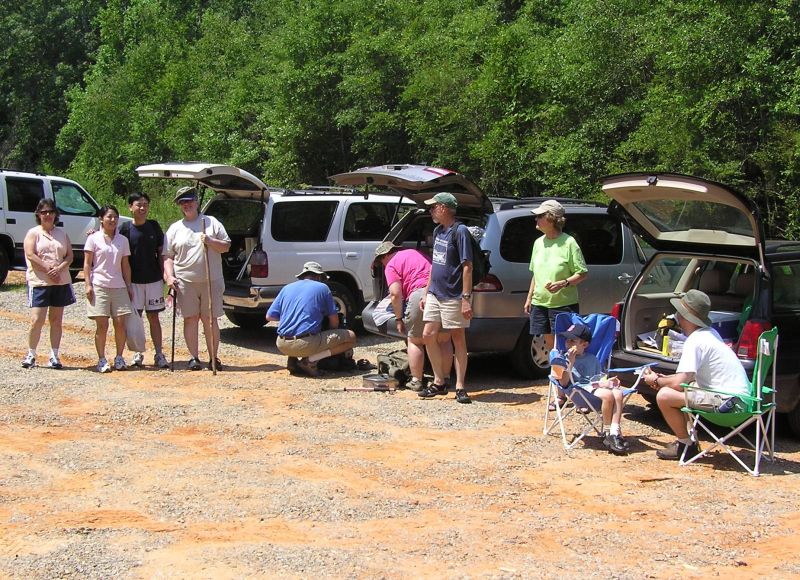
The group picture, hey, what can I say? We were late, hot, and hungry!
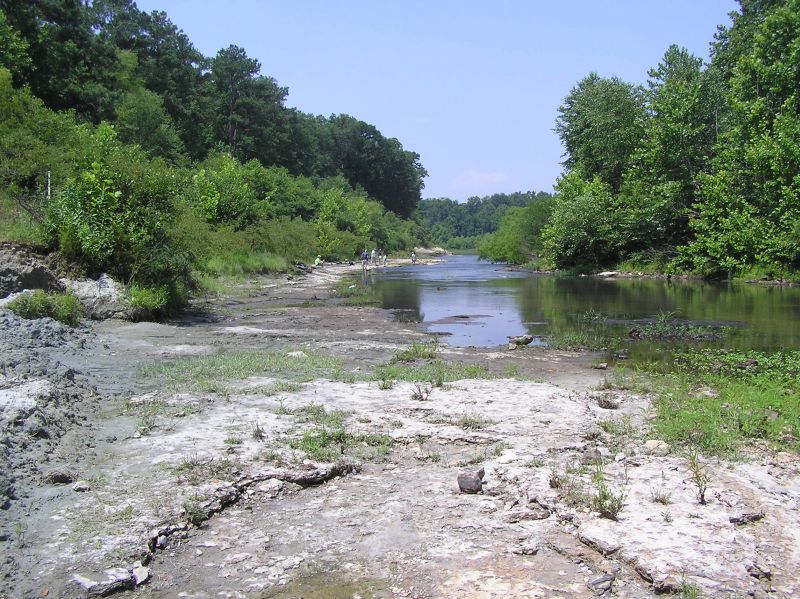
Very low water level today.
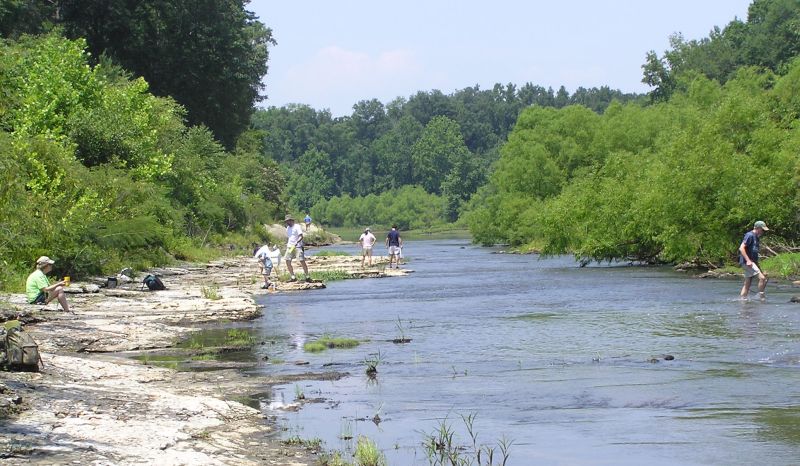
Members hunting for the best collecting spots - the river is quite shallow here.
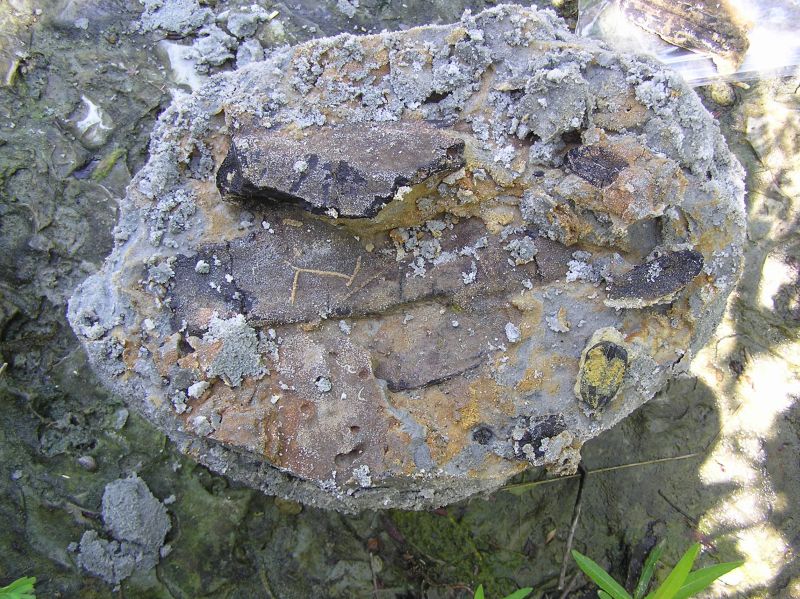
Jan found several pieces of petrified/ permineralized wood, and what appears to be a nice seed pod.
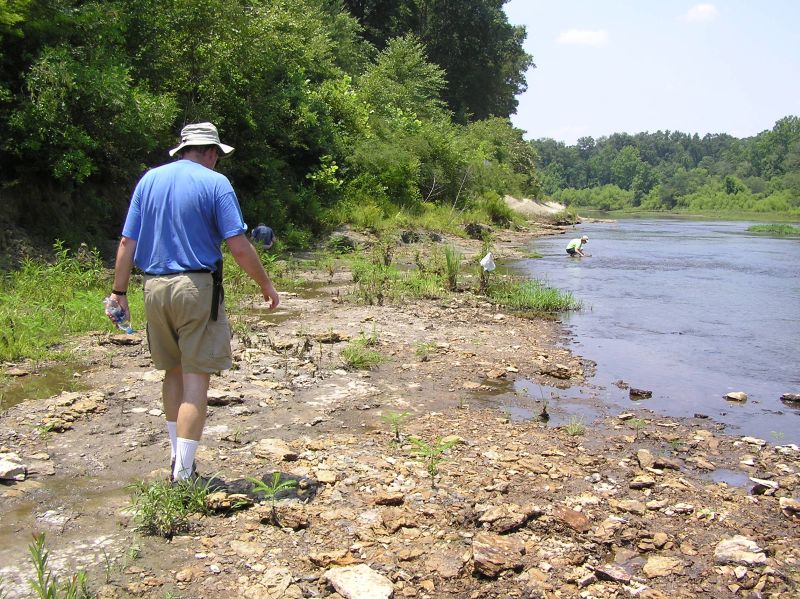
Jan heading downstream, surveying areas that are normally covered with water.
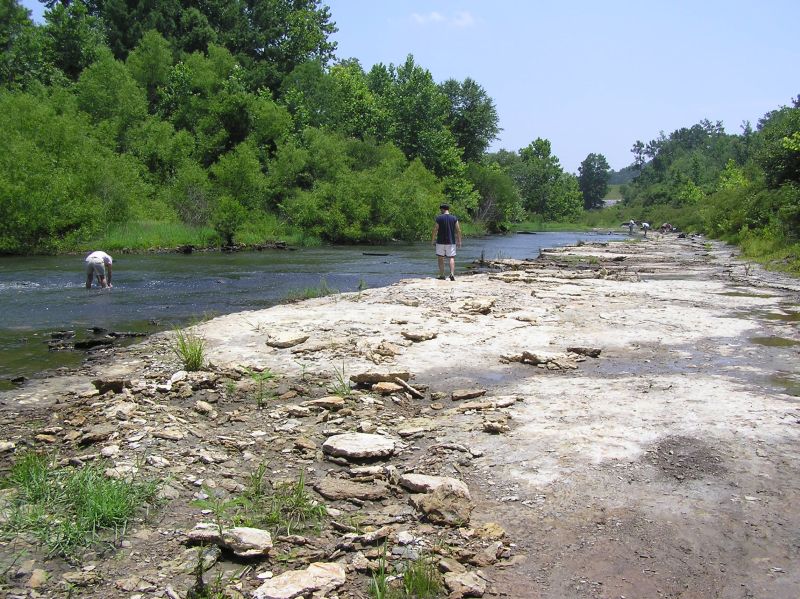
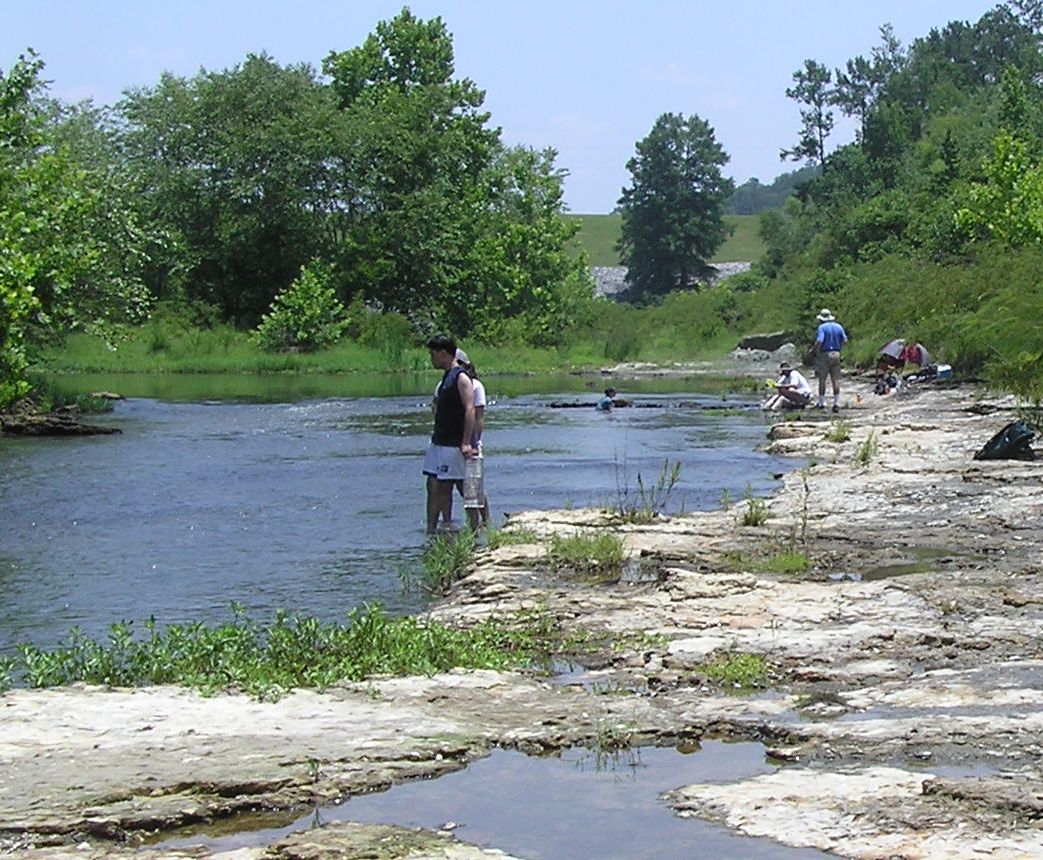
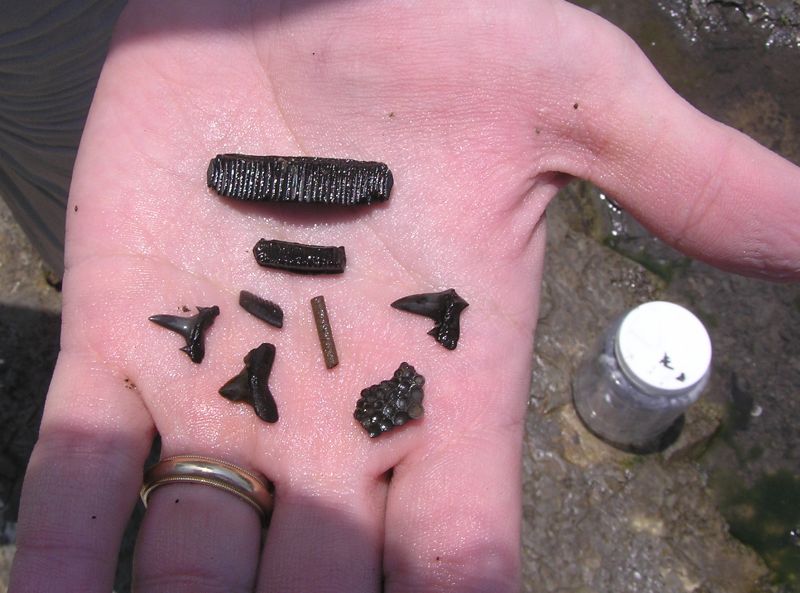
Sample of the fossils found at this site.
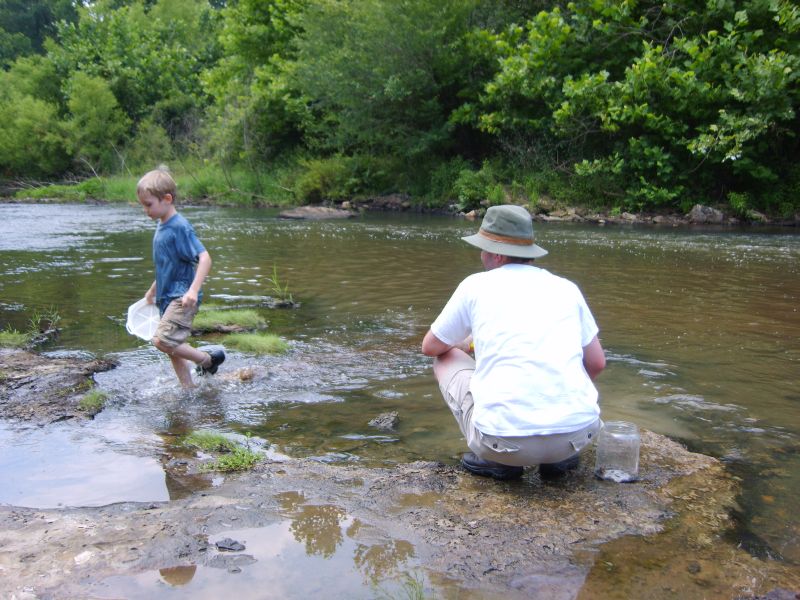
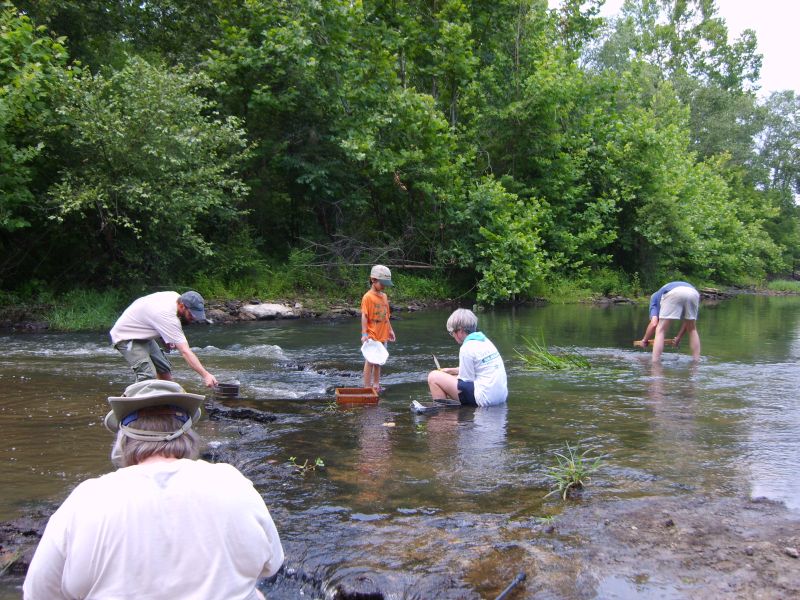
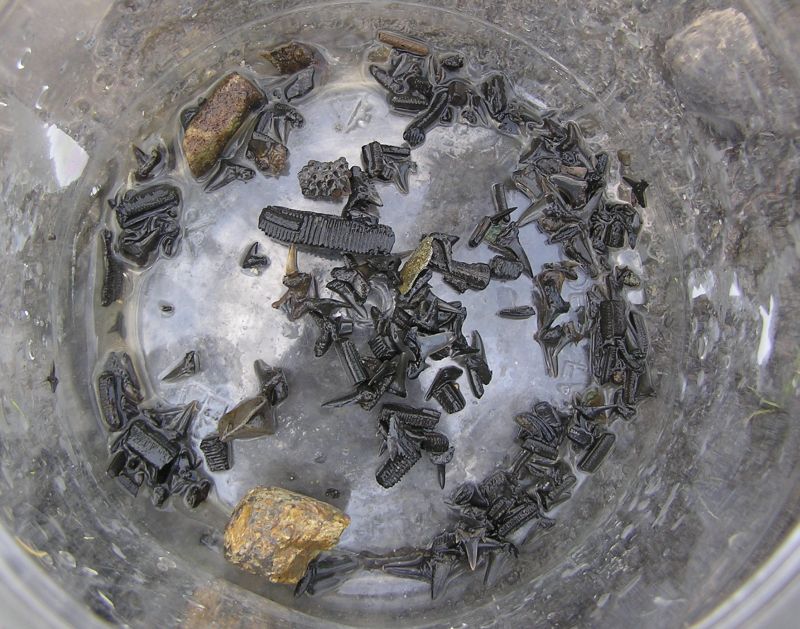
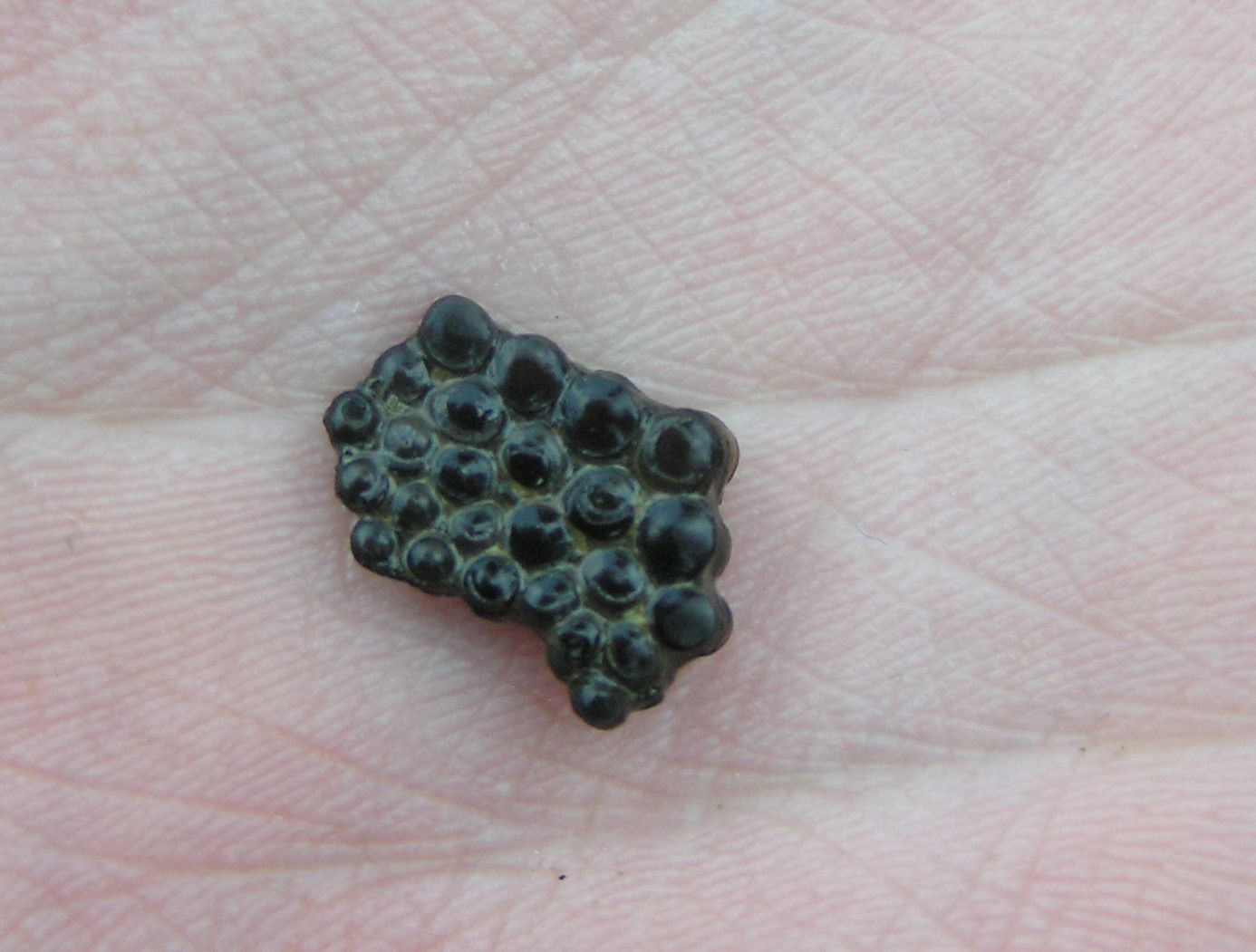
Drumfish mouth plate.
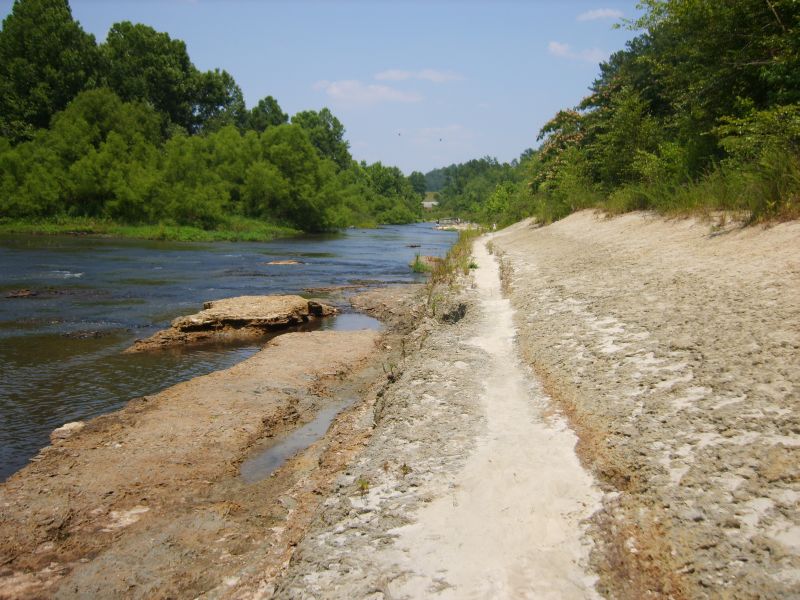
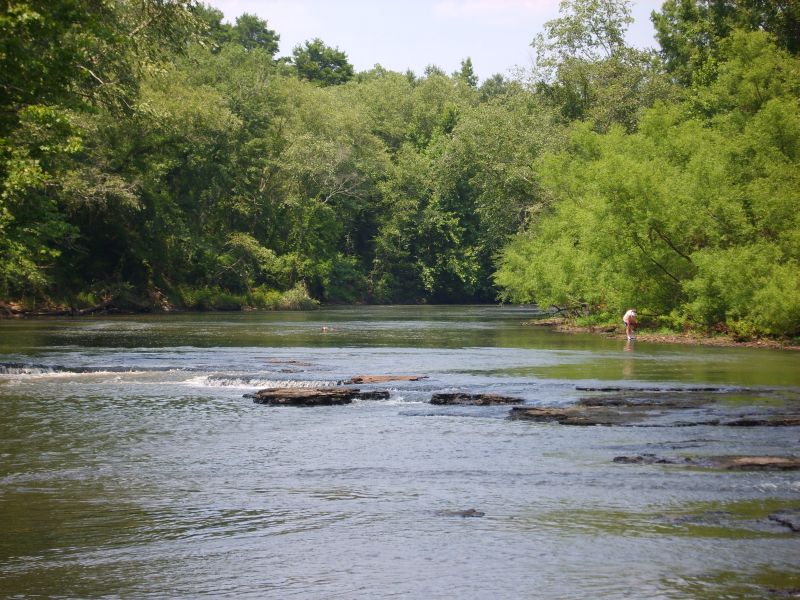
The river is low enough to expose this small waterfall, where, rumor has it, Claire and Becky engaged in a water battle.
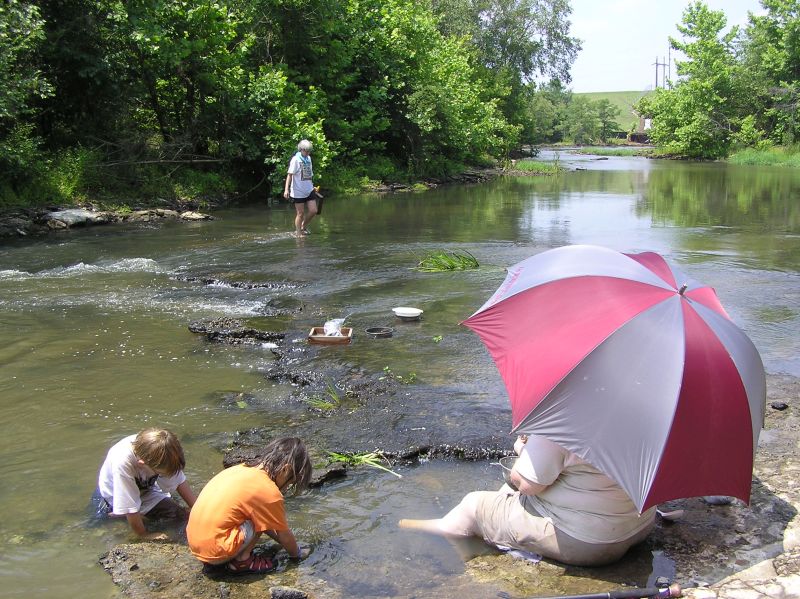
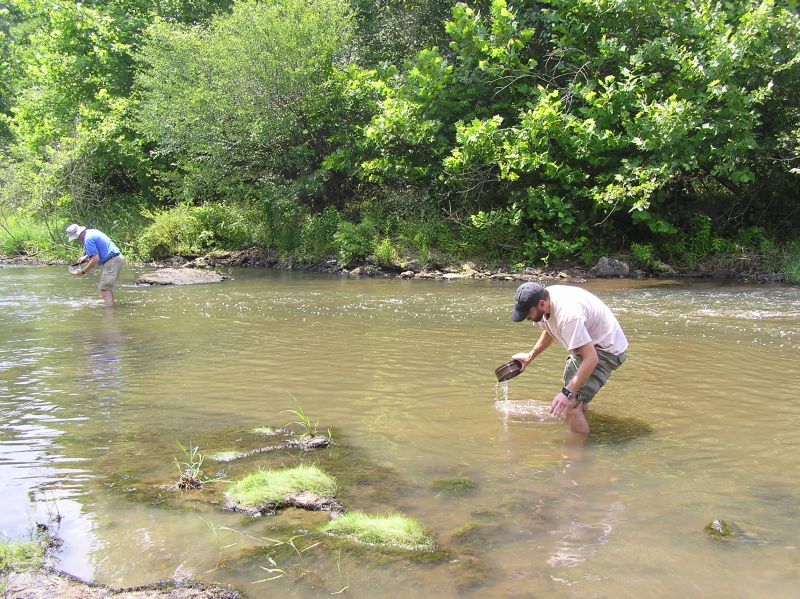
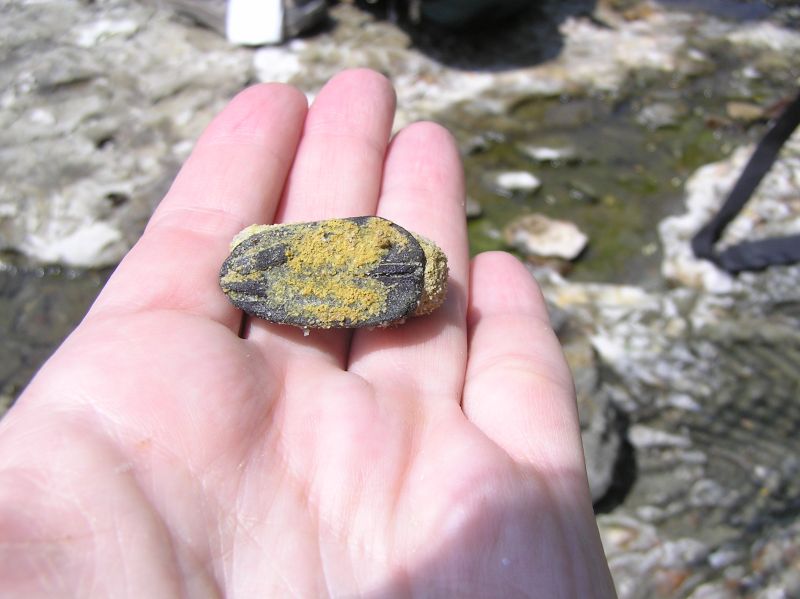
Good view of the seed found by Jan.
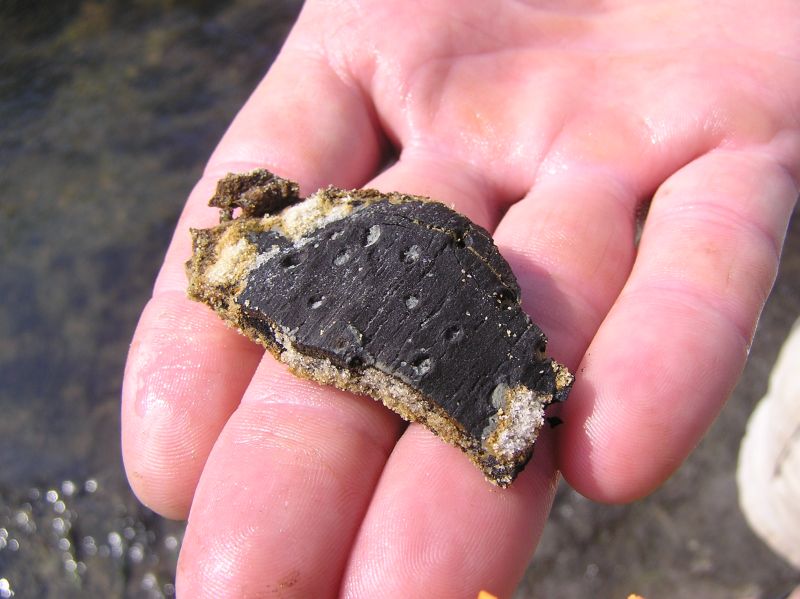
Wood found by Jan.
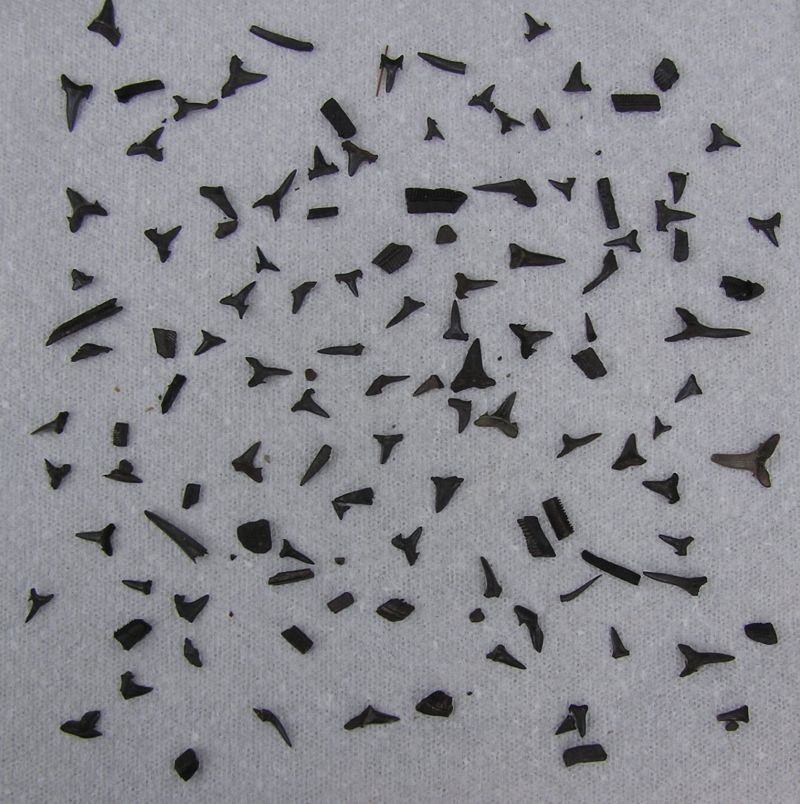
That evening at camp, we spread out our finds for the day.
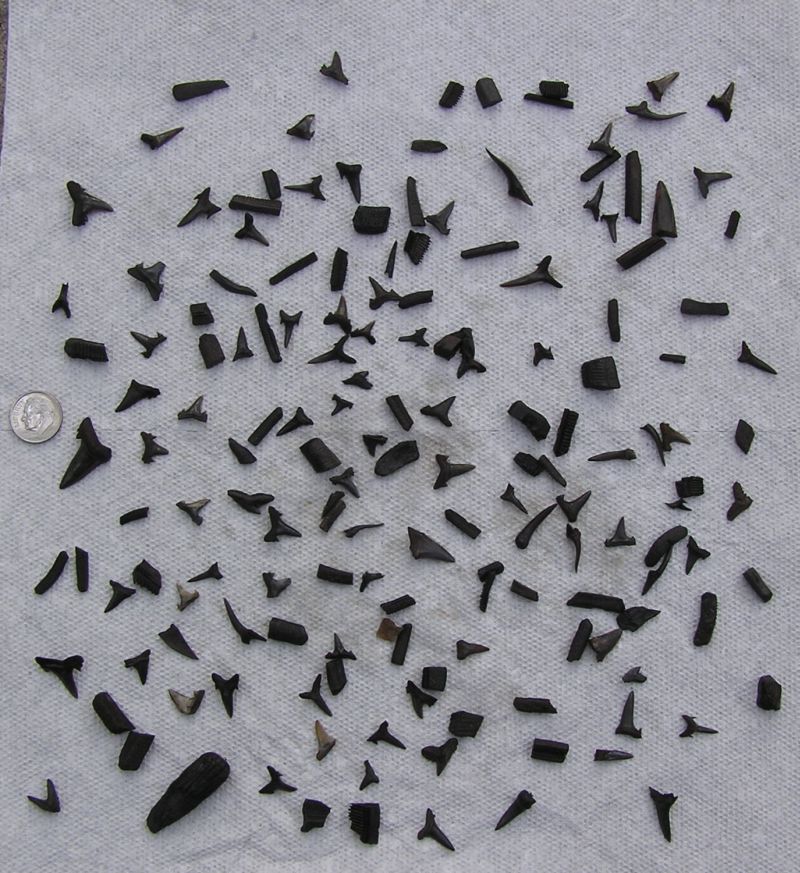
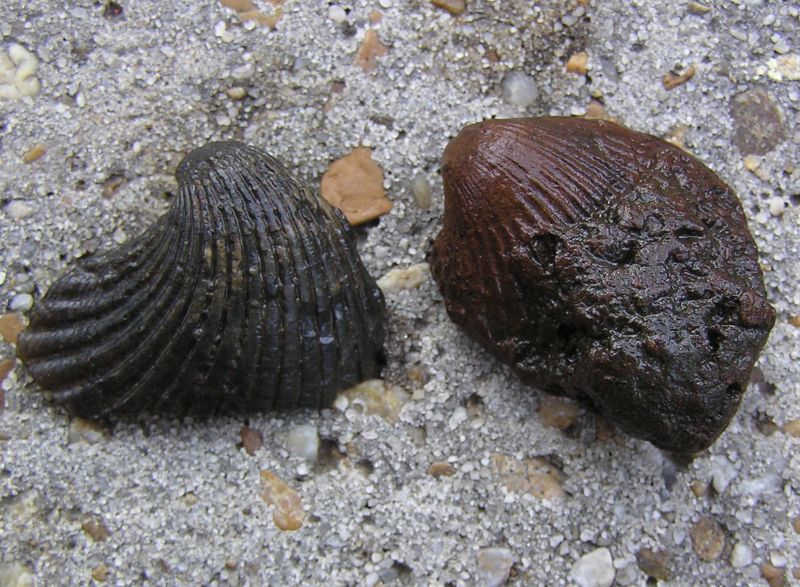
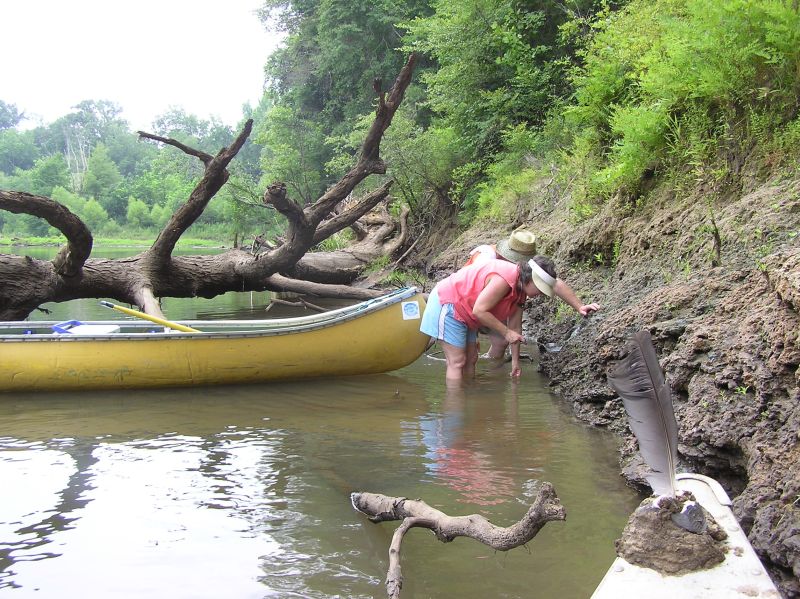
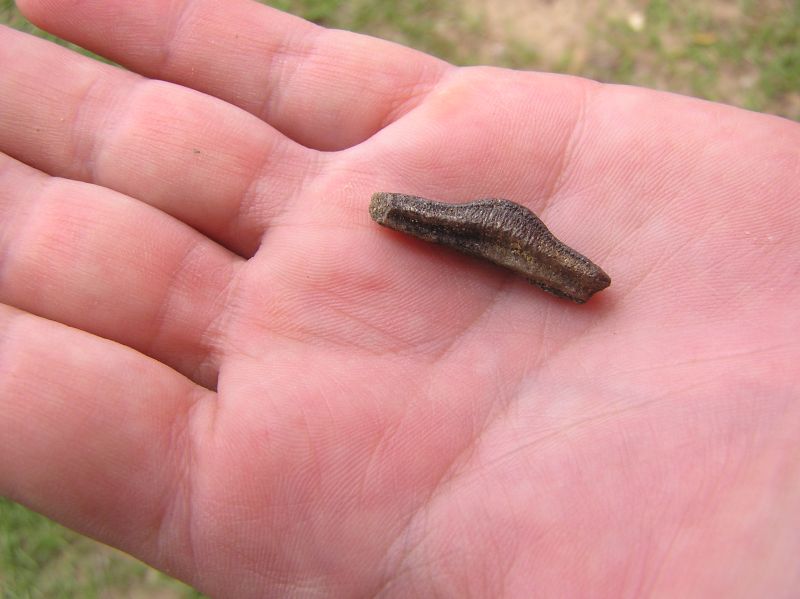
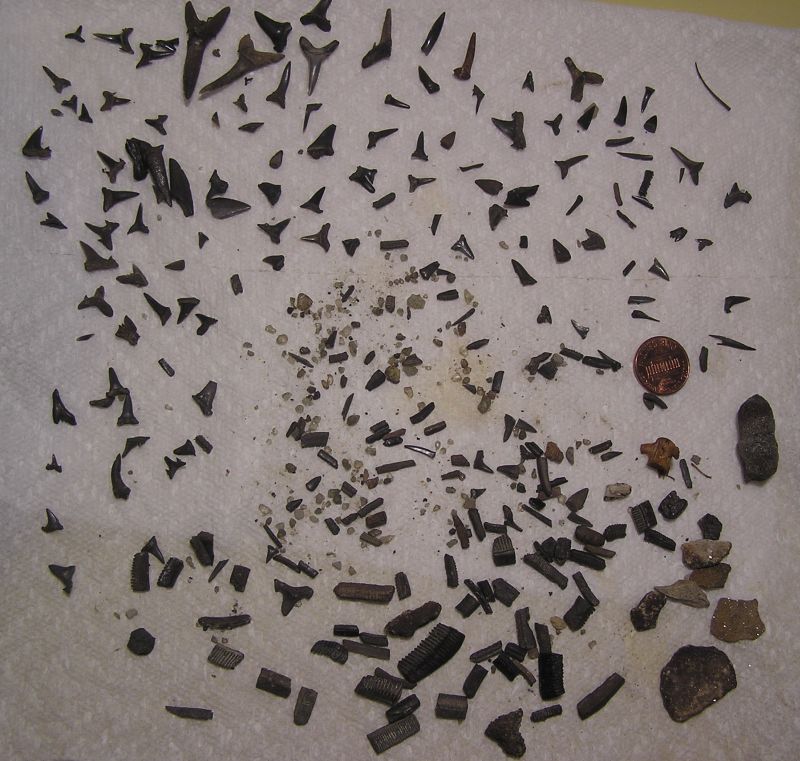
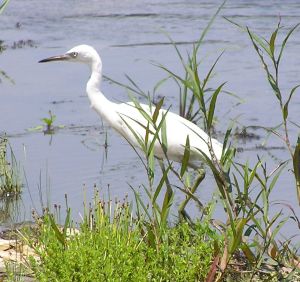
Everyone met at a central location, and a brief introduction to the geology of the area was given before driving about 12 more miles to the entrance to the site. While past trips to this location have found the entrance roads to be very slick from rain, this years access was dry and easy. The entire caravan was able to drive to the limestone hilltop parking area.
The fossil hunting started the moment you exited your car with small gastropods and segments of large ammonites being found on the cleared hill top. The trail down to the creek provided more ammonites.
The creek was beautiful with white quartz sand beaches at many of the bends. Shark teeth, ray teeth, fossil bone, ammonite pieces and nautiloids were found in the gravel bars, along with numerous non-fossilized bones and teeth from various mammals. Some of the more interesting finds were various human artifacts rather than fossils. Indian potshards, some with incised decorations, a couple of projectile points and an Indian pipe, probably of European origin, were found.
The end of the day found the diehard fossil hunters resting at the beach where the trail intersected the creek. The Novaks organized a fire on the beach to roast small sausages, while others brought snacks to contribute, and the Stewarts returned to the parking area to set up camp for the night and fix their dinner.
By dark, everyone headed home, leaving Pam and Bob to enjoy a pleasant night at the site with owls hooting and Whip-poor-wills calling. At daybreak turkeys could be heard at the tree line adjacent to the camp area. After a couple of hours of walking the creek on Sunday morning the Stewarts packed up and reluctantly left the site, letting it return to nature.
(Photos courtesy Jan Novak, Bob Stewart, Becky Guthrie, and Vicki Lais)
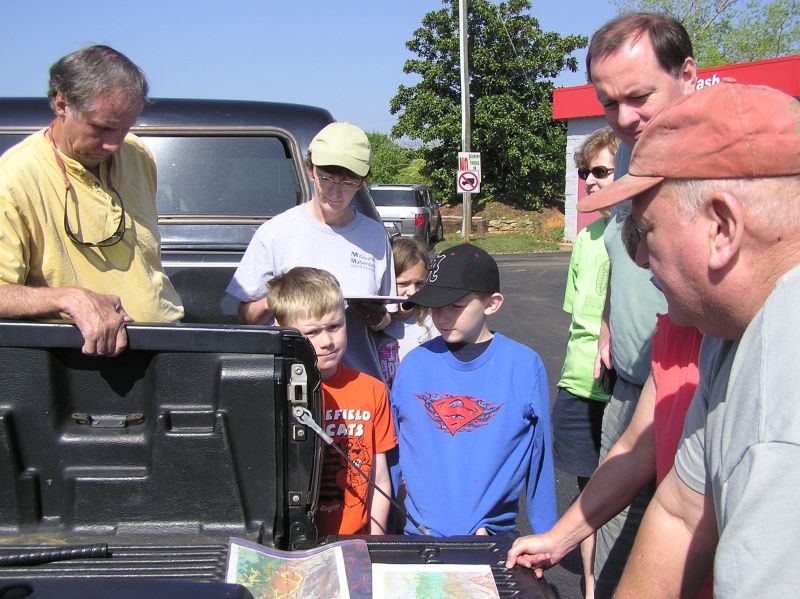
Vice President Greg gives an overview of the geology of the site and collecting rules.
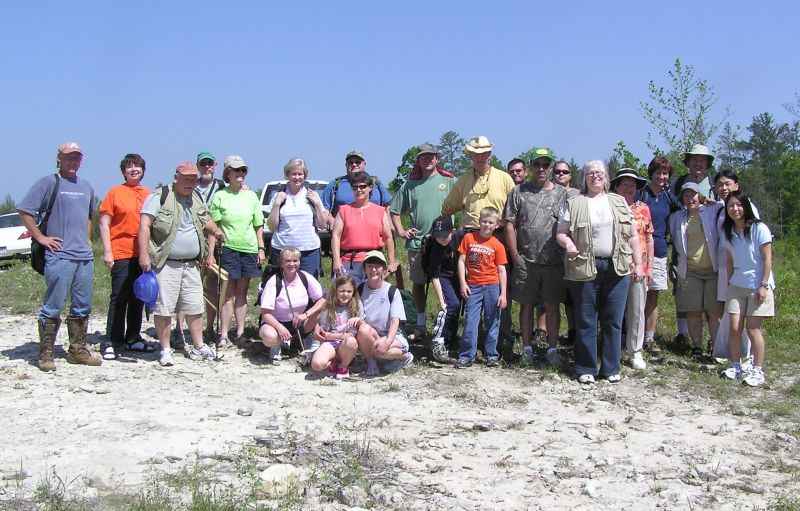
A lot of excited people showed up for the field trip - fossils can even be found on the limestone earth in the foreground.
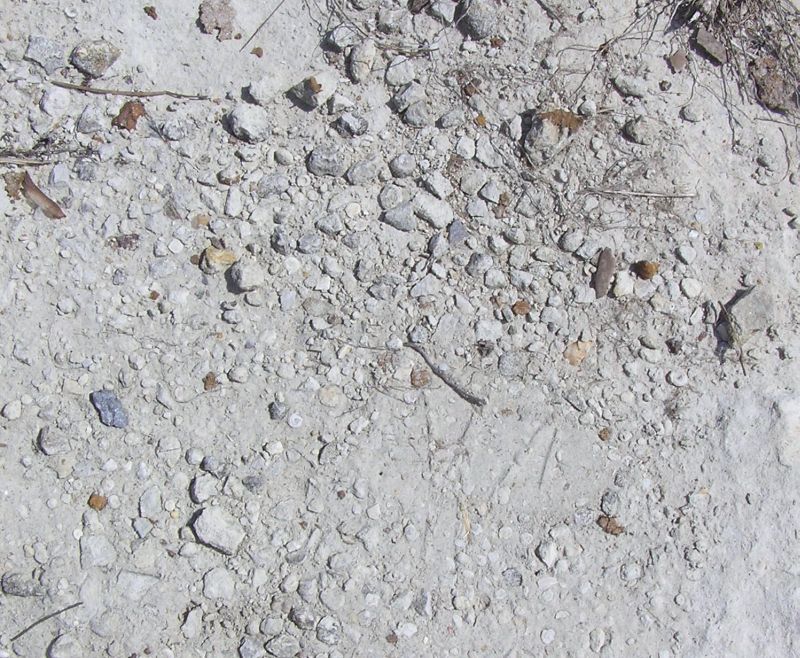
If you look carefully, you can spot tiny round gastropods, each approximately 3/8 inch across.
Hiking down to the creek from the parking area (and of course, looking for fossils along the way!)
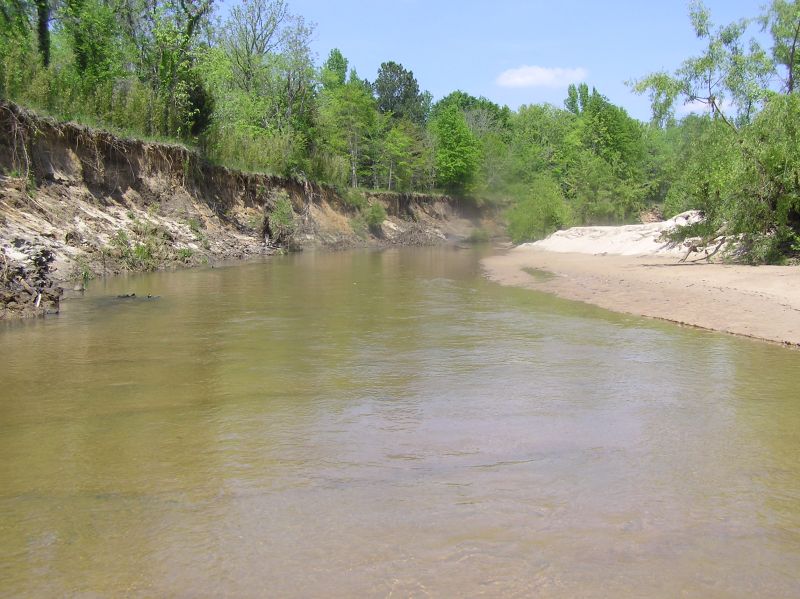
The creek was higher this year than normal, but there were still numerous gravel bars.
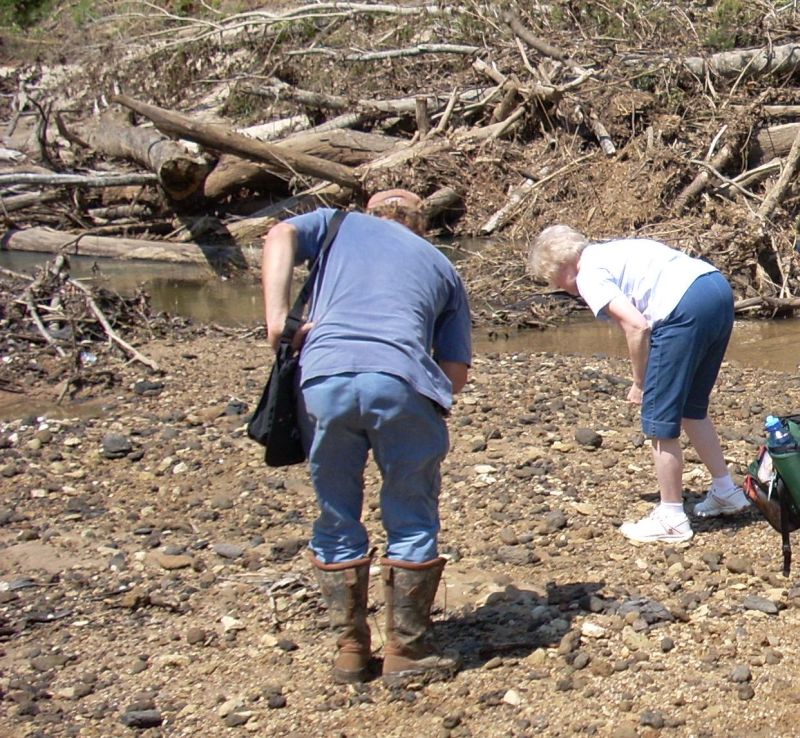
A recent storm had washed up a huge pile of brush and trees, and left behind rocky rubble and mud rather than the white sand we normally find.
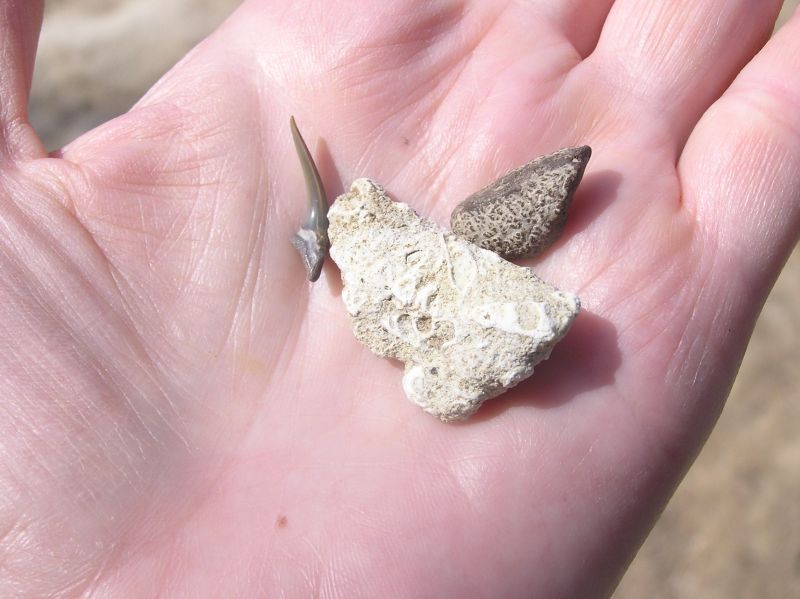
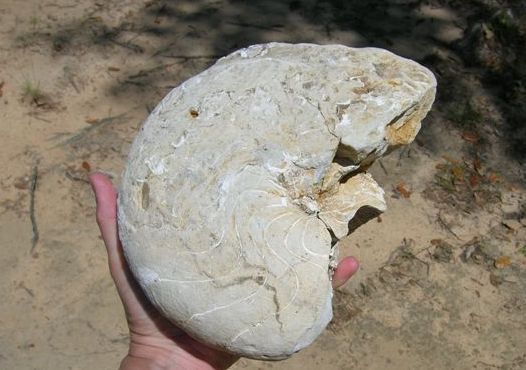
Nice nautiloid found by David.
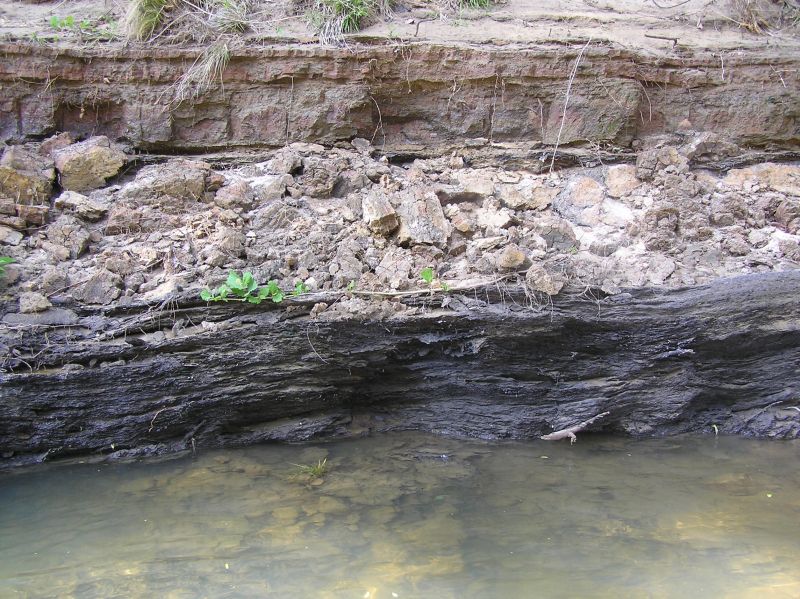
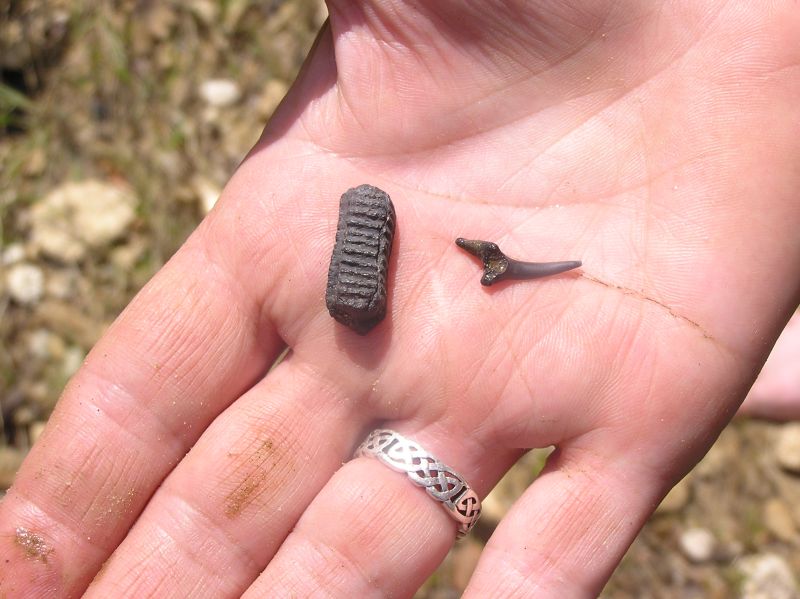
Ray tooth and shark tooth.
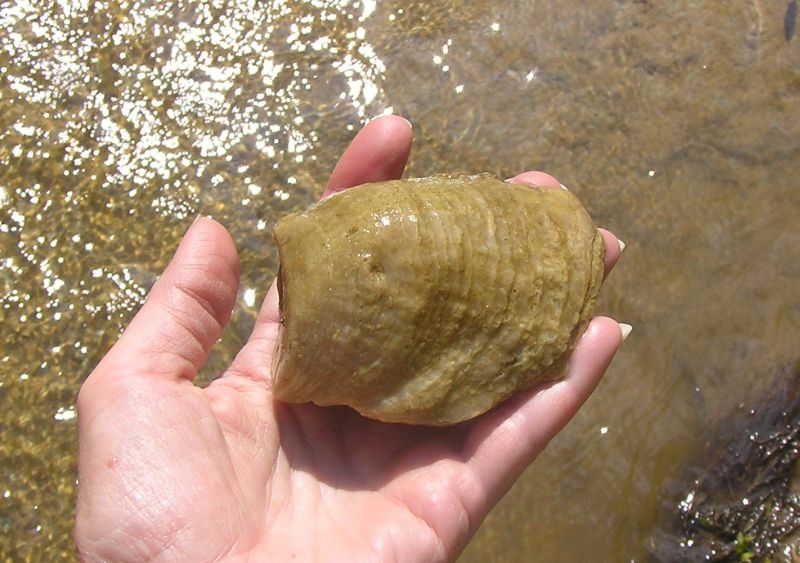
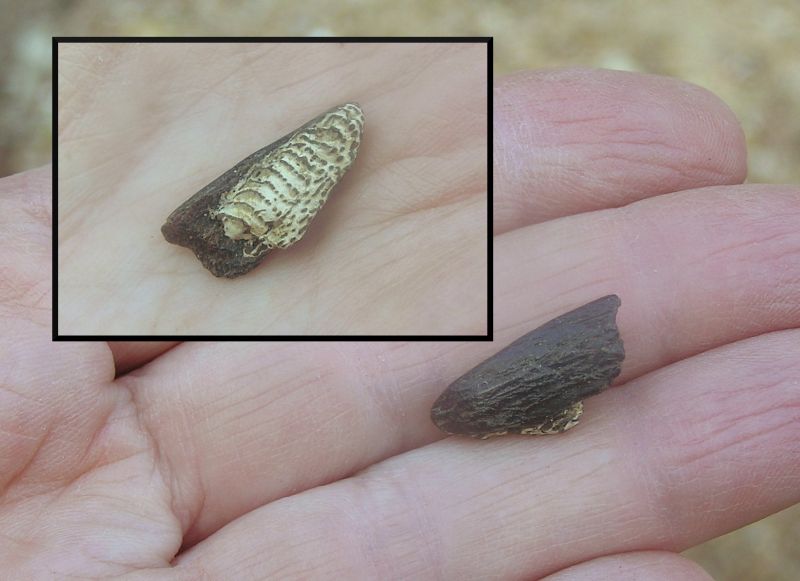
Unknown item, can anyone identify? Looks kind of like a tooth. . . .but . . . .
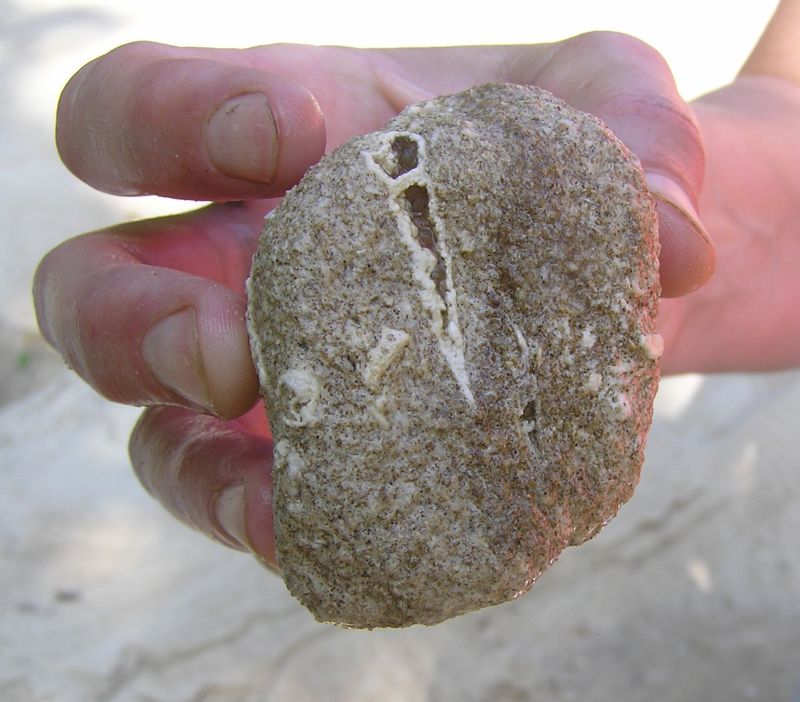
Nice turritella in coquina.
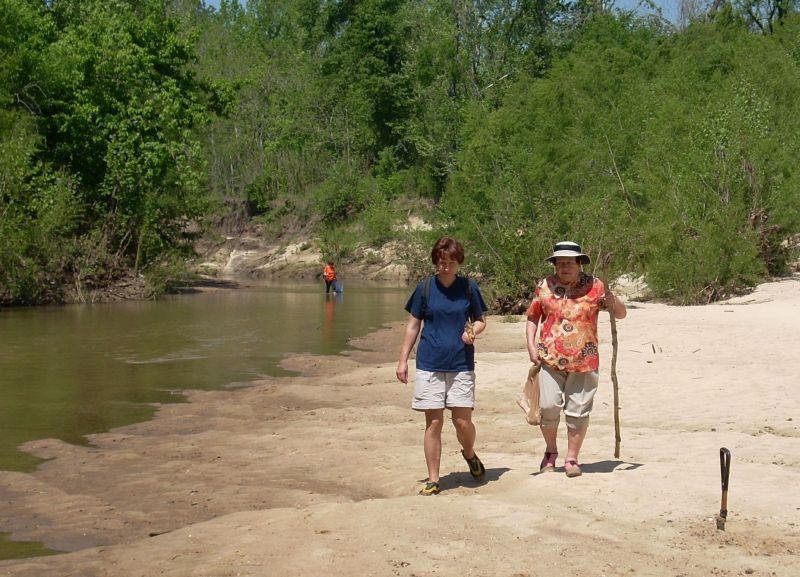
Lea's mom was visiting from the Czech Republic, and decided to join us for the fun!
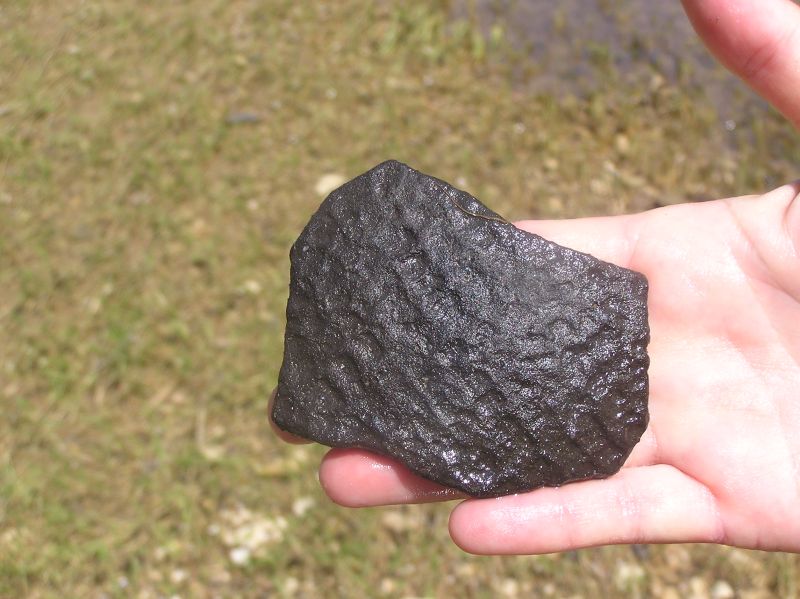
Shells in matrix.
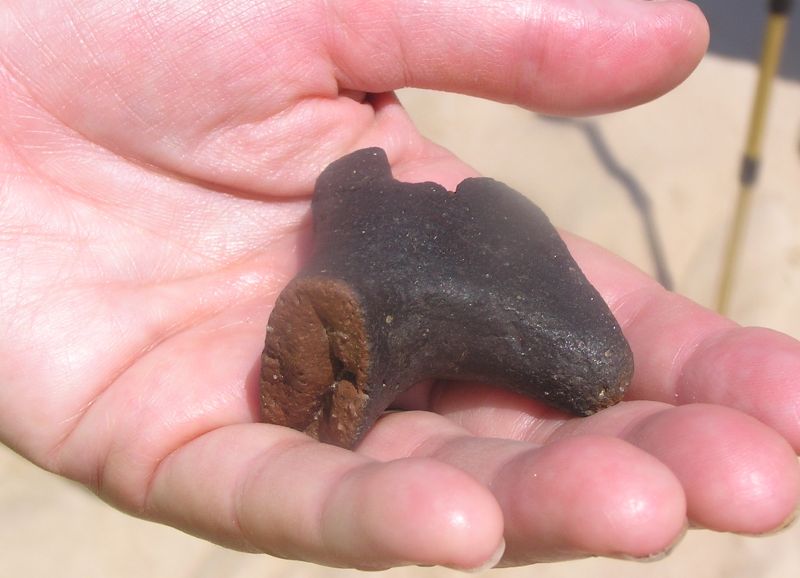
Probably a pottery handle.
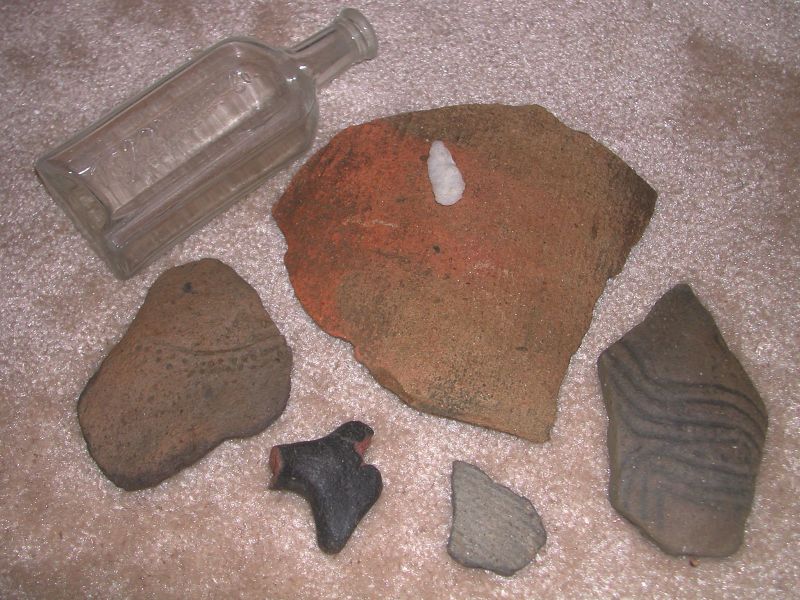
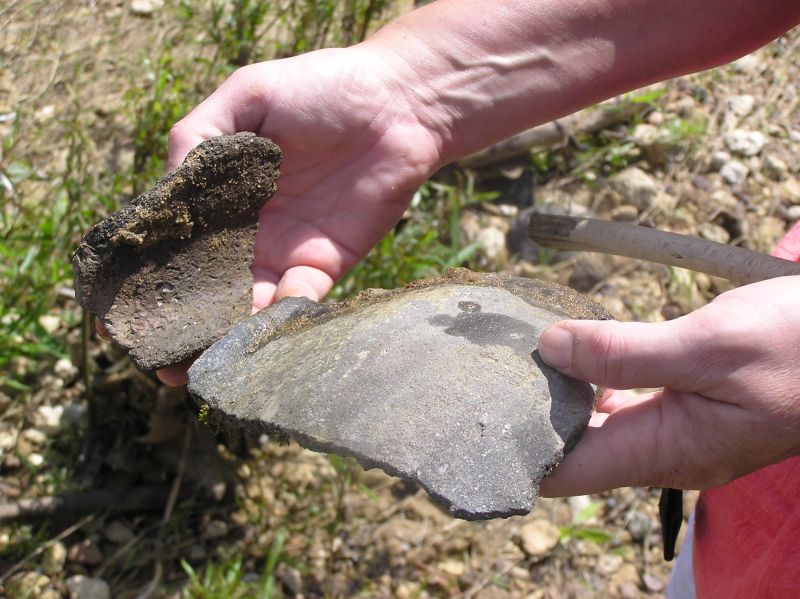
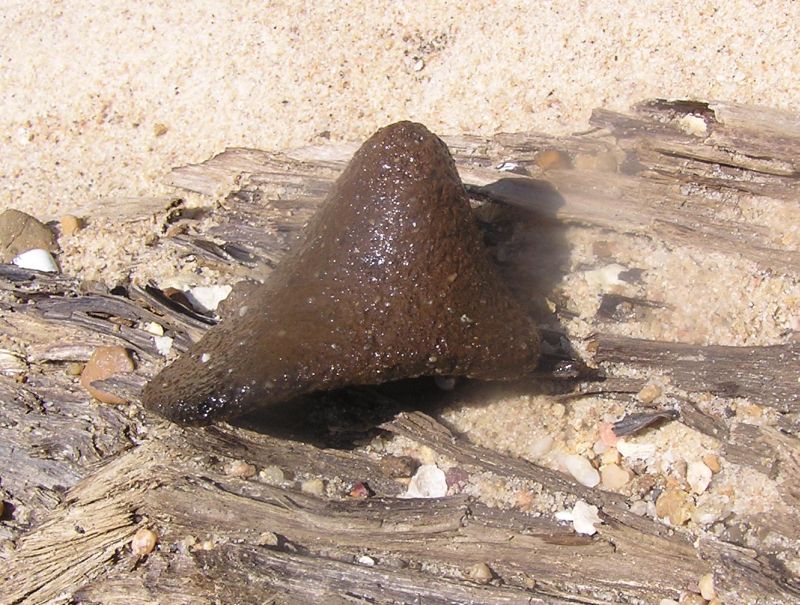
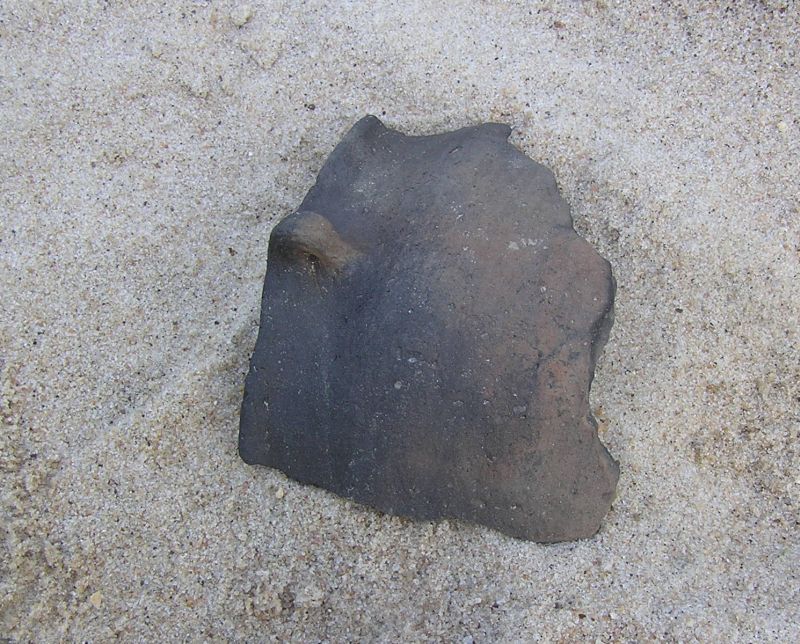
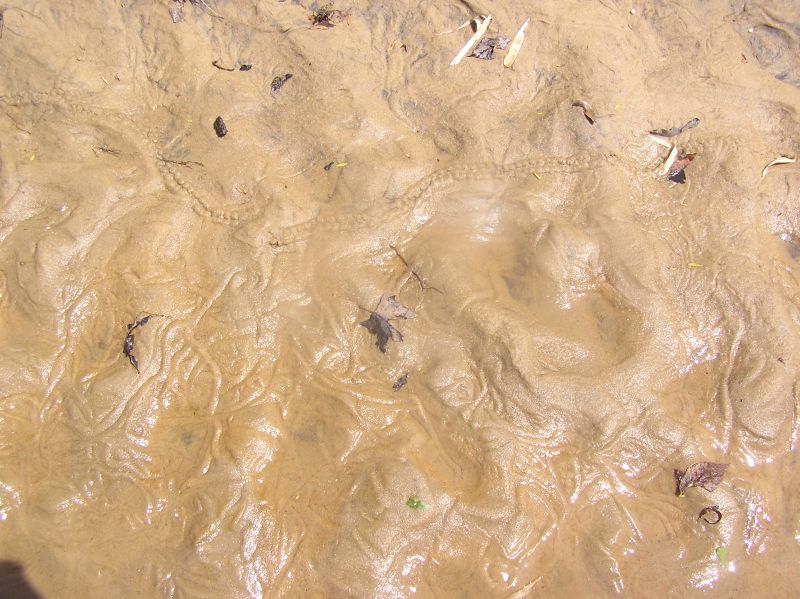
Worm tracks in the sand. Fossil worm tracks much like these are found in shale in north Alabama.
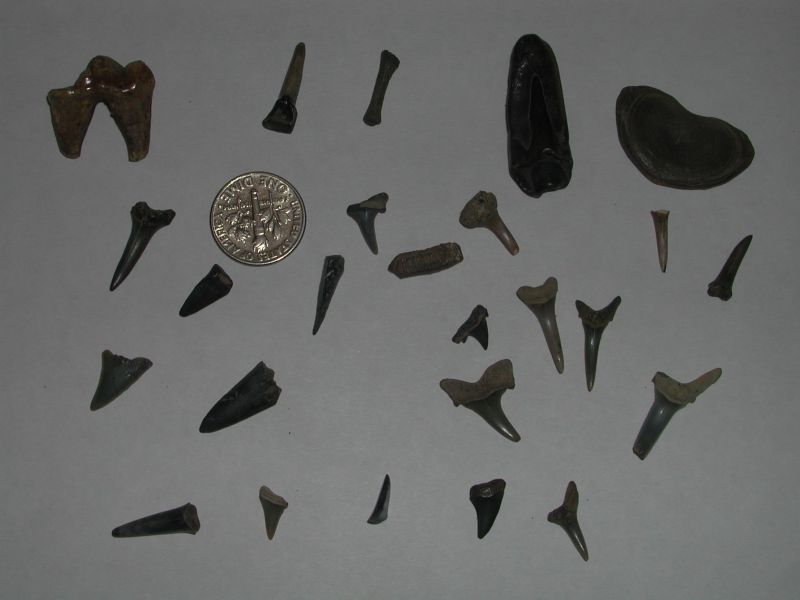
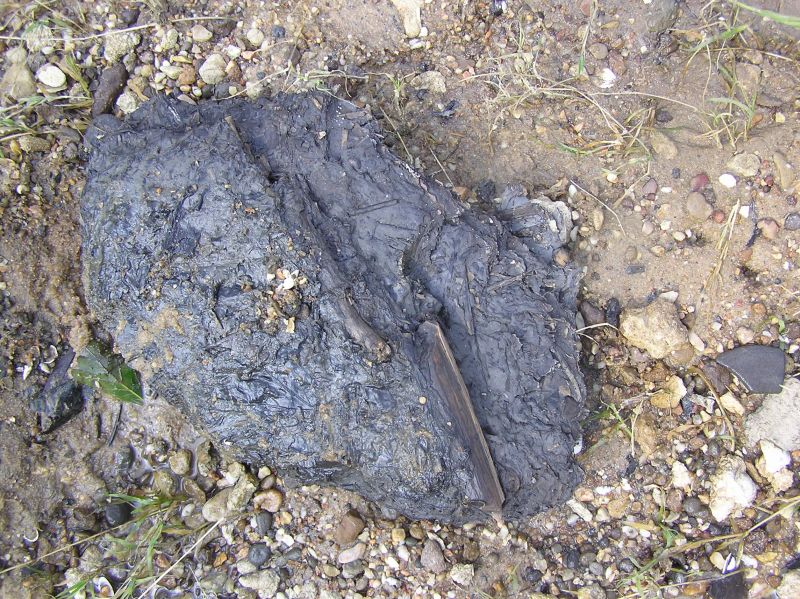
Numerous clayballs were found in the creek. This one shows bits and pieces of plant debris. The finder did not examine it closely to determine whether these were fossil leaves or recent, however, based on the geology of the area, they could easily be cretaceous fossil remains.
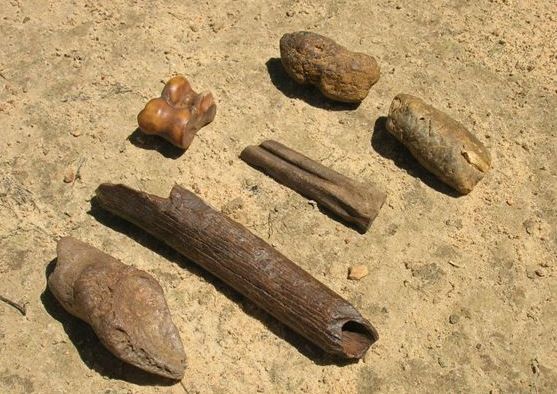
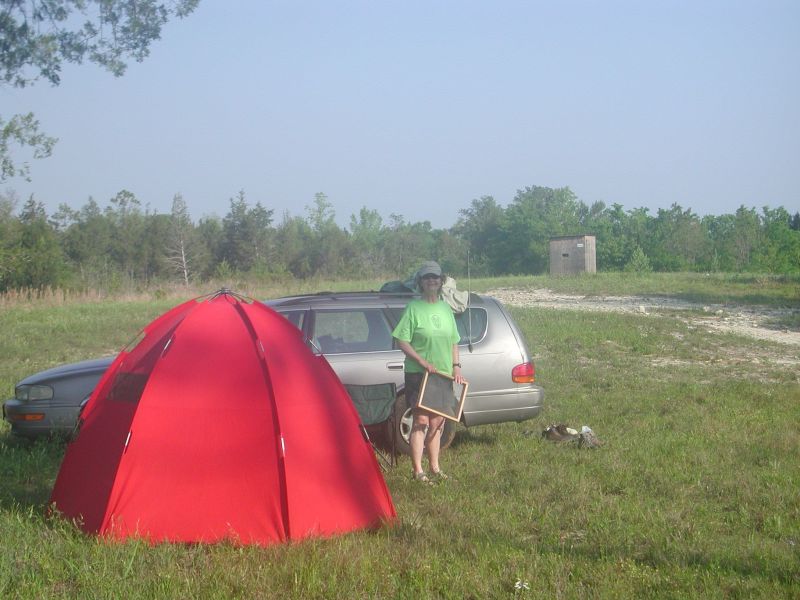
While Bob & Pam set their tent up . . .
The others built a fire and enjoyed the evening.
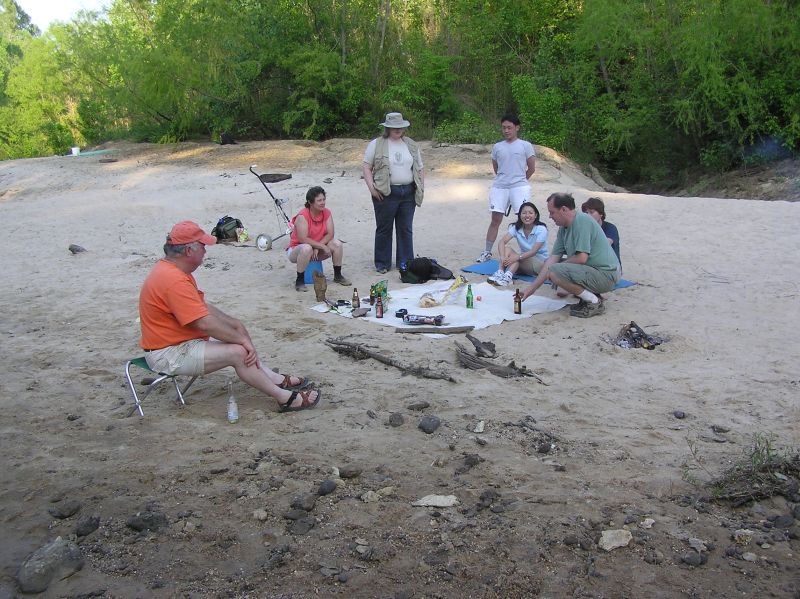
The campfire has about died out as some of the diehard fossil hounds hang out wringing that last little bit of enjoyment from the day!
Today BPS went way down south to Clarke County, Alabama. We were quite excited because this was a new site Steve found, and we were chomping at the bit, ready to go. We found a good variety of bivalves and gastropods, a few shark teeth and ray teeth. The most numerous fossil we found is Flabellum cuneiforme pachyphyllum, a type of coral from the upper Lisbon formation. This is unlike any corals we have collected in the past, as it has a flattened shape, as if someone took a horned coral and squashed it. Some were tinted a pinkish color, which made them easy to spot in the mostly white matrix. At least one specimen of Endopachys maclurii was found (looks similar to the flat one, but has two bumps on each flat side), and several very tiny round specimens of Discotrochus orbignianus were found. (Specimens from this site are very fragile, and should NOT be placed in a bucket of water to clean, as they will crumble. Even the ones that look thick and solid. Brush them off dry, or very lightly wet them, then put them where they can air dry, perhaps on a wire screen.)
Later in the day we headed to Wilcox County, Alabama, to some huge road construction rubble piles. These rocks were from the Paleocene, Midway Stage. Several nice nautiloid casts (Hercoglossa ulrichi) were found at this site, as was an extremely nice vertebra, which has not yet been identified. The nautiloids are made of compressed sand, and the actual shell has disintegrated. Though they are very heavy and appear sturdy, if left exposed to the weather, or cleaned with water, they will crumble into a pile of sand.
Update: July, 2006 - on the trip, Martha found a large bone that appeared to some of us to be recent, as it was very lightweight; however, Jun Ebersole and James Lamb of the McWane Science Center asked to examine the bone, and determined it is from the only early whale of this species ever found in the state. The specimen has been sent to an early whale expert for study.
(photos courtesy Steve Corvin and Vicki Lais)
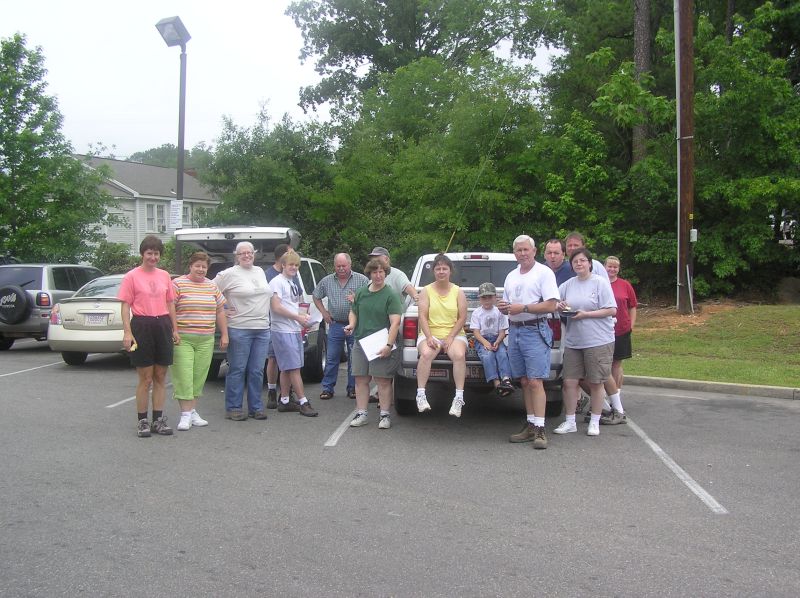
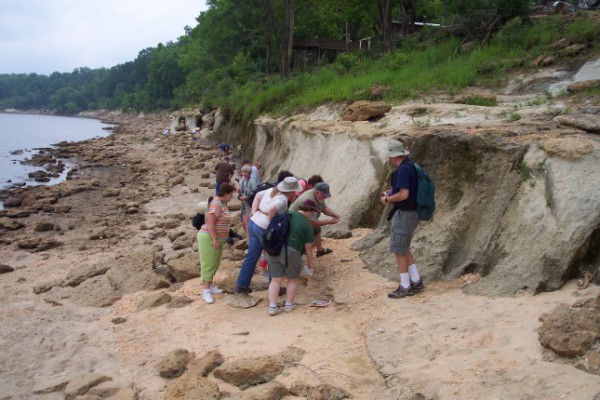
Greg is showing the group some specimens from this site - nice corals.
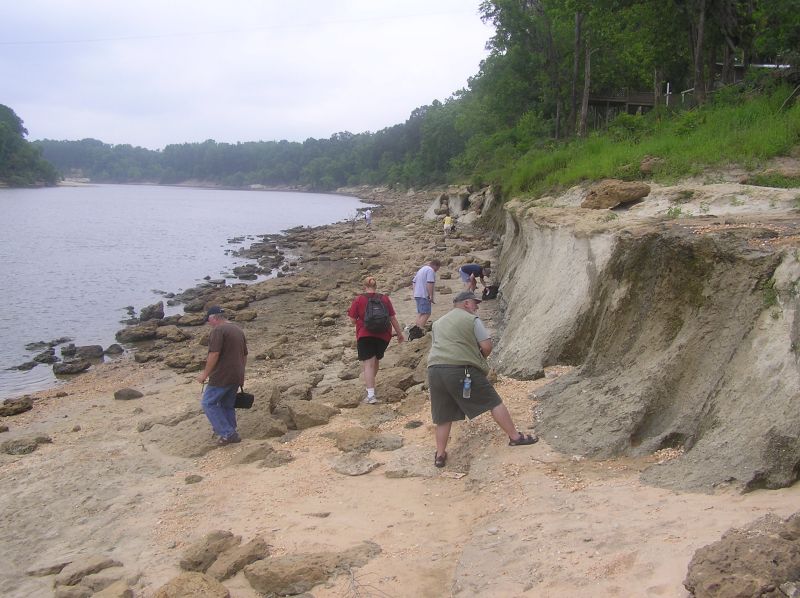
And the group scatters - the low water level makes hunting easy.
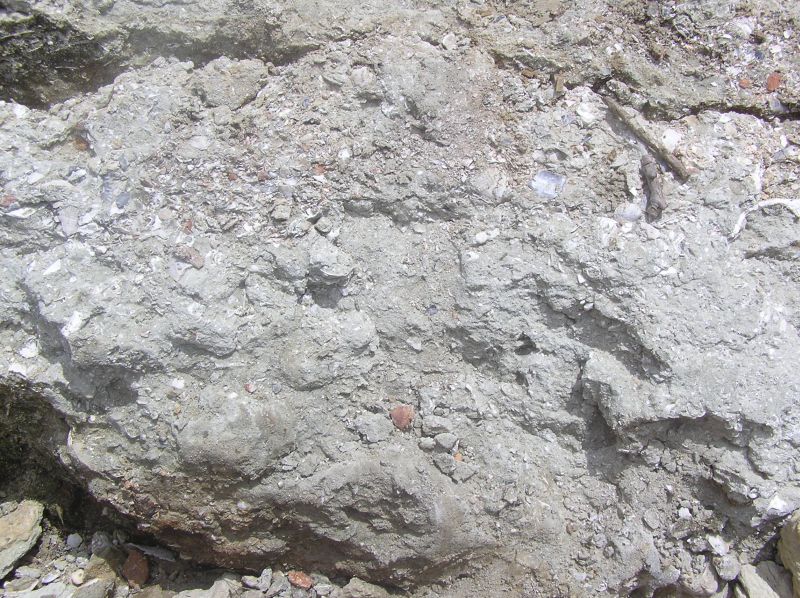
All the rocks at this site are filled with shells and corals. The trick is getting them out whole, as they easily crumble.
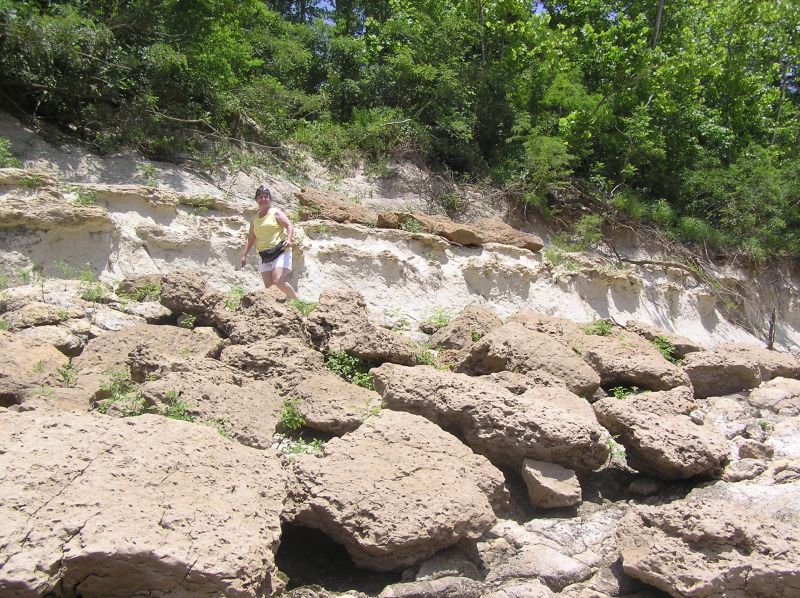
Becky is looking high . . .
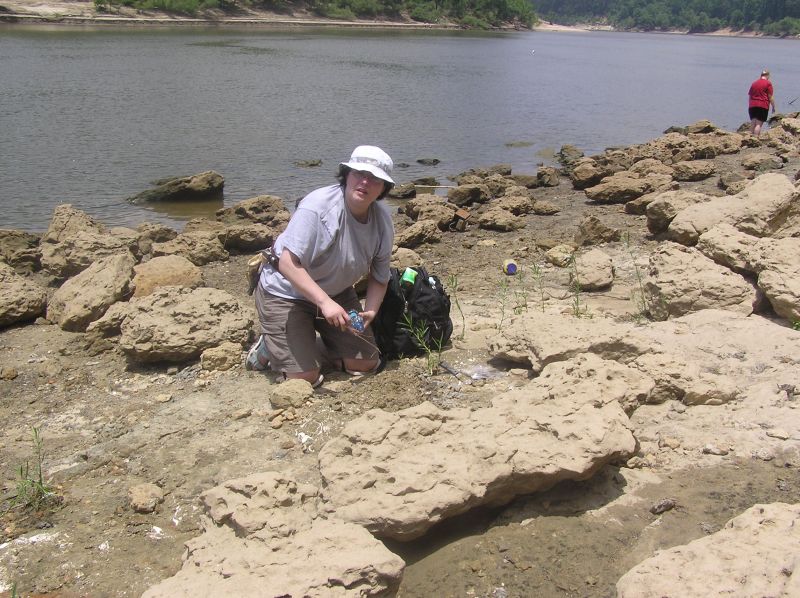
and Anca is looking low!
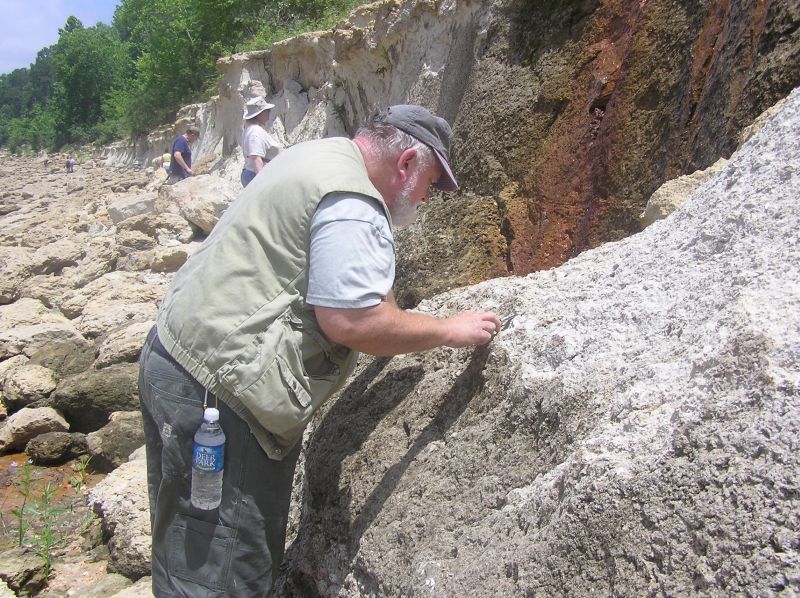
Greg carefully easing out a small coral.
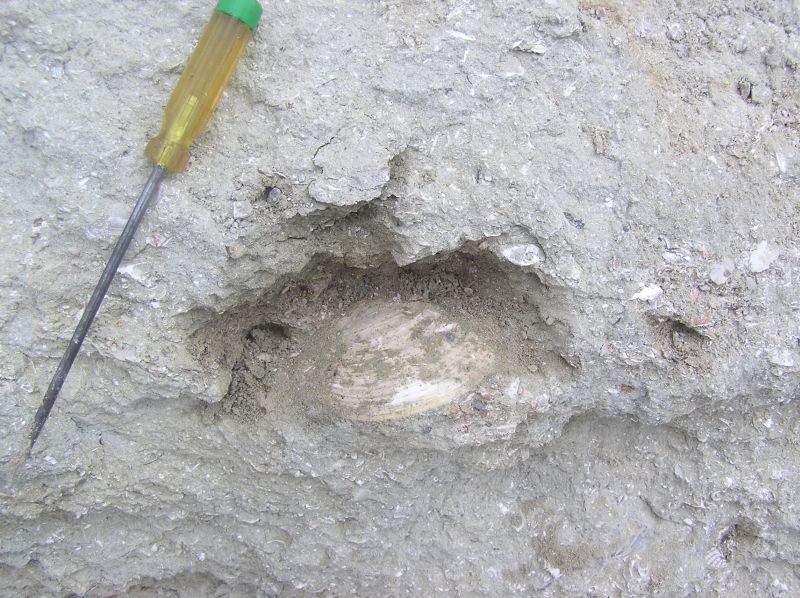
A nice bivalve found by Vicki.
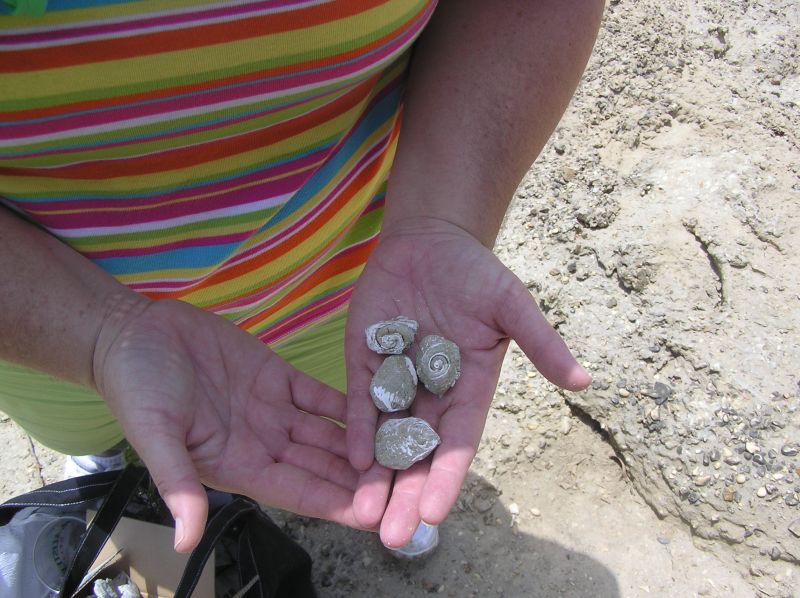
Nice gastropods found by Leisa.
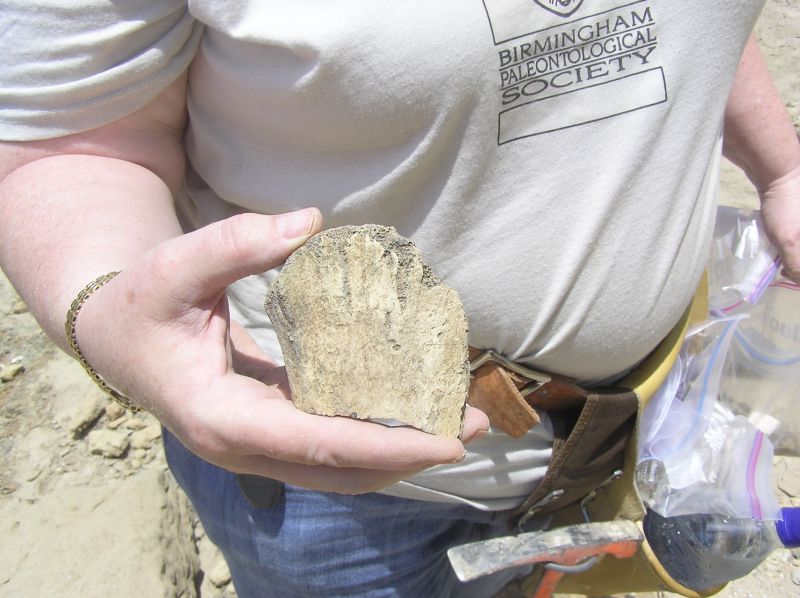
A large piece of bone found by Martha. According to James Lamb, it appears to be another bone fragment from an early whale found in this area. This specimen has been sent to an early whale expert for study.
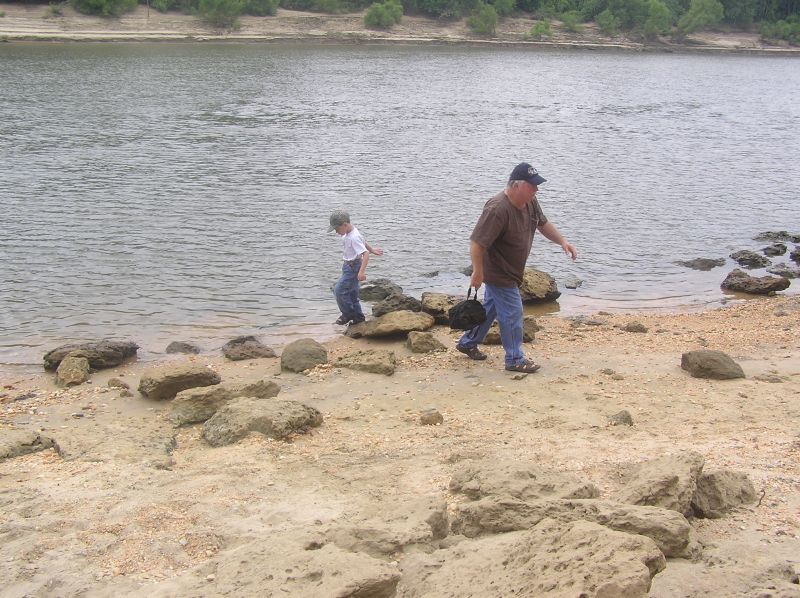
David is heading to another location. The corals and shells were found from the bluffs to the waterline, while Steve engages in his favorite activity, getting wet!
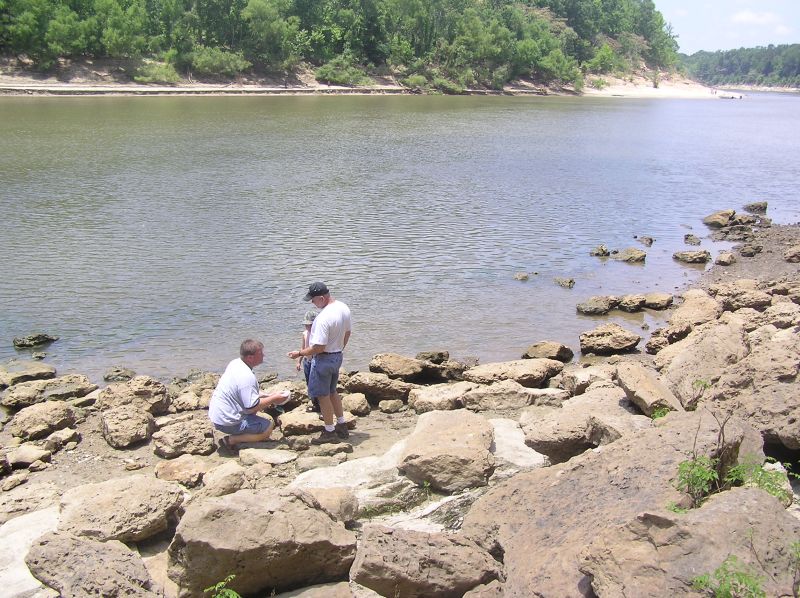
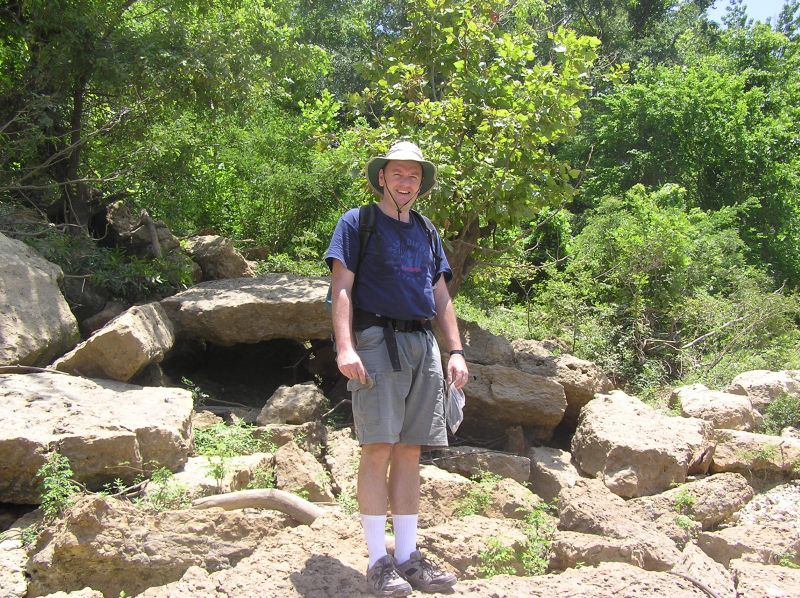
Jan, look over here!
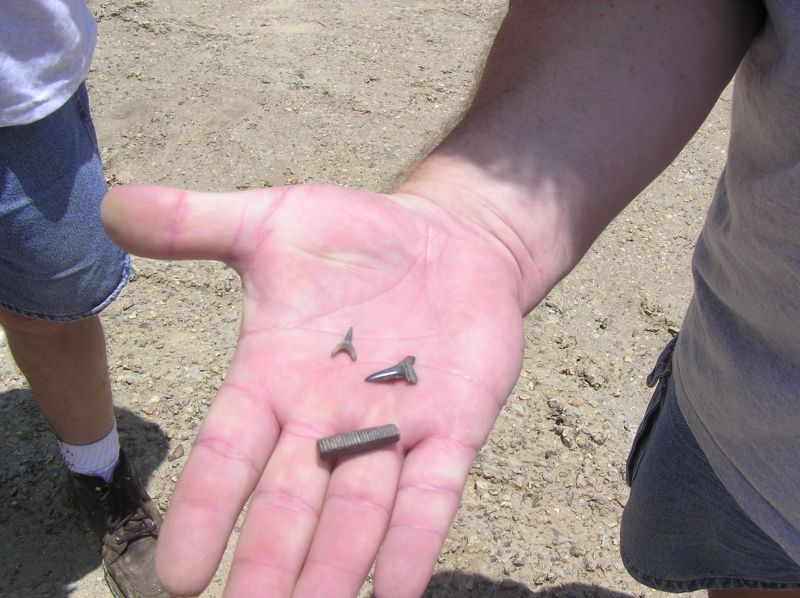
Shark teeth and a ray "tooth".
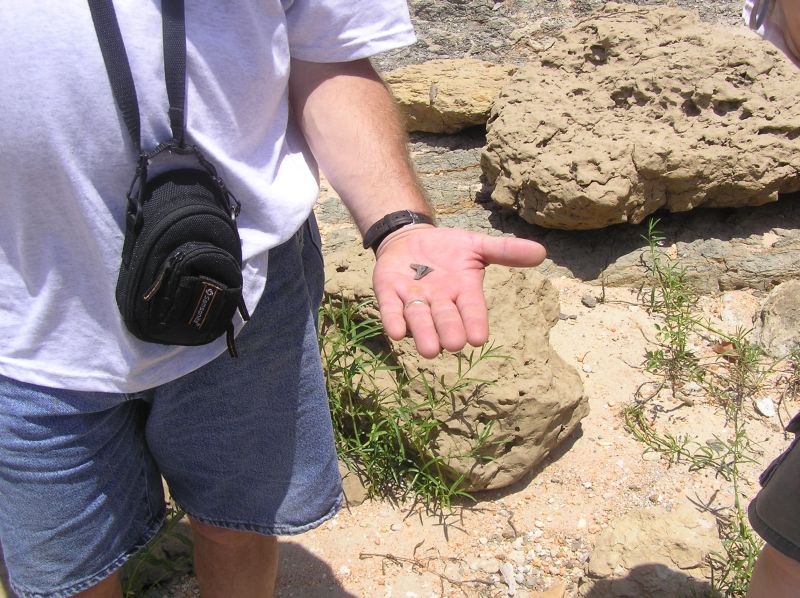
A nice larger shark tooth found by Steve.
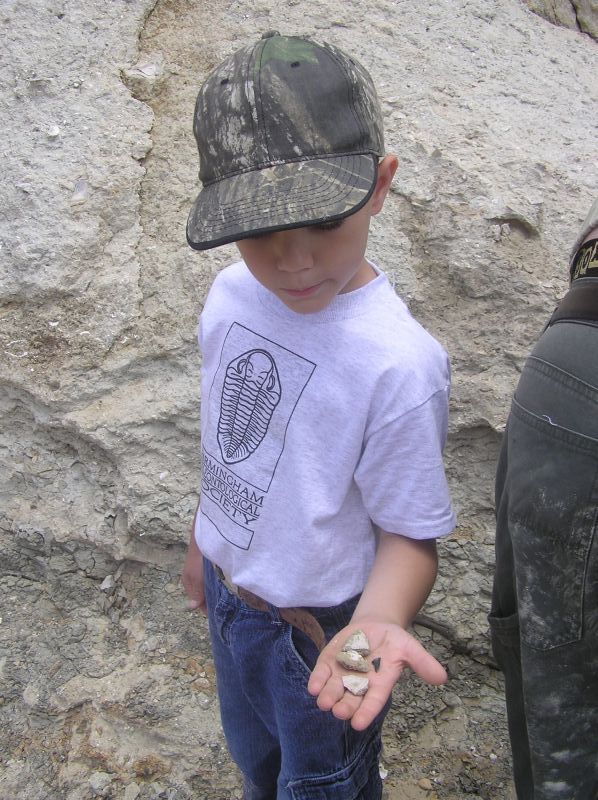
Steven has found coral and a shark tooth.
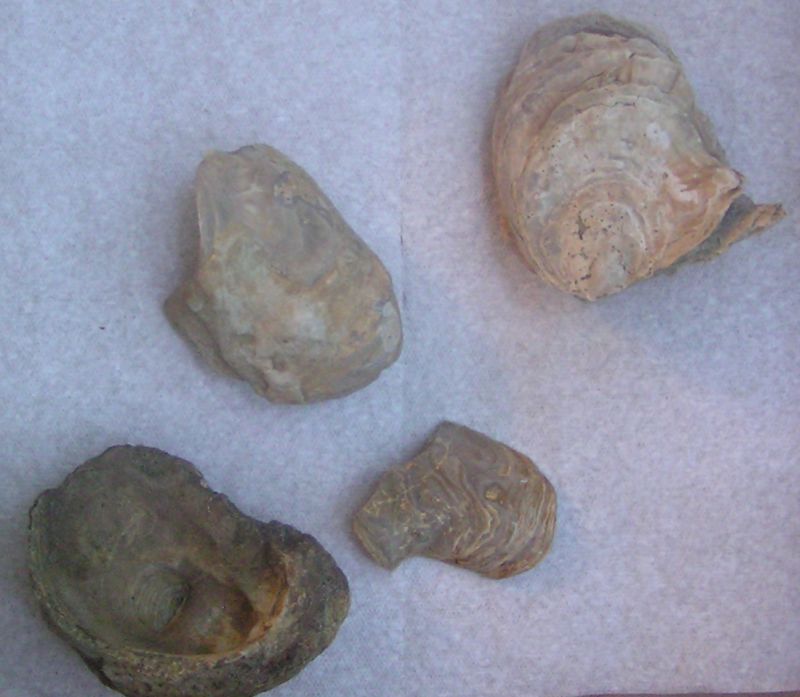
Some shells found by Vicki.
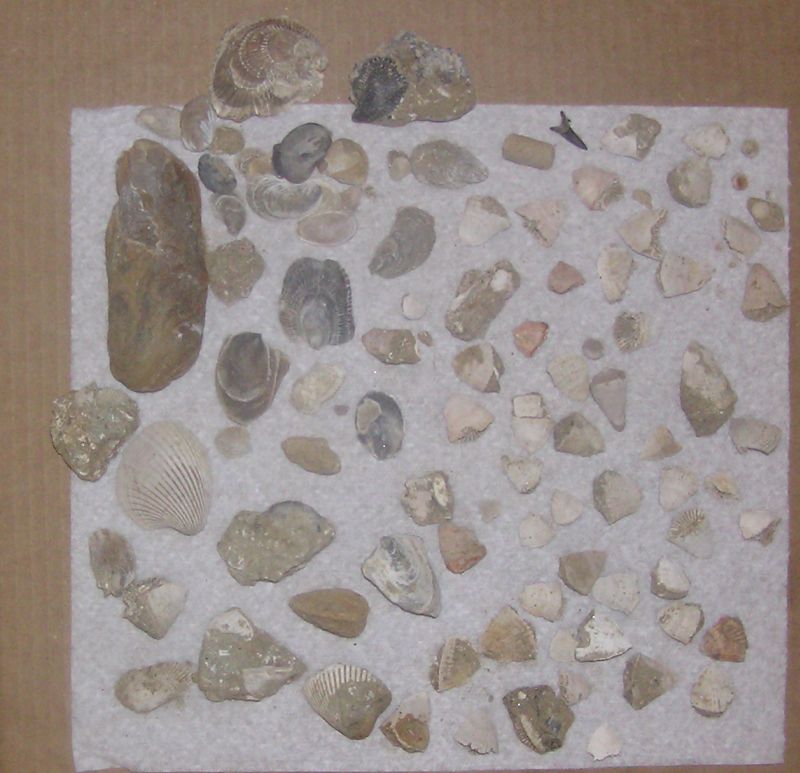
Shells and corals in Vicki's bag.
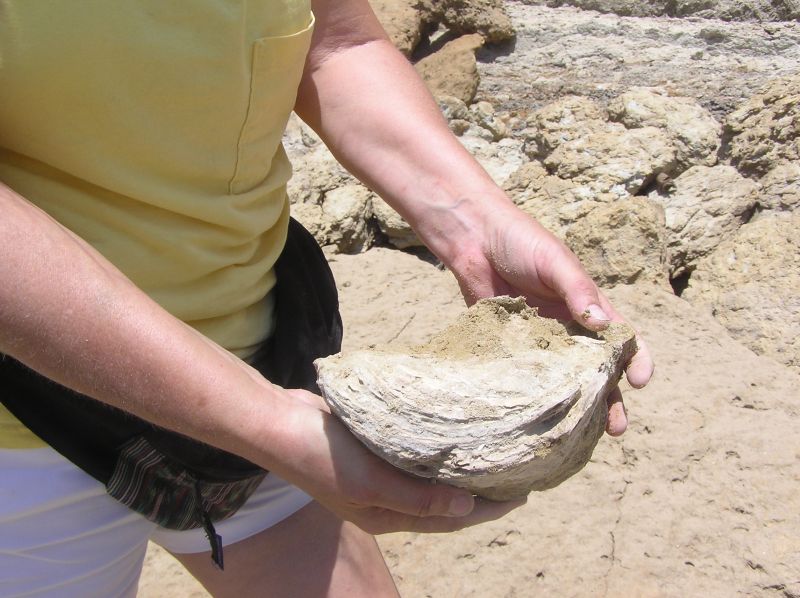
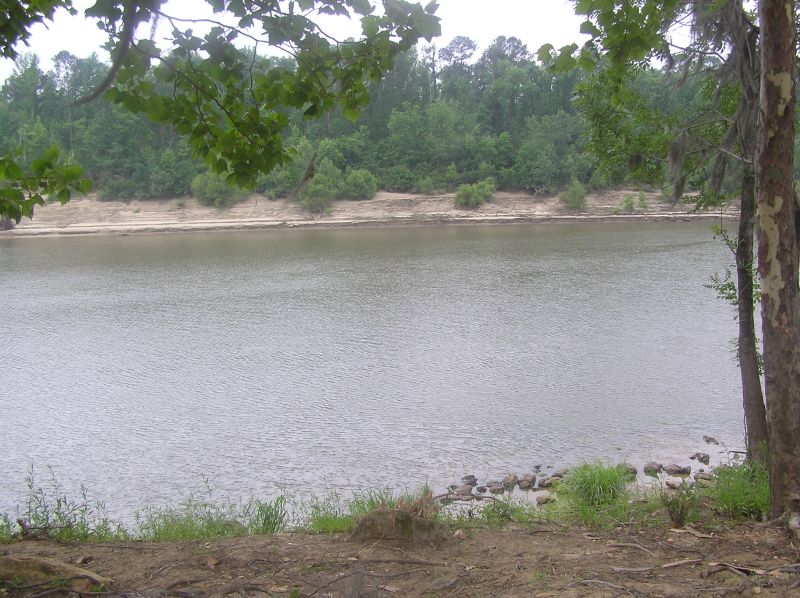
One last look at the river before we head for lunch, then on to the next site.
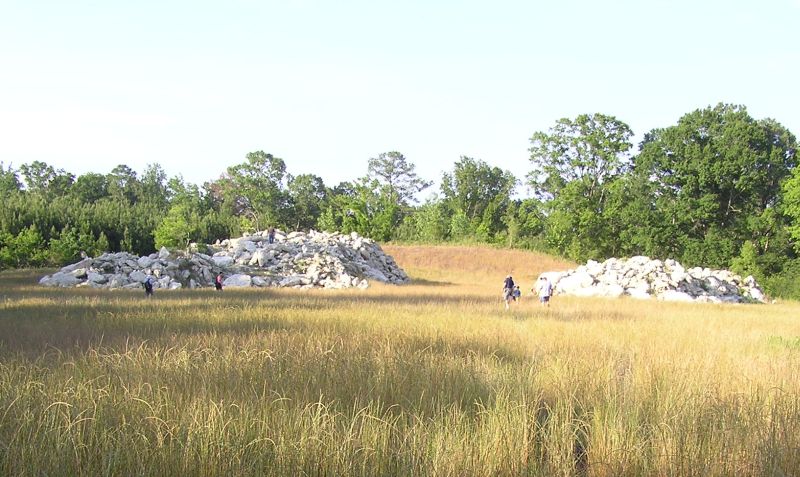
Later in the afternoon we headed north to Wilcox county, to this pile of rocks from nearby road construction.
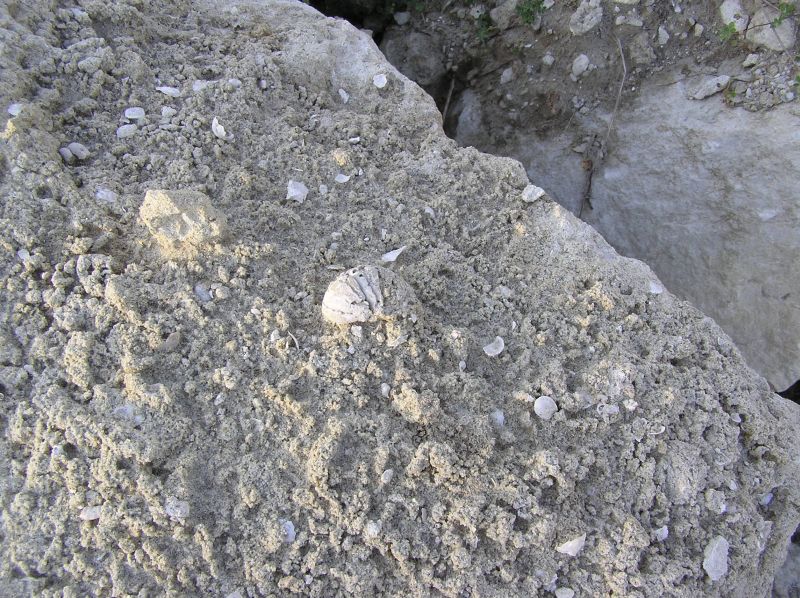
This was spotted on the way in, but the rock was too hard to easily remove the fossil.
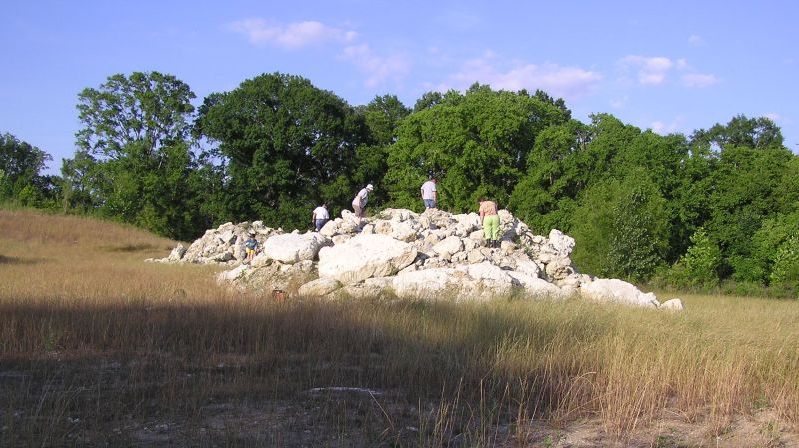
Jan and Lea headed over to this pile of rocks where they found . . .
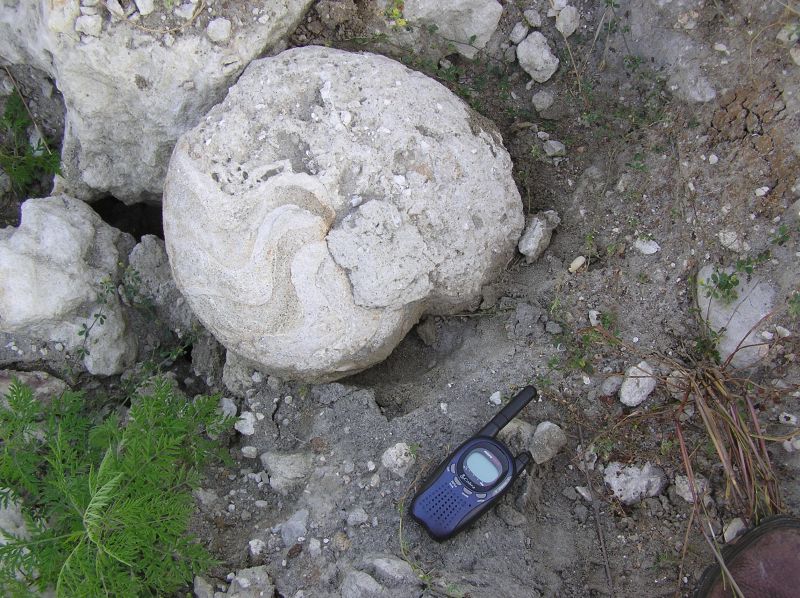
a cast of a very large nautiloid!
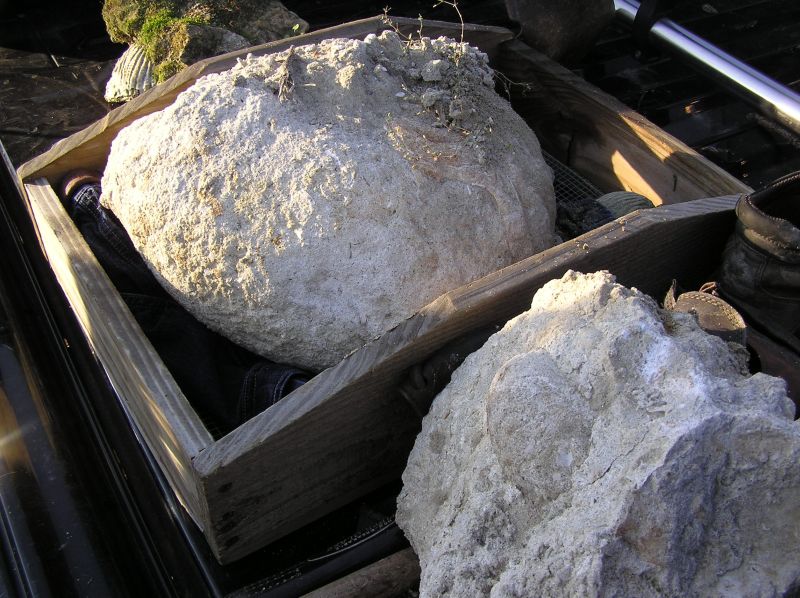
More nautiloid casts.
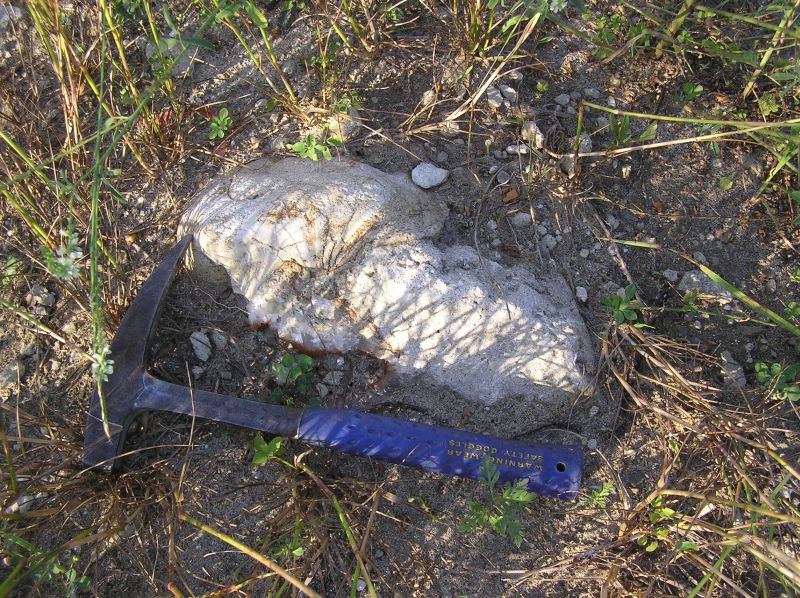
Claire found this piece of nautiloid barely out of the ground. She dug quite a while to work it loose.
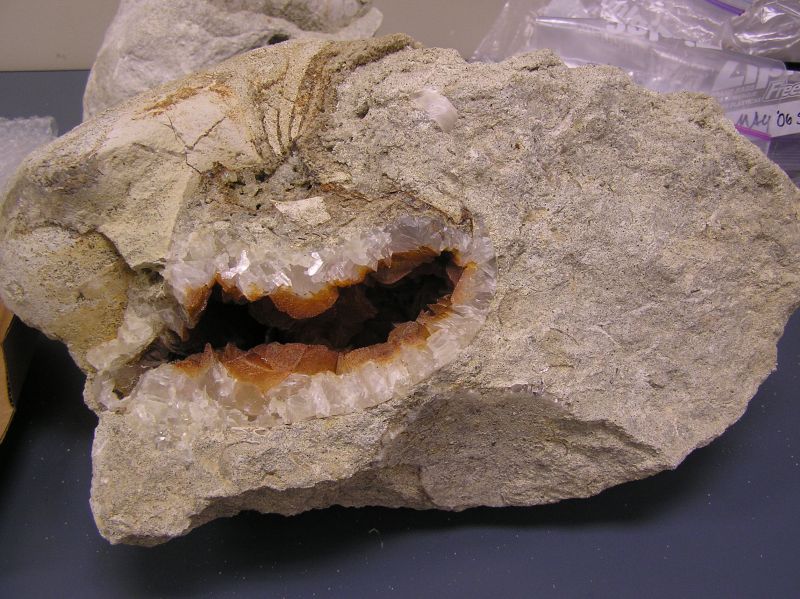
This is what Claire found inside the nautiloid after removing the matrix. Beautiful quartz crystals!
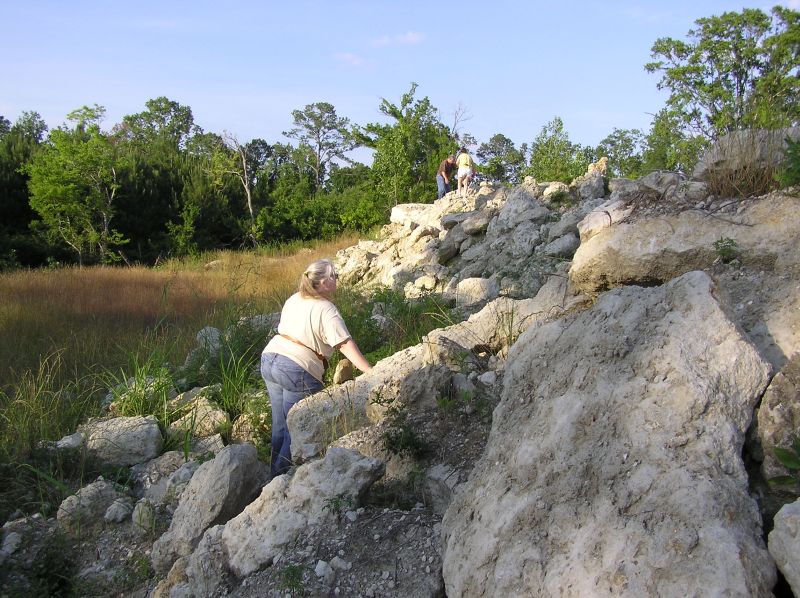
Martha searching for an easy way up, which required the skills of a mountain goat!
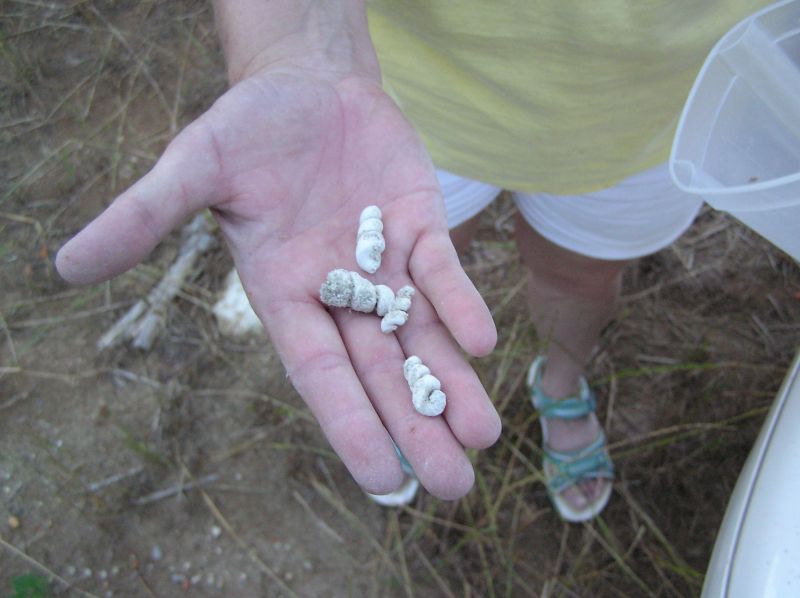
Becky has found some nice gastropods.
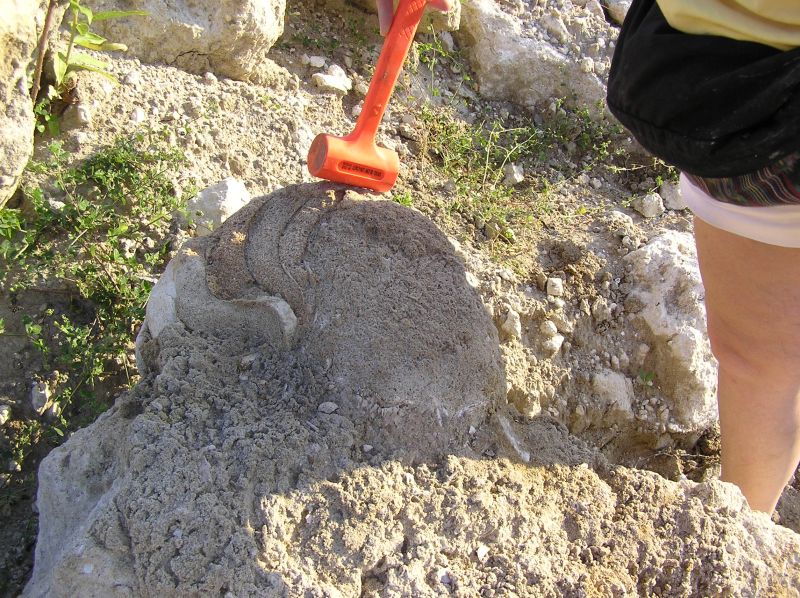
And a large nautiloid cast in extremely hard rock!
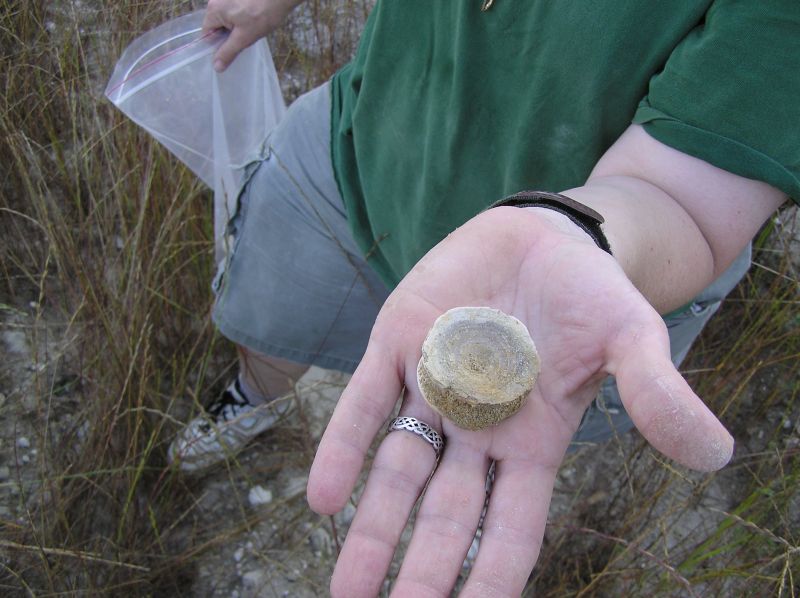
Claire had a very nice day. In a wash near the nautiloid filled with crystals, she found this large vertebra.
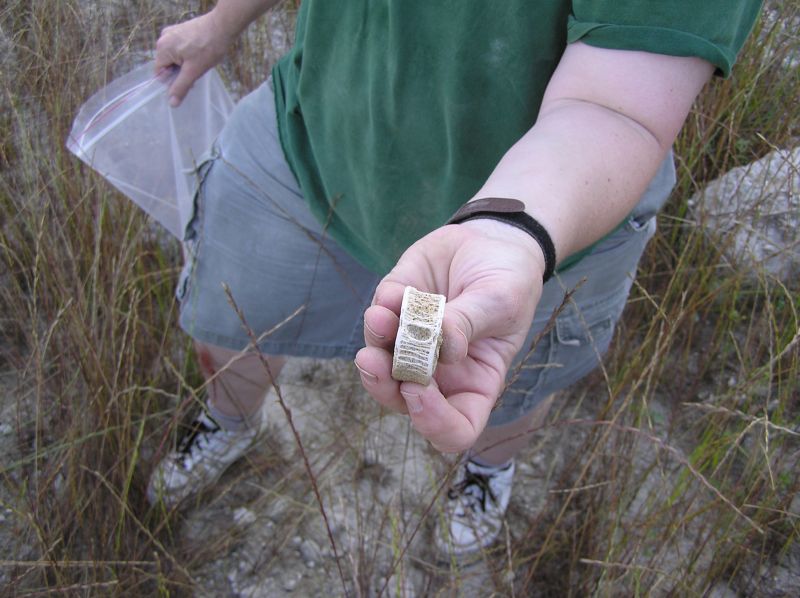
Side view of the vertebra.
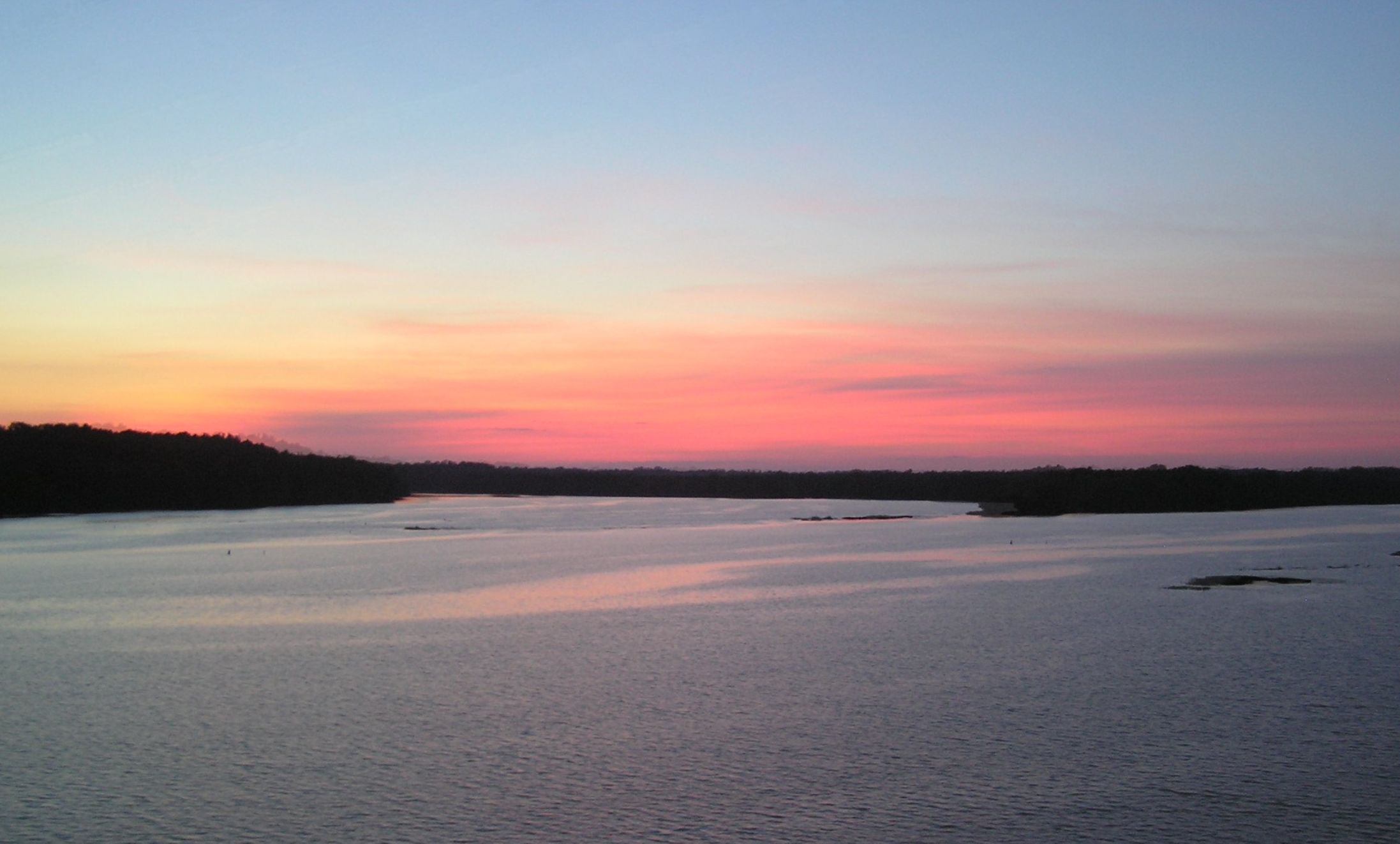
As the die-hard fossil hounds called it a day, we were treated to a beautiful sunset!
It was an international gang this time, with 5 members from the Czech Republic, 3 exchange students from Sweden, one long-term member from Armenia and a couple all the way from exotic LA (Lower Alabama), along with the local members. We have had several debates as to whether we need to change our name to Birmingham International Paleontological Society, or Birmingham Paleontological Society, Internationale!
It was so gorgeous when we all got down there that people were sitting out in beach chairs and enjoying what could have easily passed for the Gulf coast's white, sandy beaches. Some folks got into the swim - literally - as one of those privileges of living in a tropical climate on Oct 1 in Alabama. A variety of fossils were found, including nautiloids, tiny gastropods, shark teeth and coquina stone filled with various shells including turritella. We also found a good amount of pottery shards, some other artifacts and a deer skull (recent, but included to show what the teeth look like). Several comments were made regarding the beach, on the order of "it didn't really matter whether we found fossils or not, this was a great place to hang out"!
The deer skull has a backstory. While wandering off for a solitary hike up the creek, Vicki managed to get herself thoroughly lost. In the dark. Forgot that trail-laying stuff from Girl Scouts, right Vicki? Well, it turned out well in the end, when Vicki took off and finally found the road, as well as gaining some nifty scratches. Things improved the next morning after Claire and Lea got out the weedeaters and cut a beautiful path down to the creek. Kudos, Kids! And Vicki is going to do a refresher course if she can find her old Girl Scout Handbook.
After a very full day, most of the group repaired to the campsite for a wine-tasting, while others continued the hunt. (It's not dark yet, right?) After forcing themselves to get up and moving again, most of the group headed back to home and reality. Claire, Lea, Paige, and Vicki camped another night, and enjoyed the peace of the creek for another day.
(Photos courtesy Lea Martin, Jan Novak, and Vicki Lais)
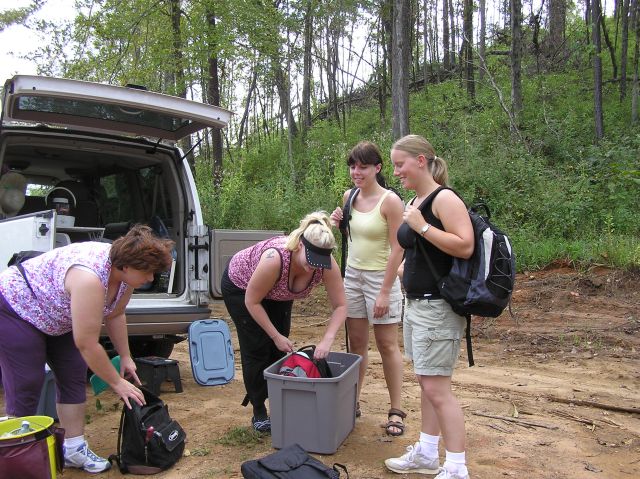
Leisa thoughtfully provided our 3 Swedish exchange students with everything they needed to enjoy the day's trip.
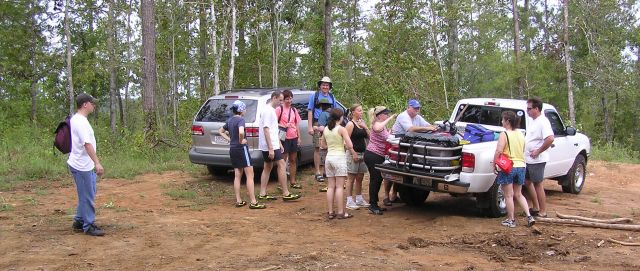
Due to rain the previous night, we left the cars at the entrance and loaded all our gear in Greg's truck.
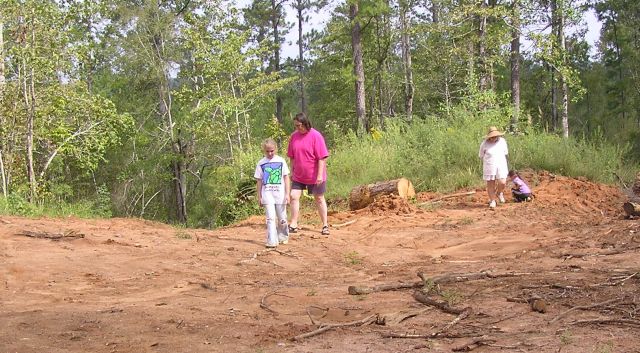
Scouting the parking area, which was newly bulldozed.
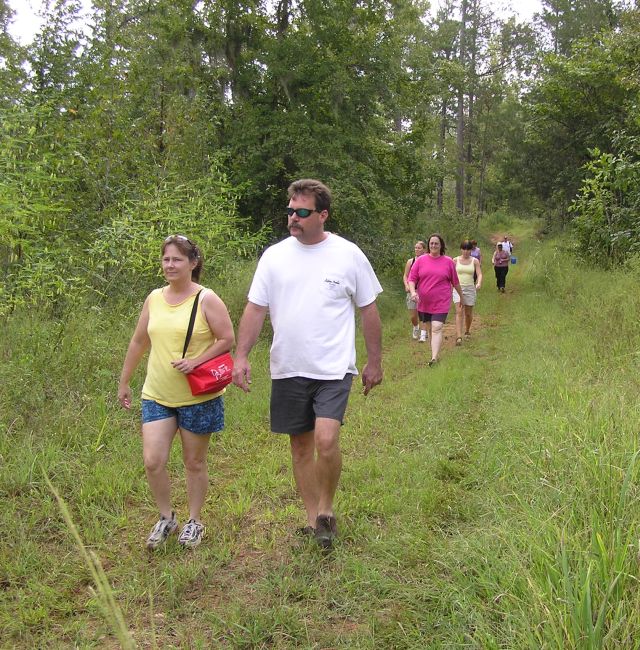
Some of the group on the long hike down.
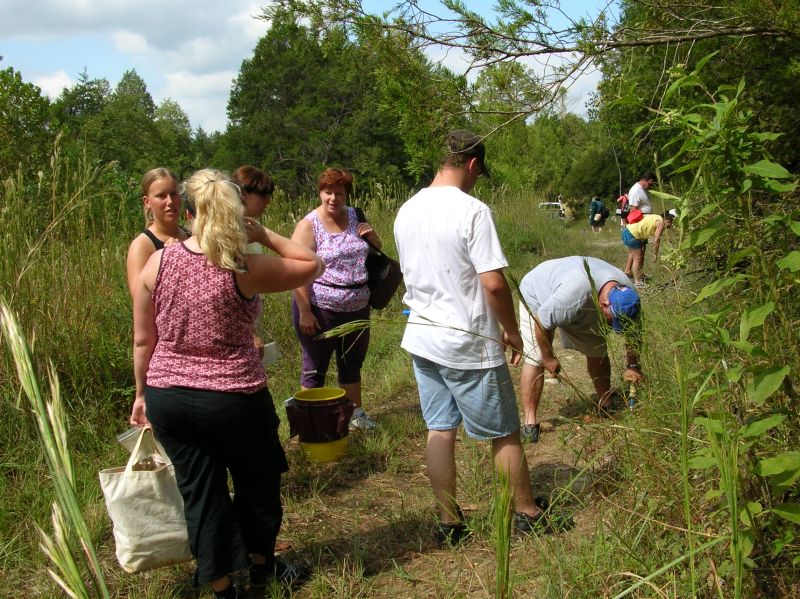
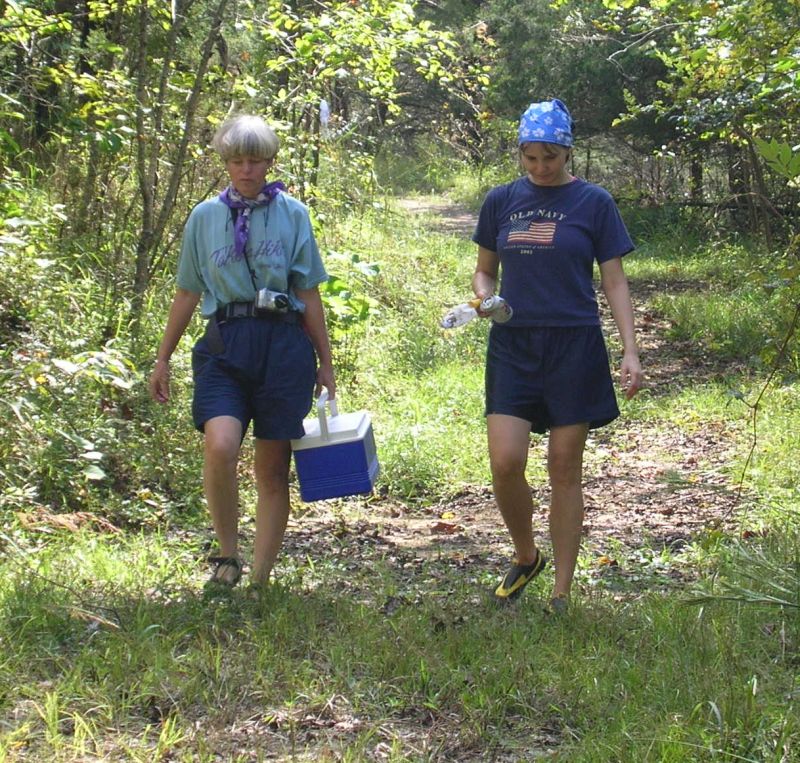
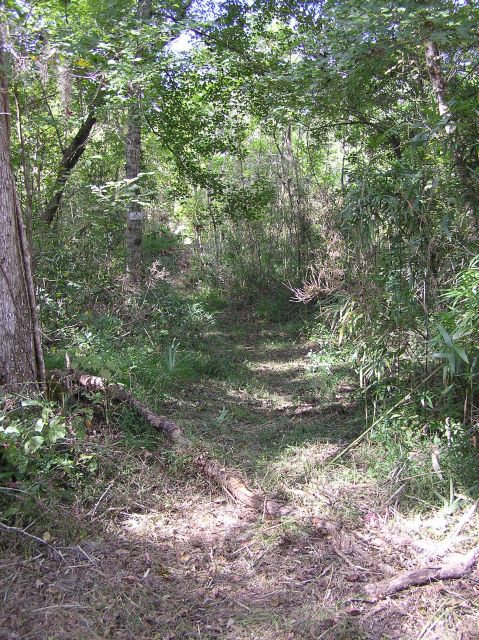
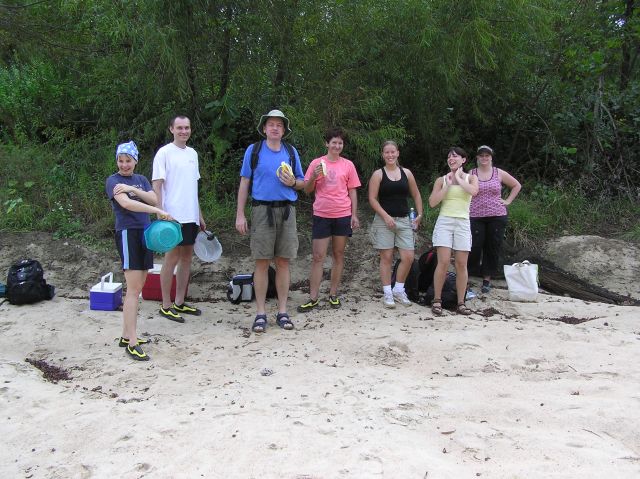
Sun and sand - on with the sunscreen!
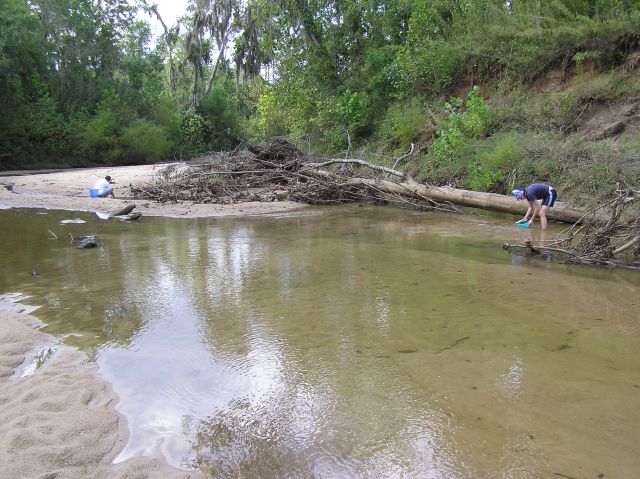
Sylvie and Michael screening for shark teeth.
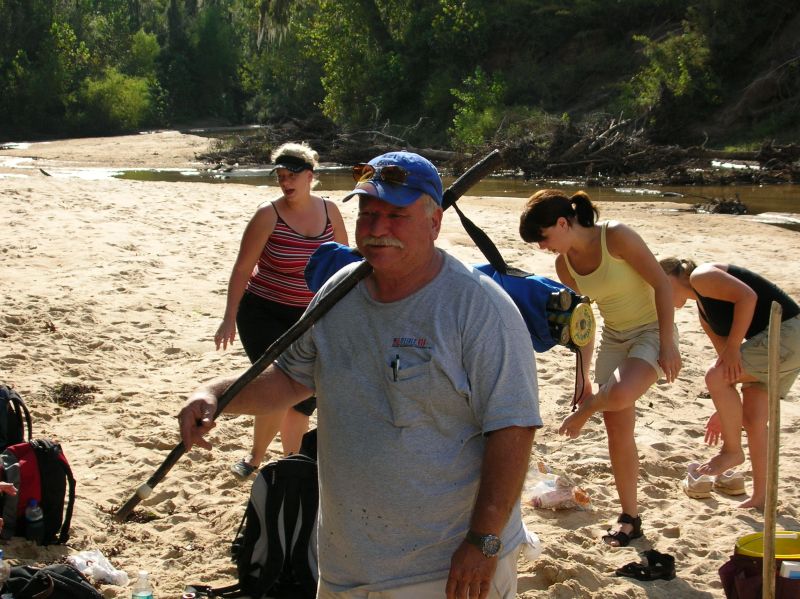
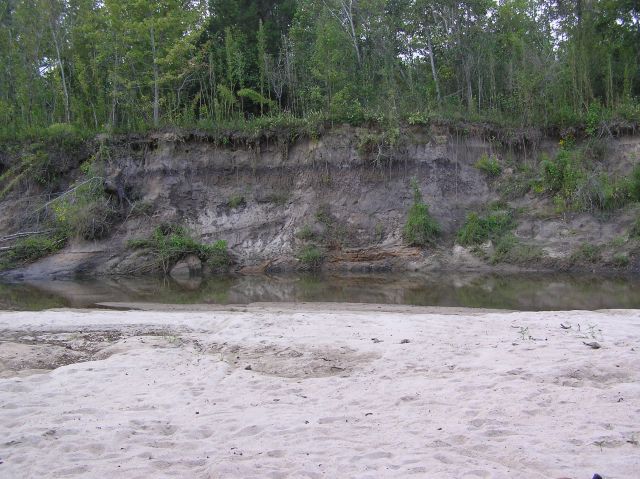
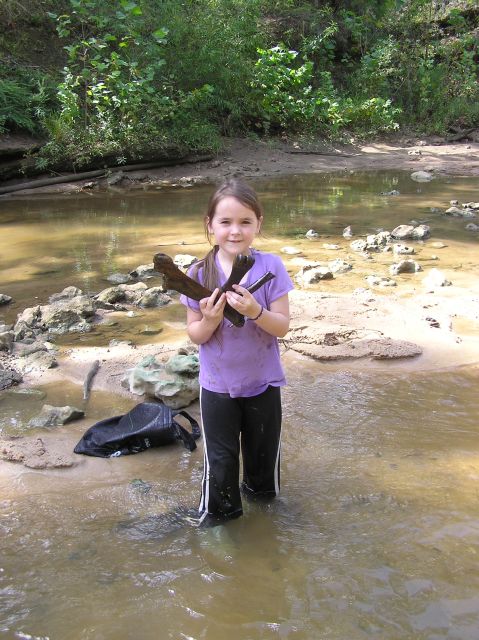
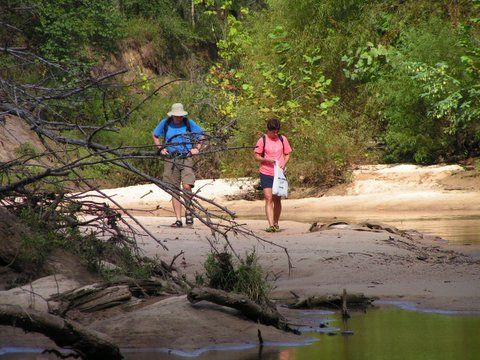
The Novacks starting a long trip way up the creek.
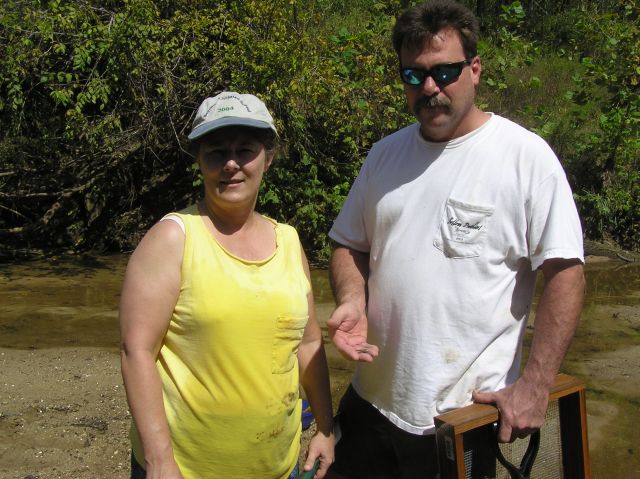
Two of our newest members from Mobile, Becky and Keith. Keith is holding a nice shark tooth that was found in the shell filled bank shown below.
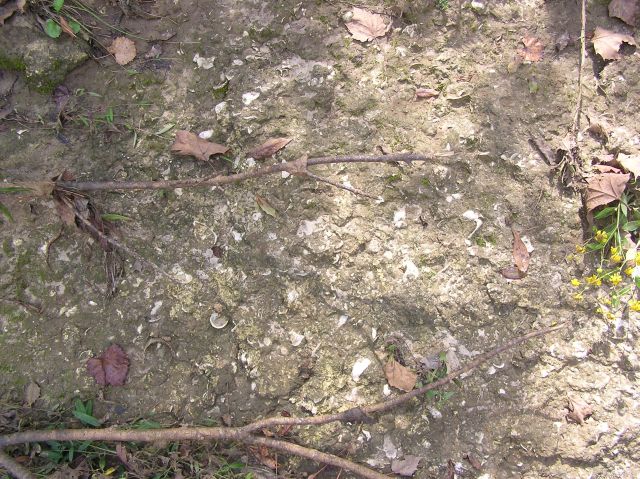
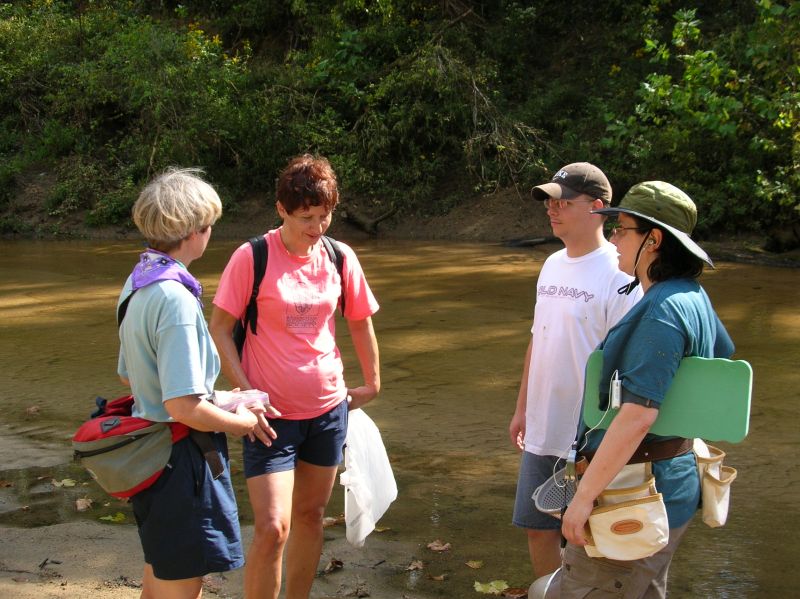
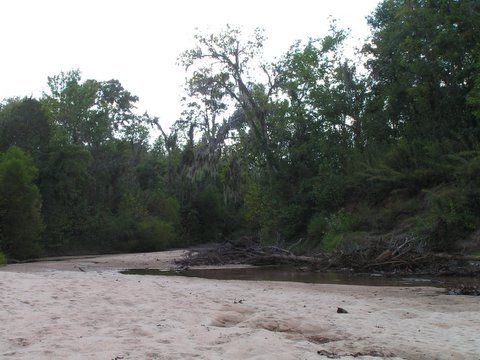
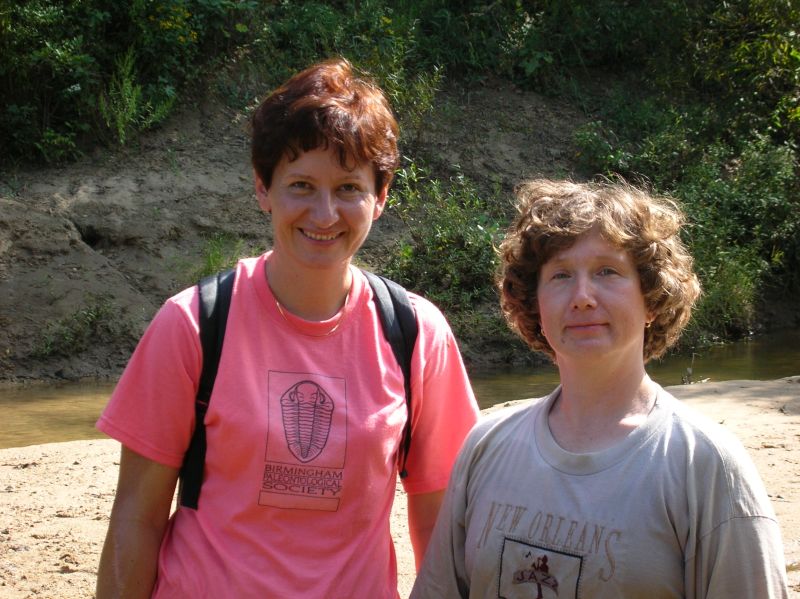
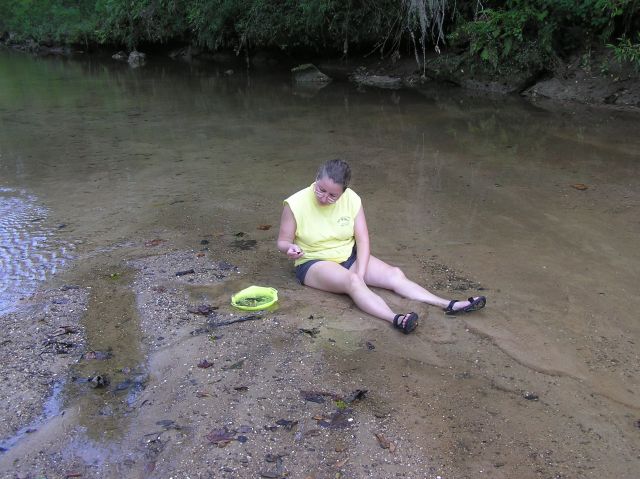
Lea examining one of her finds.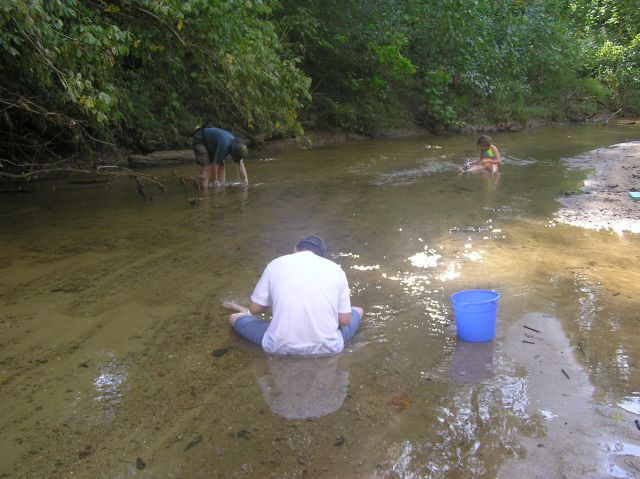
Screening for shark teeth.
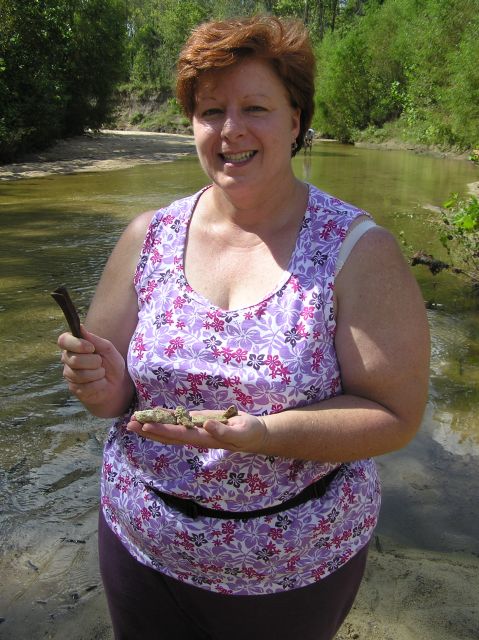
Leisa has found a nice bone artifact, and some cochina stone.
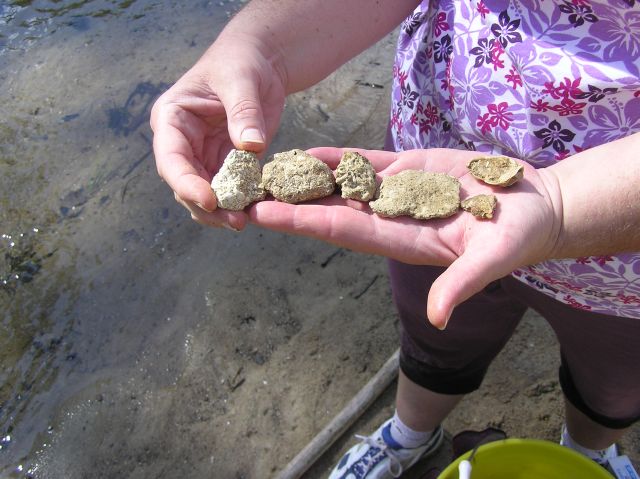
Closer view of the cochina. This stone is filled with fossil shells, including turritella, and is widely found in Florida, where it is cut into blocks and used as a building material.
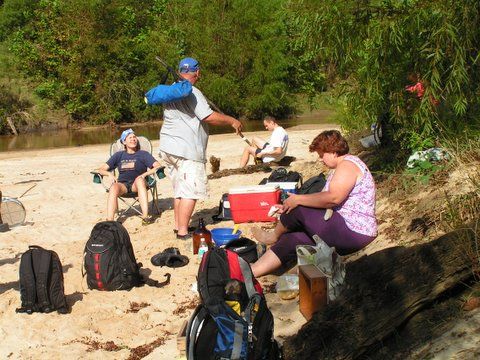
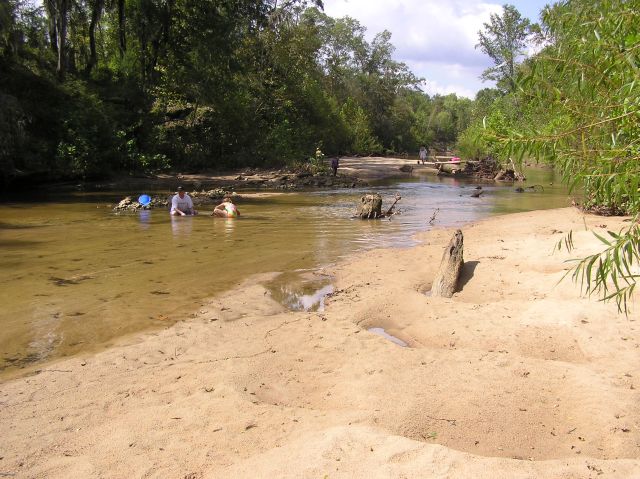
Beautiful weather, temperature in the 90's (in October????), and we certainly took advantage of it!
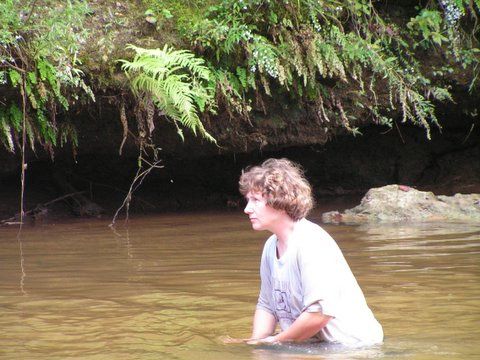
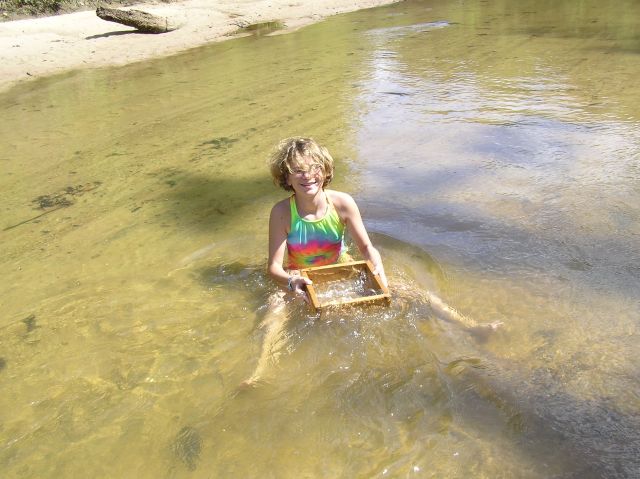
Paige keeping cool while screening for shark teeth.
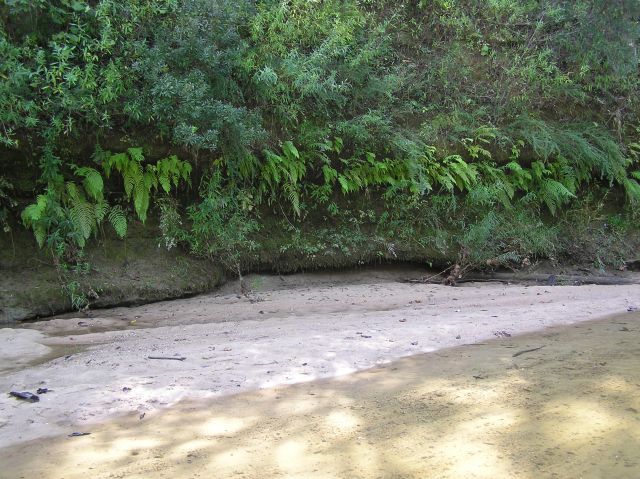
South Alabama is a beautiful place, and our fossil hobby gives us wonderful opportunities to see such treasures as this fern bank.
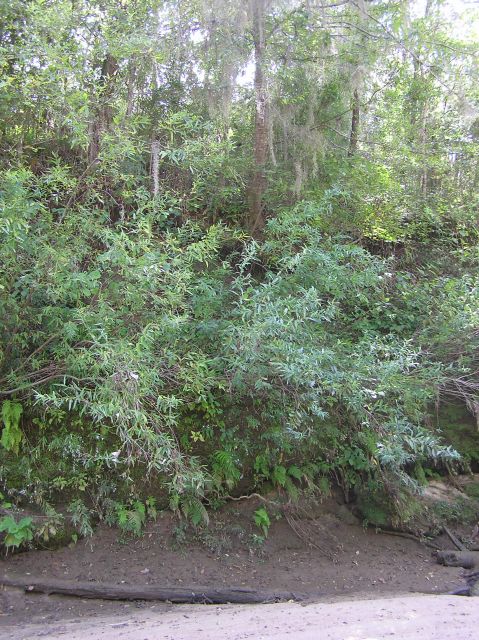
South Alabama is also known for the Spanish Moss hanging from many of the trees. It was used as packing material many years ago.
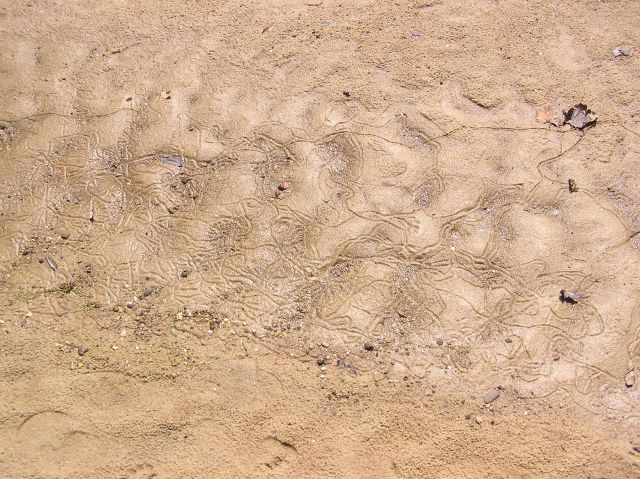
Many times fossil worm trails (trace fossils) are found in sandstone and shale material. Here is the modern day equivalent.
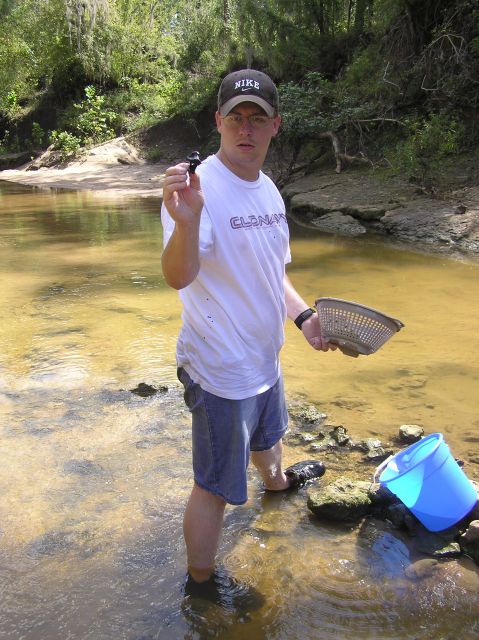
James has found a vertebra, but it is recent.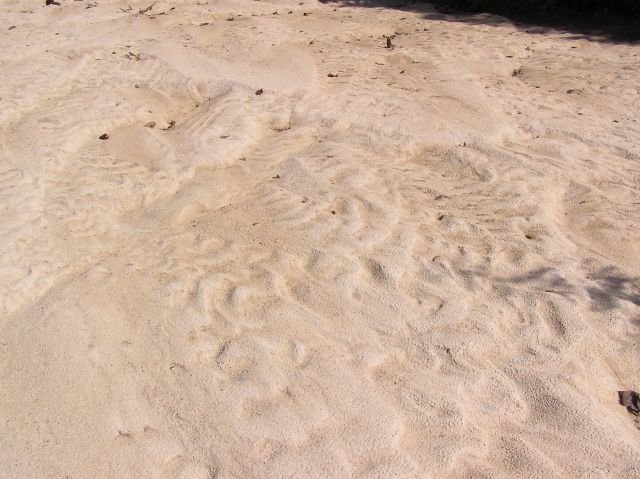
Many sandstones and shales show wave patterns, captured here in modern day sand.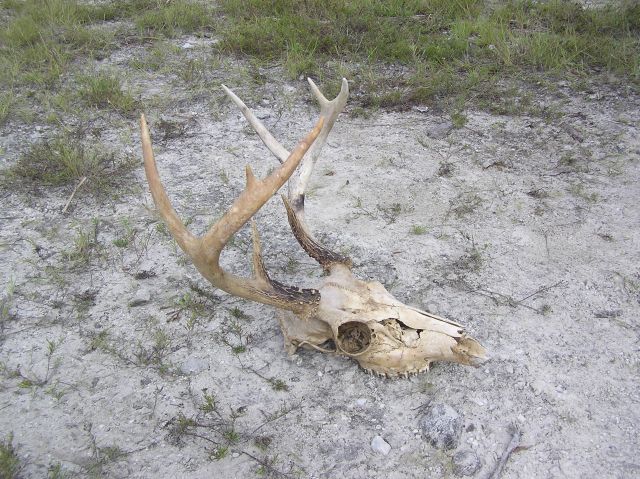
Nice deer skull found in the creek. Claire is now the proud owner.
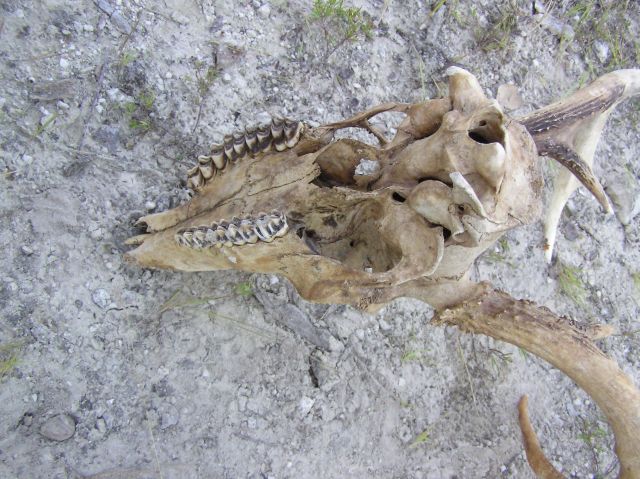
"What kind of teeth are these?" is a frequent question. This should aid in identifying deer teeth.
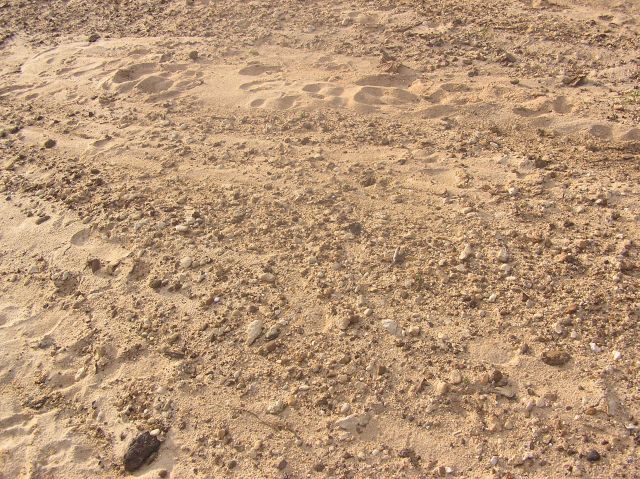
This area was covered with larger rocky material, and yielded many pottery shards, but few fossils.
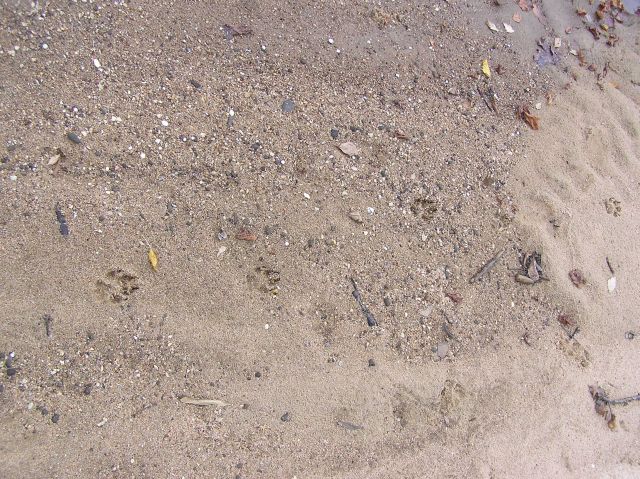
We weren't alone on the creek, these may be tracks of the coyotes we heard "singing" during the night.
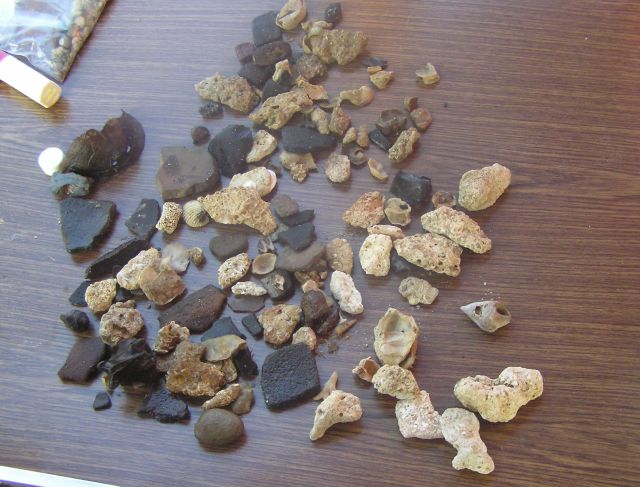
Vicki's collection.
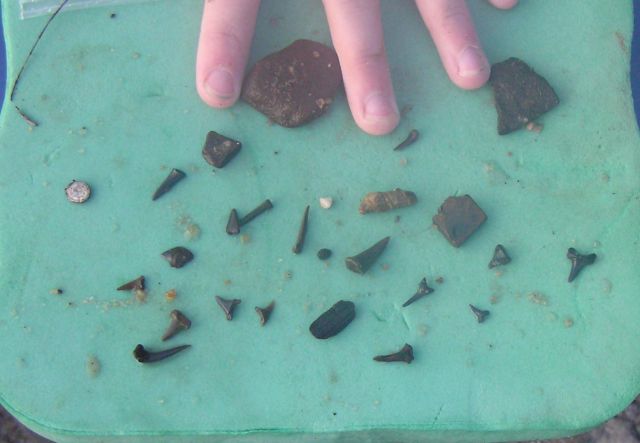
Paige collected quite a few shark teeth.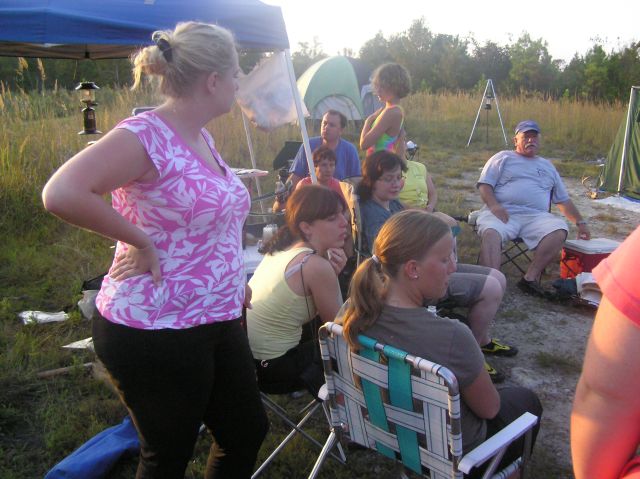
Hanging out at the campsite, late afternoon. We also collected small gastropod specimens in this area.
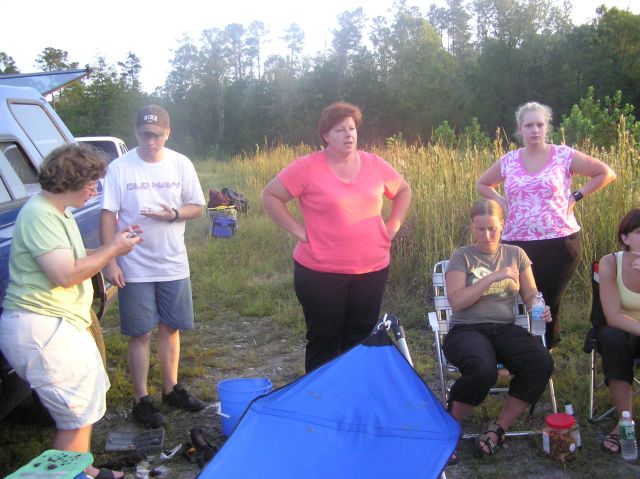
Discussing our finds for the day; hanging out and enjoying each others company.
Members participating in this long trip were Greg, Jan, Steve, Leisa, Gilbert, Carolyn, Vicki, Nancy and Miss Daisy.
(Photos courtesy Nancy Kenfield, Steve Corvin, and Vicki Lais)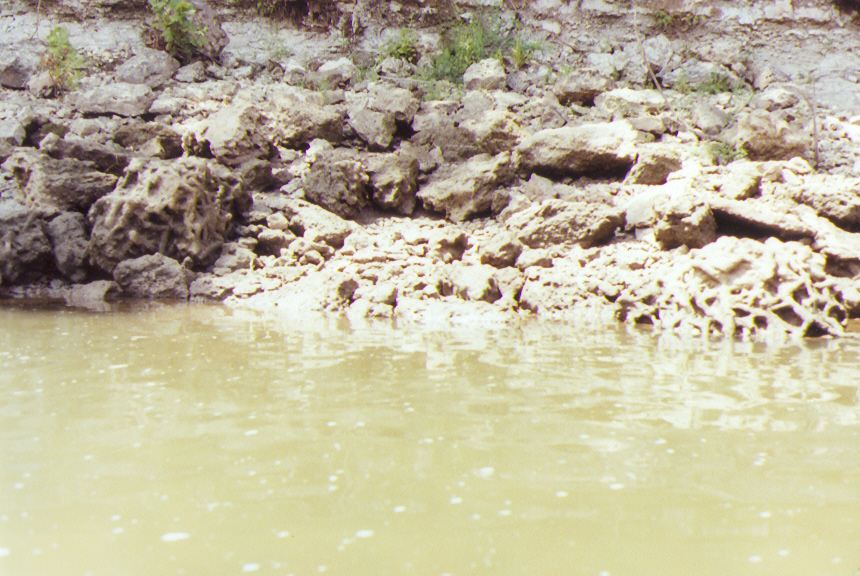
Along the shoreline.
Greg and Steve, getting ready to check out this landing.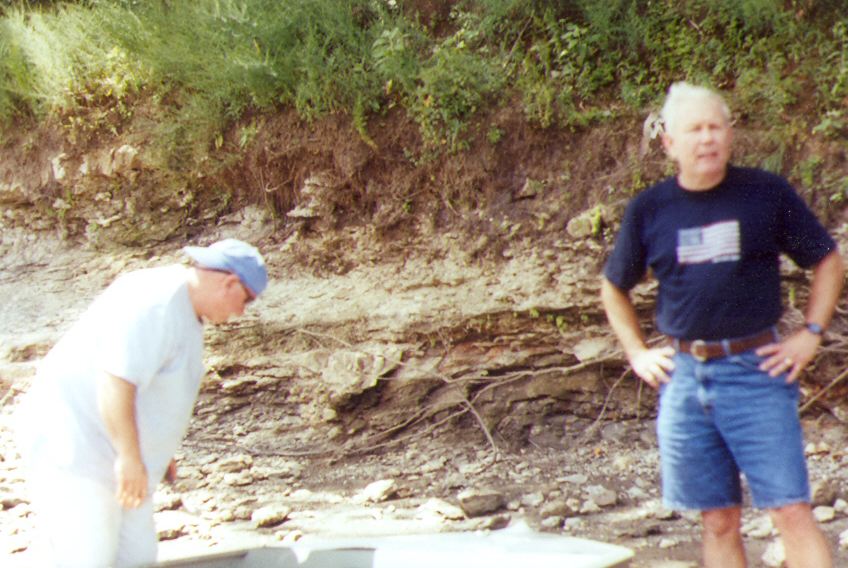
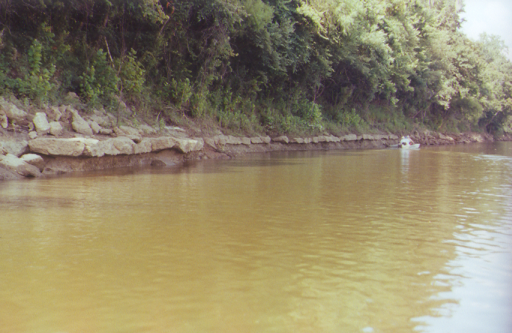
Shells in matrix. Sand is wet, and shells will disintegrate at the slightest touch. Careful excavation is essential.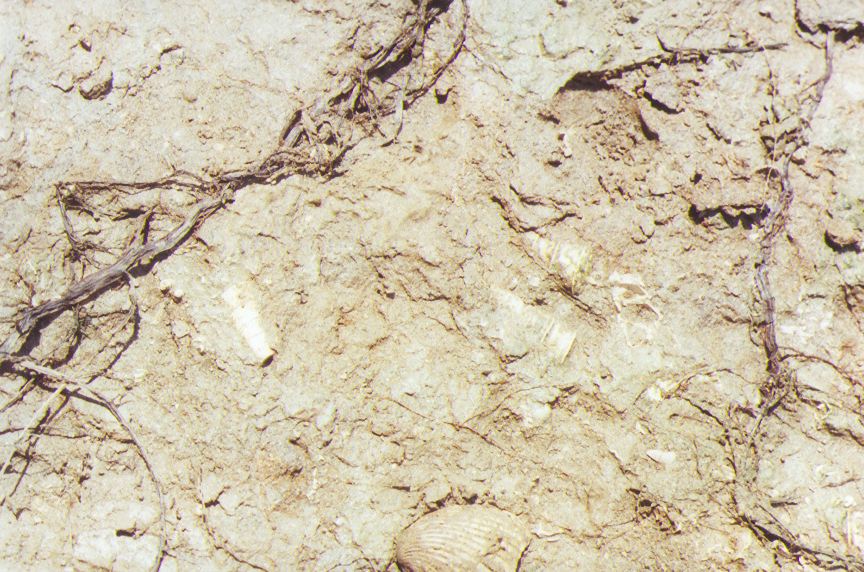
At slightly higher elevations, the shells are dry and hard. Leisa found these.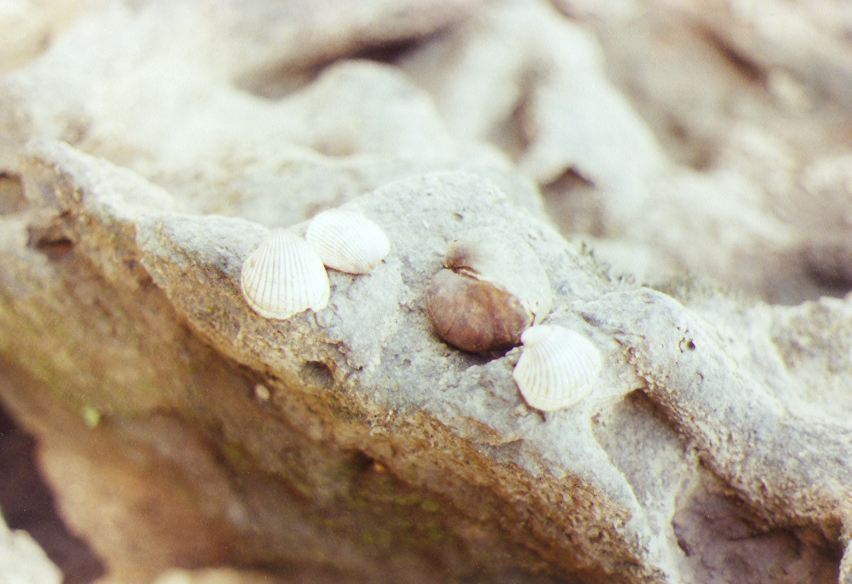
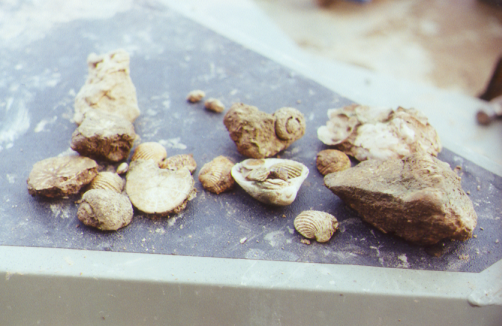
A representative sampling of shells in this locality.
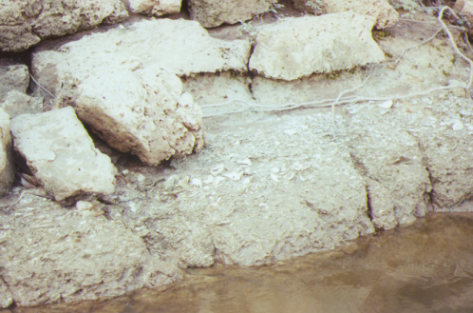
Shell layers in the bank.
Turritella found by Steve.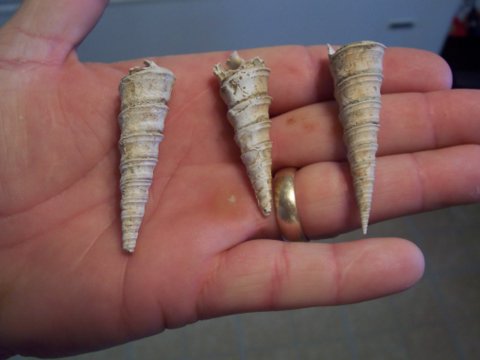
Sand dollar found by Steve.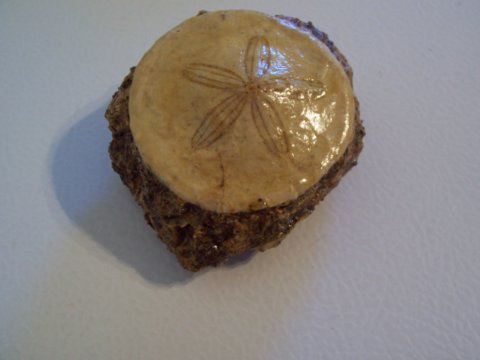
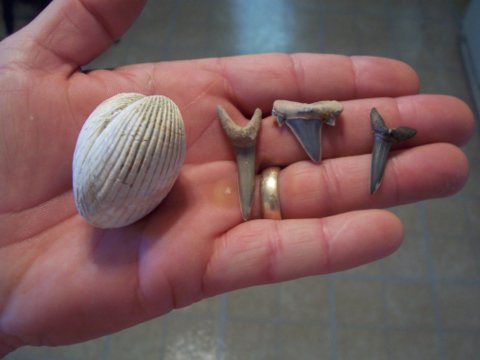
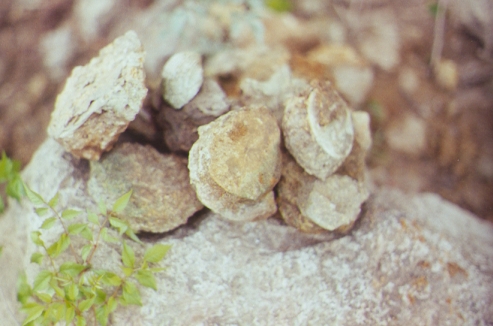
Nice collection of sand dollars found by Steve.
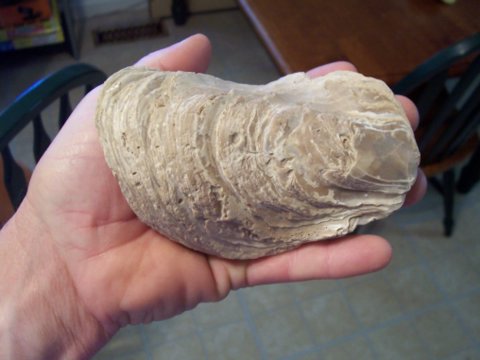
Large boulders, appearing to be trace fossils, perhaps burrows.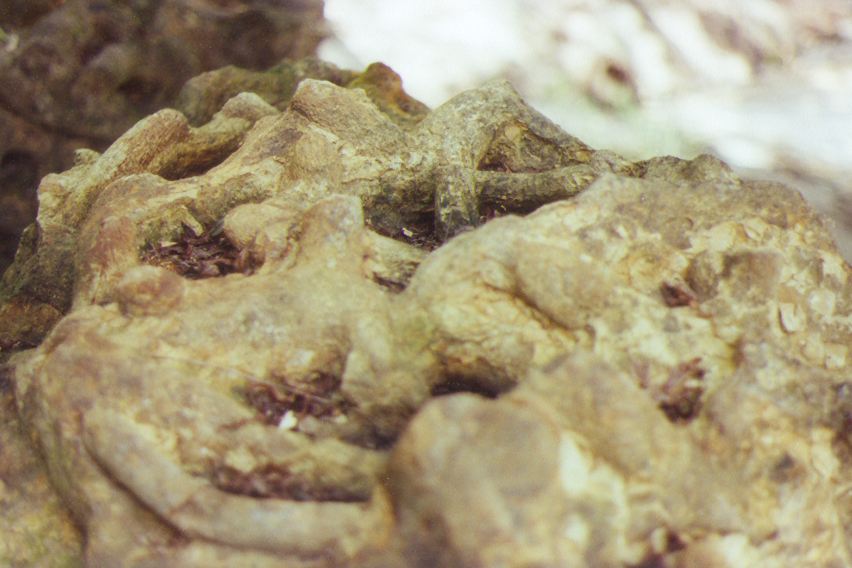
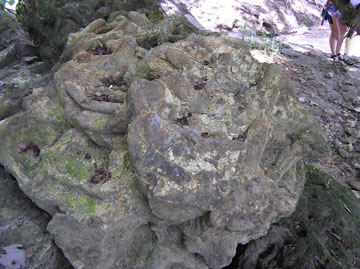
Many of the burrows had shells inside.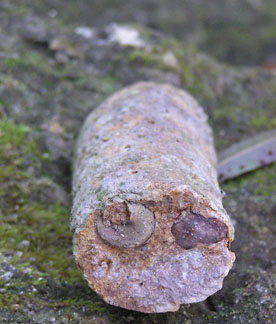
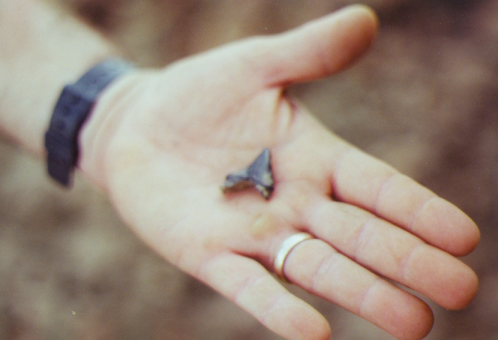
Tooth found by Steve.
Gilbert after a long hard day on the river.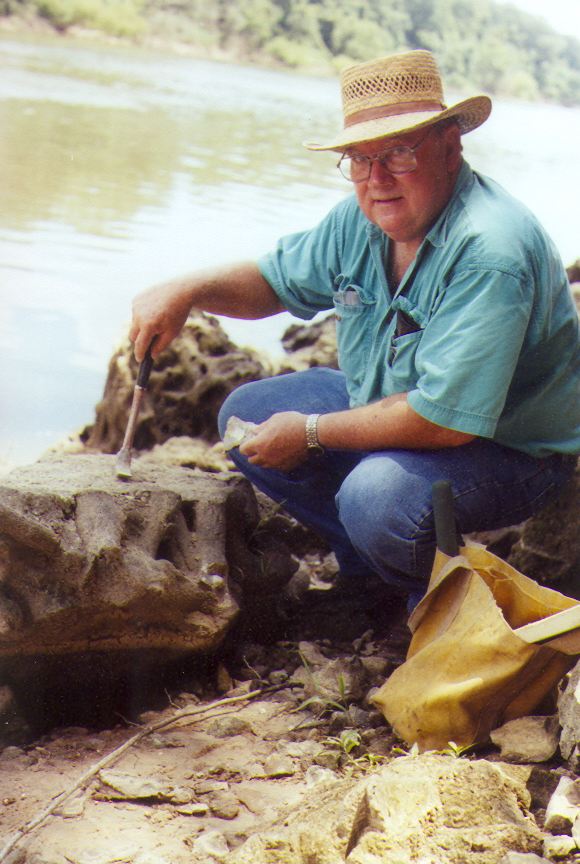
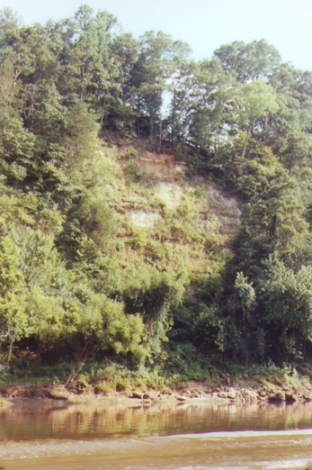
A view of the bluffs, mostly grown over now.
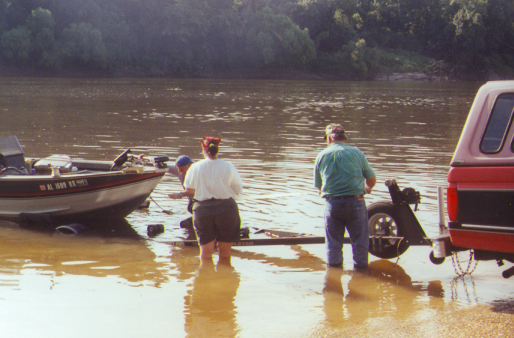
End of another great collecting day!
On the way down, some of us apparently took a wrong fork in the road.... that sign was deceiving.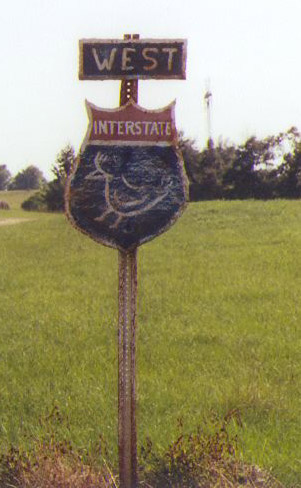
A number of teeth from the Goblin shark and crow shark were found by all. (See the July, 2003 trip report for details on these sharks, and more on the geology of this site.)
(Photos courtesy Vicki Lais)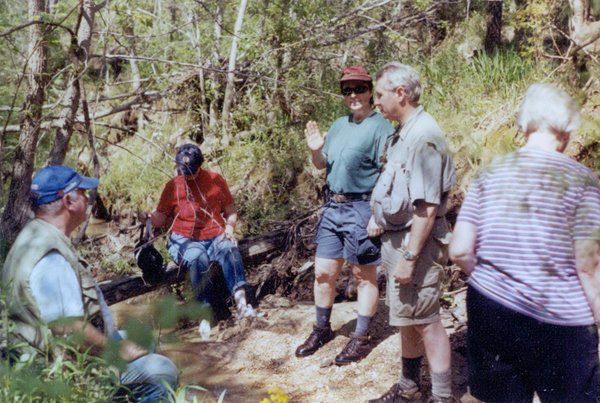
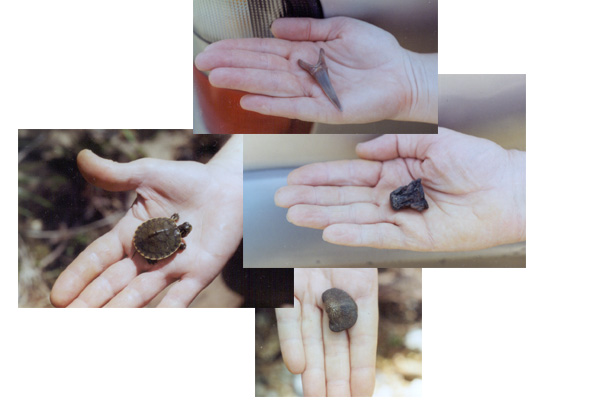
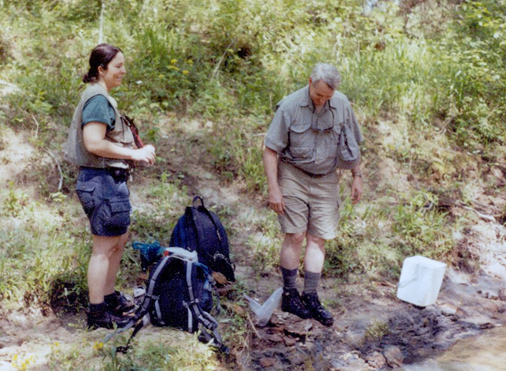
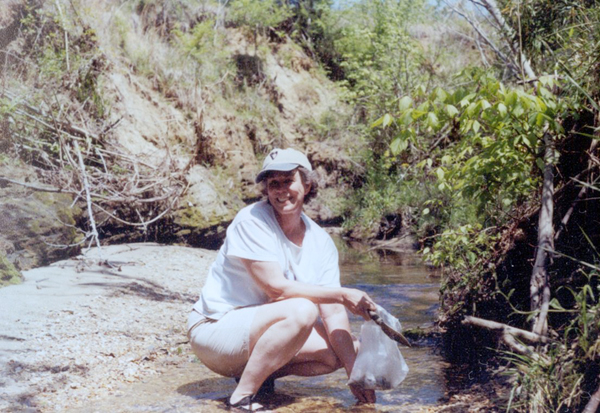
Ann and her bag of treasures.
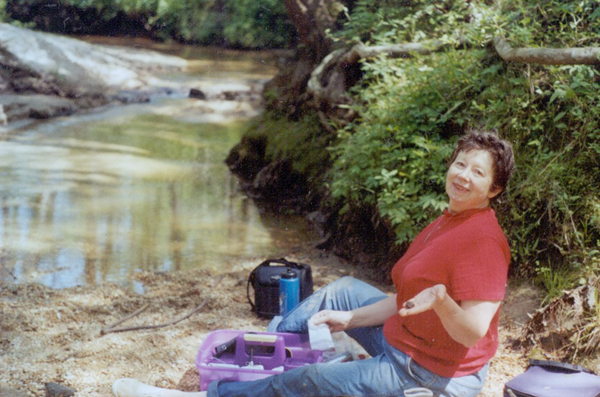
Nancy showing off her ptychodus tooth.
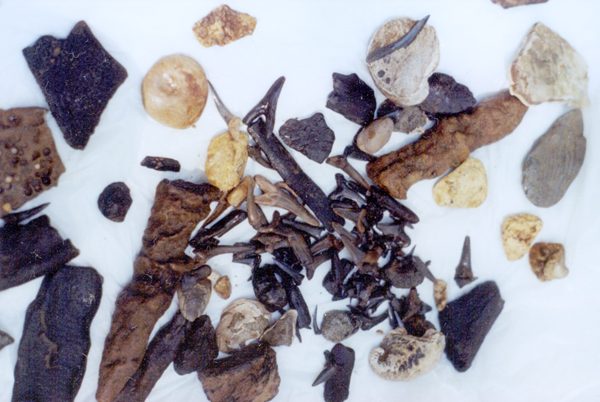
Vicki dumped her bag to show what she had collected so far. A number of shark teeth, some in matrix, bone fragments, and several "interesting unknowns".
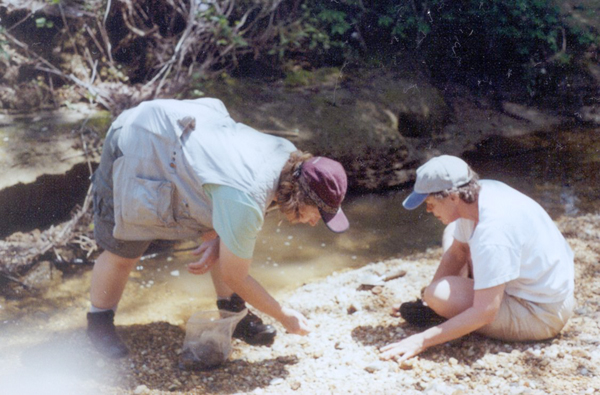
How many hours do you think Claire and Ann can do this?
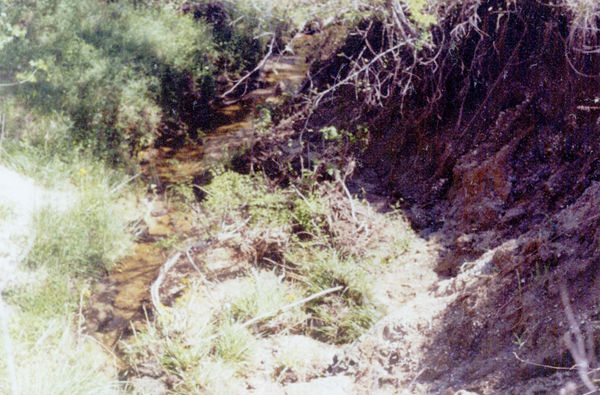
A small canyon that proved interesting. A little out of the picture one can see the strata where the teeth and pea gravel have been deposited in the bank.
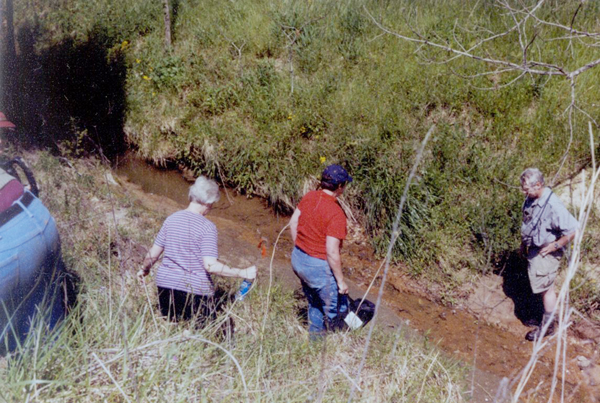
Climbing down into the canyon. (they keep telling me to quit taking pictures of rear ends....)
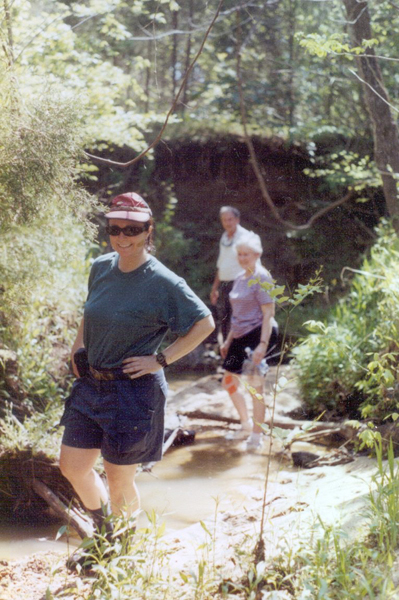
Lisa, with Jan and Bobby in the background. Steve was always somewhere way up the creek or way down the creek, and managed to totally avoid the camera.
We had so much fun at this site back in May, we wanted to do it again, and search for more mosasaur bones. And we were in luck! 2 more large vertebra were found, and 2 pieces of jawbone, one with pieces of the tooth still there, however, we did not find where they were washing out, but we all had a great time scouting. This site in Greene County, AL is characterized by large quantities of pea gravel. Going east along the creek one is in Pleistocene age material, while going west moves one through an area of Mooreville Chalk (Cretaceous).
A number of teeth from Scapanorhynchus Texanus were found by all. This shark, also known as the Goblin shark, was thought to have been extinct until it was re-discovered in the late 1800s off the coast of Japan. Its living relative is referred to as Mitsukurina Owstoni. The sharks most dominant characteristic is its long protruding snout. Living species frequent the greater depths around 1000’ or more. Scapanorhychus is estimated to have reached lengths between 3-5 meters (10-17 feet).
Its teeth are varied in shape depending on their position within the jaw. Anterior teeth are identified by their high arched bilateral roots, as shown in figure 1 below. The teeth themselves have prominent longitudinal striations running from the top of the cusp up most of the way of the inner curve. According to some sources, some anterior teeth may have tiny lateral cusplets, however not which were found exhibited this characteristic. Many of the anterior teeth (excluding root) found ranged between 2.5 to 3.5cm.
Lateral teeth, shown in figure 2 below, are much different than the anterior teeth. They are triangular in shape and have cusplets on each side of the tooth. The roots are more flattened and lack the arch that the anterior teeth possess.
--Edited by Vicki Lais
(Photos courtesy Ron Beerman and Vicki Lais)
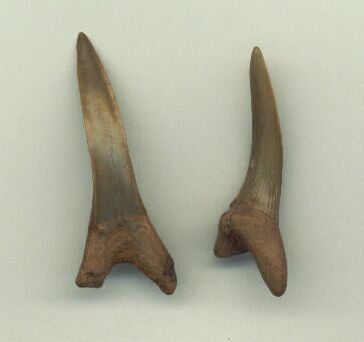 |
|
| Figure 1 | Figure 2 |
The second type of tooth found at this site was identified genus Squalicorax. Not enough information nor specimens were collected to specify the species at this time. Squalicorax, or crow shark as it is commonly known as, was believed to be both a predator and a scavenger. Fossil evidence seems to indicate that this shark grew to a length or 4.5 meters (15 feet) or more. Fossil teeth from this shark have been found in Europe, North Africa and North America. Some of the Squalicorax teeth found are shown below in figure 3.
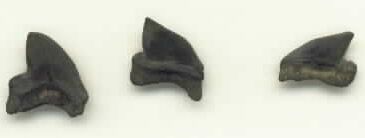
More photos of the trip:
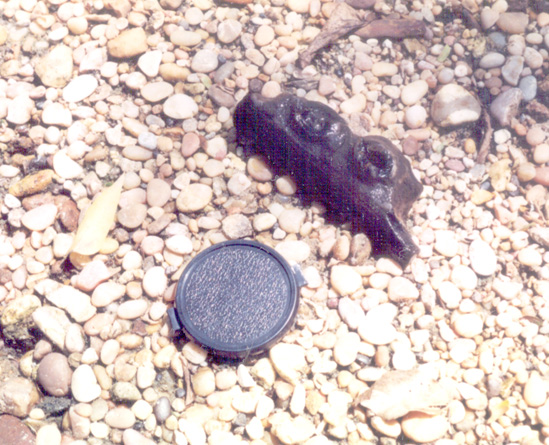
Jawbone found by Vicki.
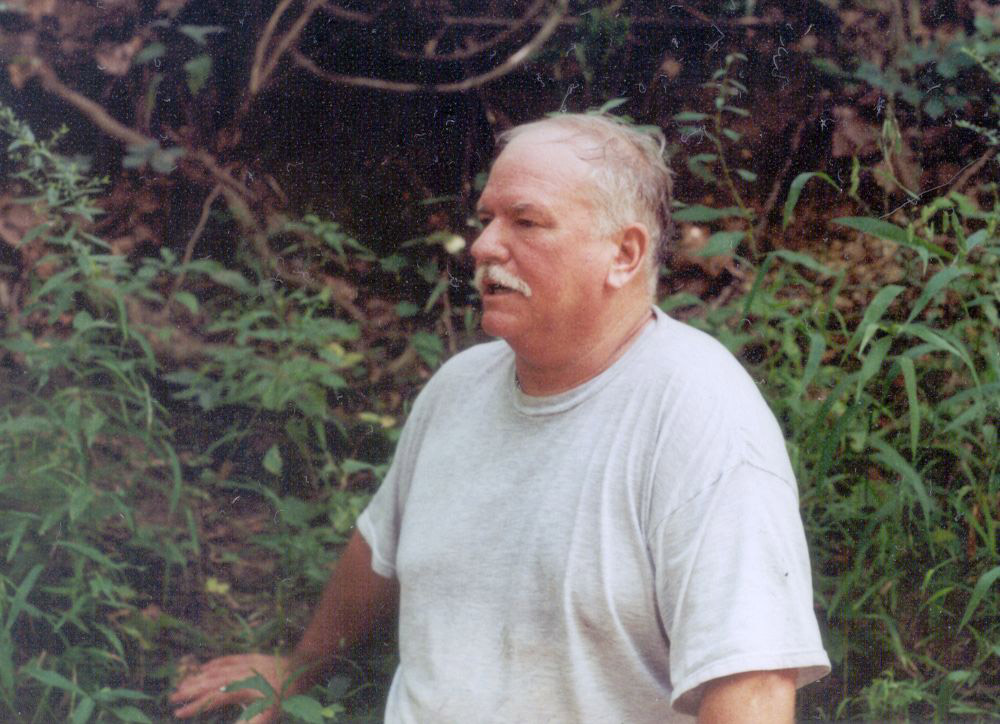
Greg describing the geology of the site.
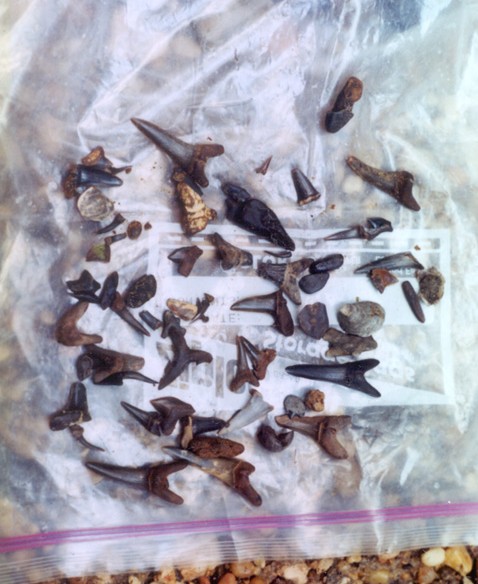
Claire's stash, above.
And Vicki's stash, below:
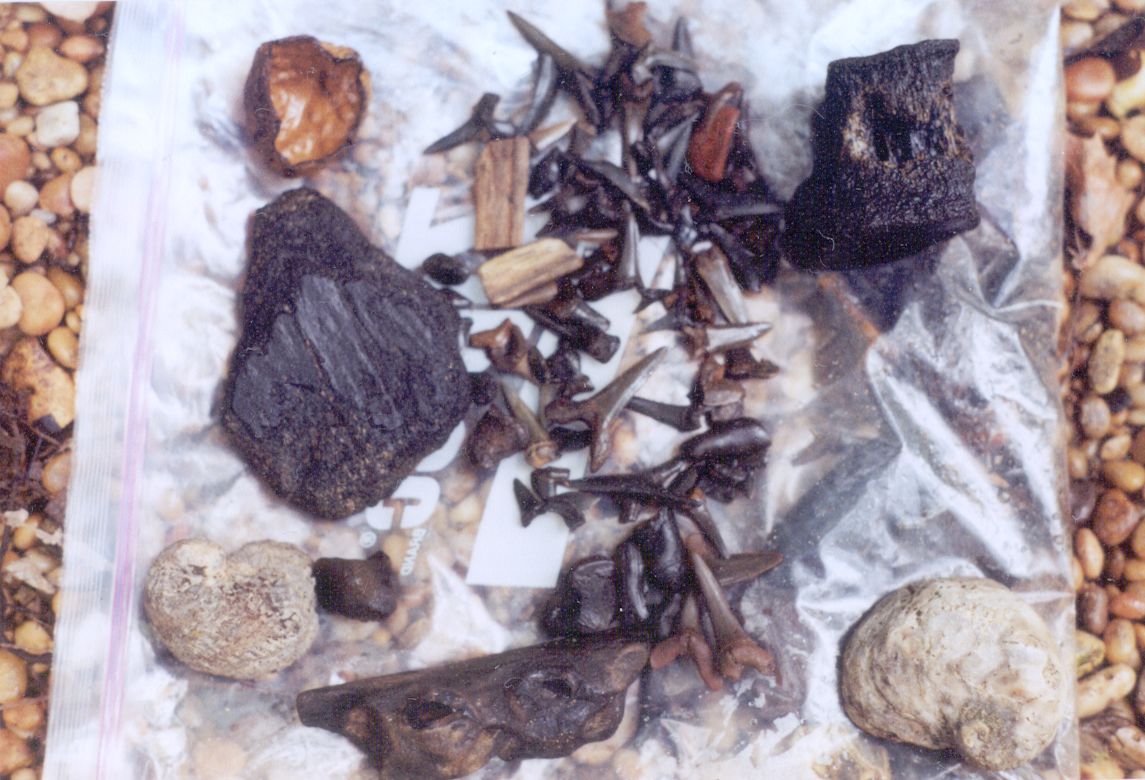
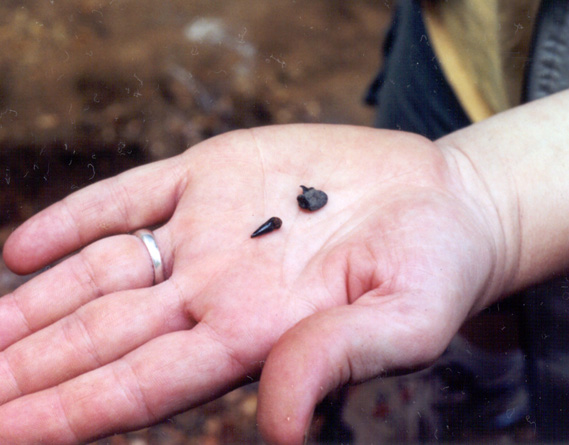
Tiny teeth; fish tooth on left found by Vicki, tooth in jaw bone found by Claire.
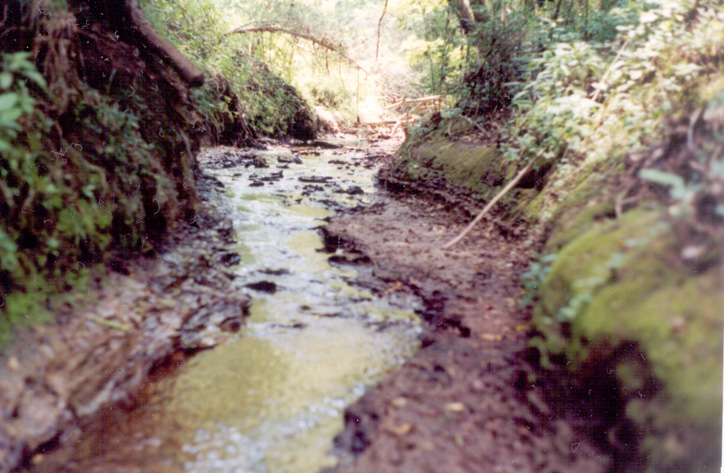
View up the creek.
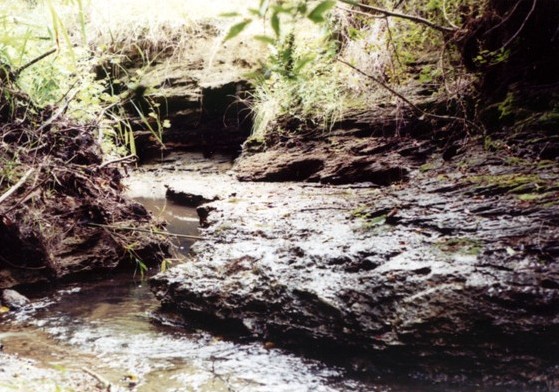
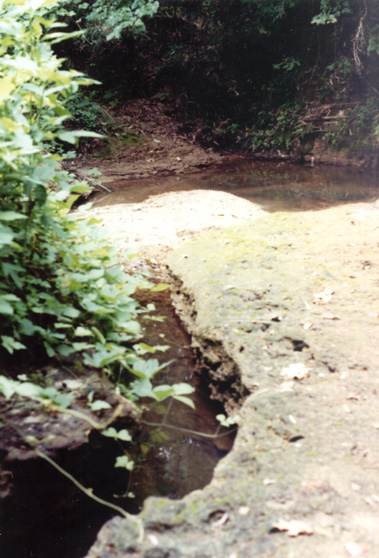
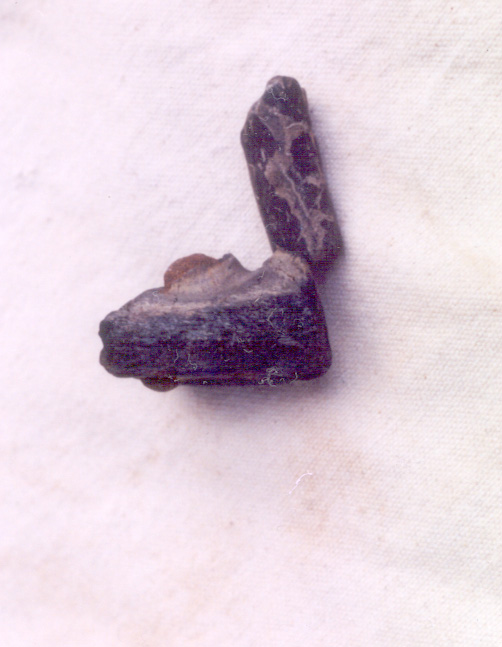
Another jaw part with portion of tooth.
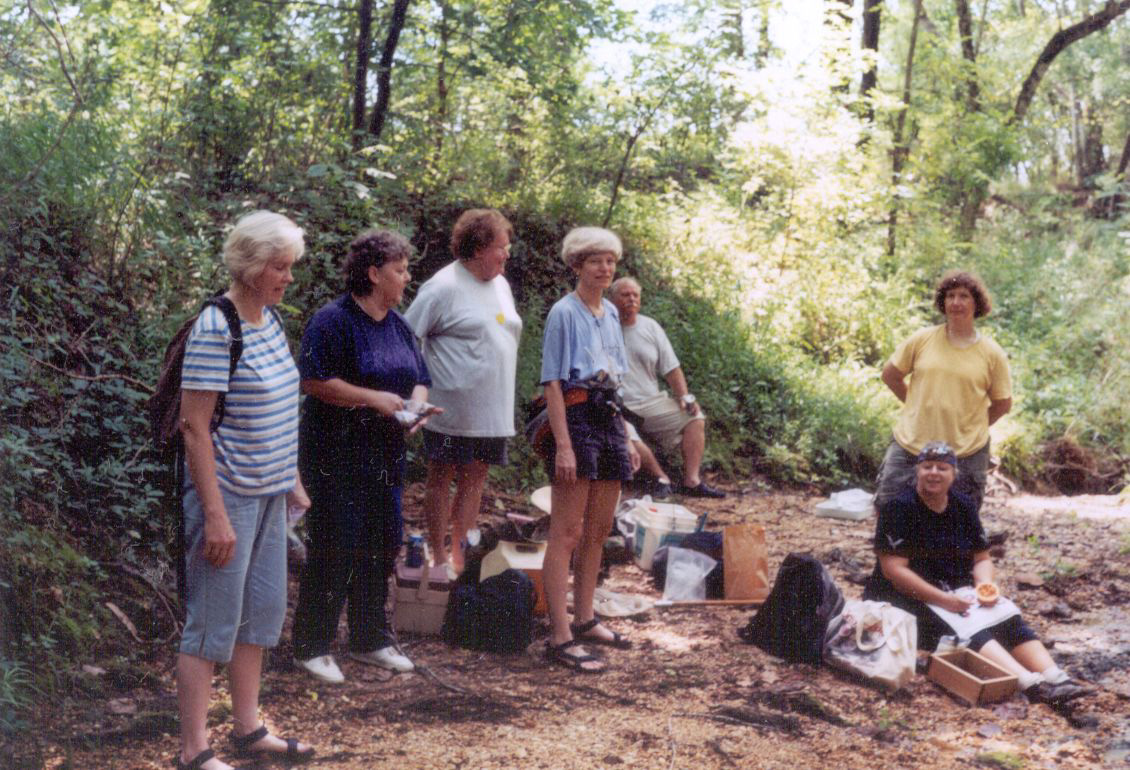
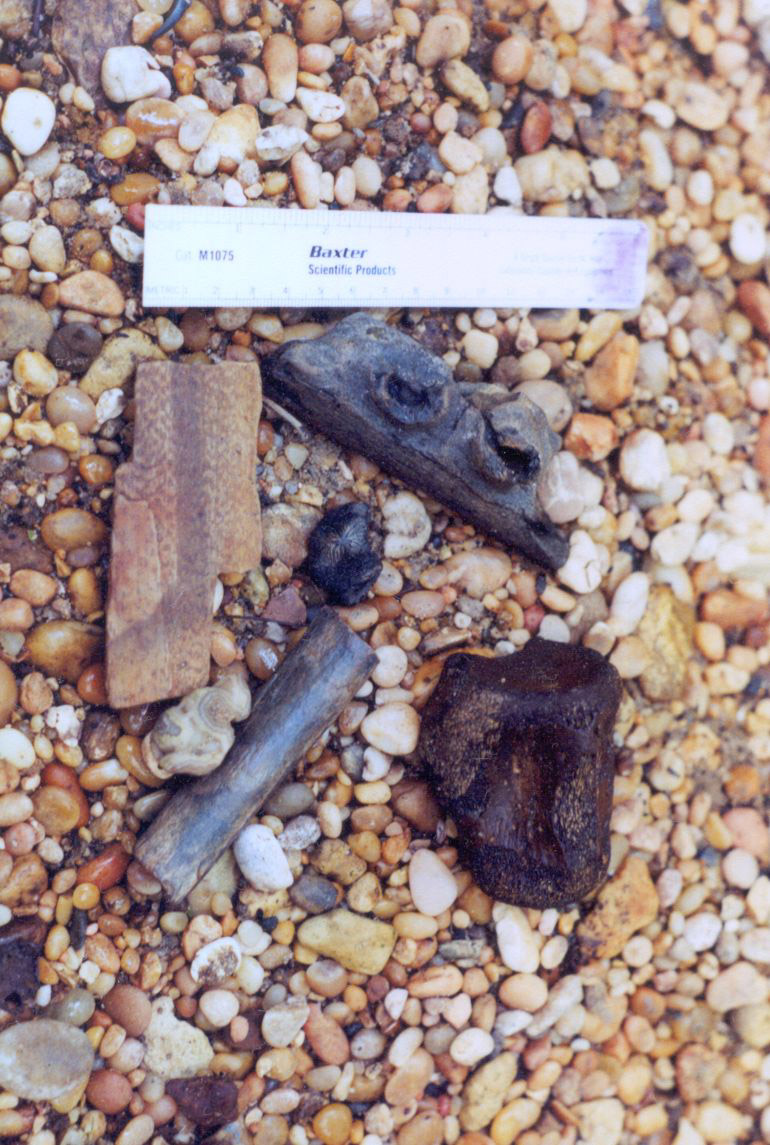
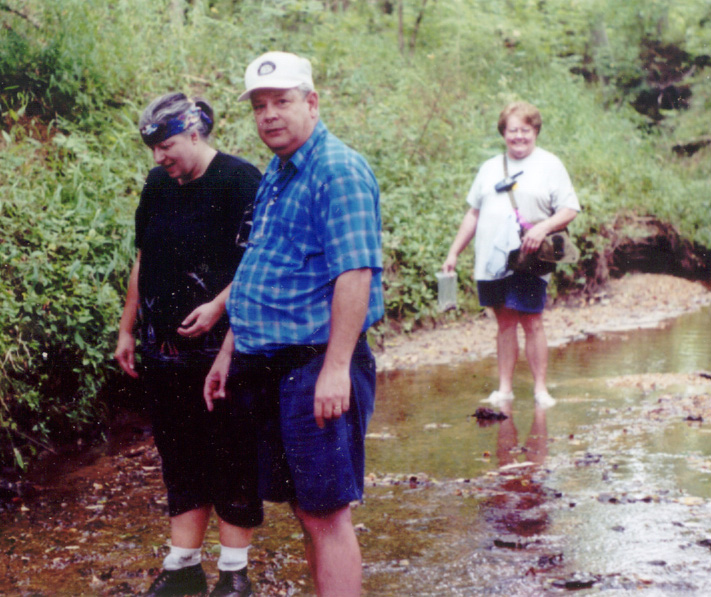
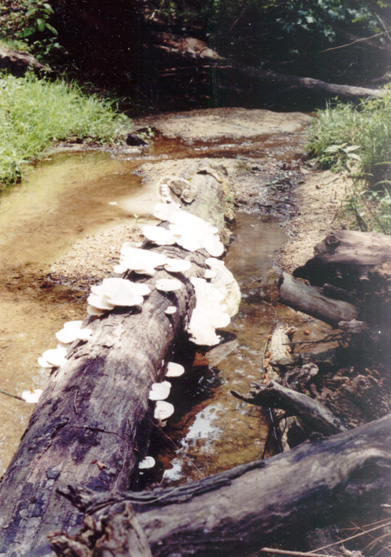
Way down the creek. Mooreville chalk can be found in this area.
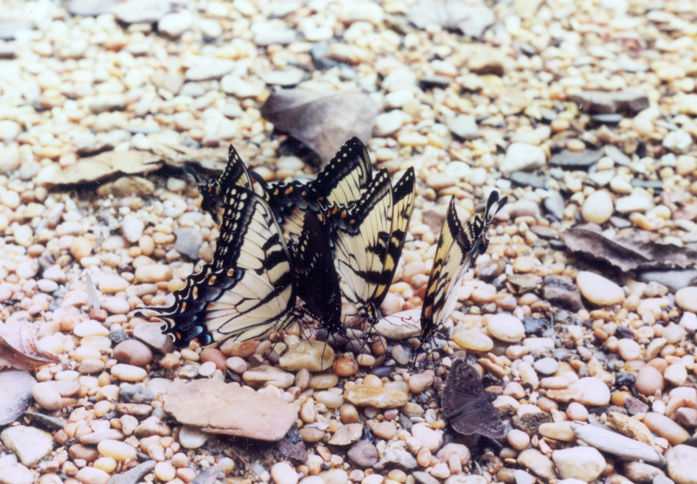
Department of Physics and Astronomy
University of Alabama
Tuscaloosa, Alabama
Edited by Vicki Lais
The field trip had two parts. First, we visited a well-known river site in Covington County where shark and ray teeth are present in great abundance, in the lower Tallahatta Formation. Then, we visited a small museum owned by a private collector near Andalusia, in Escambia County. The trip was attended by 20 BPS members and guests on a hot, but not so humid, mostly clear day.
 According to Dr. David C. Kopaska-Merkel of the Geological Survey of Alabama, the lower Tallahatta Formation is early Eocene, or about 50 million years old. He says that the formation is slightly younger than the famous Bashi Marl shell bed, and older than the even more famous Gosport Sand shell bed.
According to Dr. David C. Kopaska-Merkel of the Geological Survey of Alabama, the lower Tallahatta Formation is early Eocene, or about 50 million years old. He says that the formation is slightly younger than the famous Bashi Marl shell bed, and older than the even more famous Gosport Sand shell bed.
The site is a well-known collectors area that was visited by the BPS previously in August 1998. The site has mostly shark and ray teeth preserved in a gray sand on the bank of the Conecuh river. The area has been visited so much that large holes pocked the bank where people had previously searched. Apparently, there is some commercial interest in the area, with people digging for large teeth for jewelry to sell, and leaving the smaller items in "spoil piles" of mud. Many of the attendees searched these piles with some success.
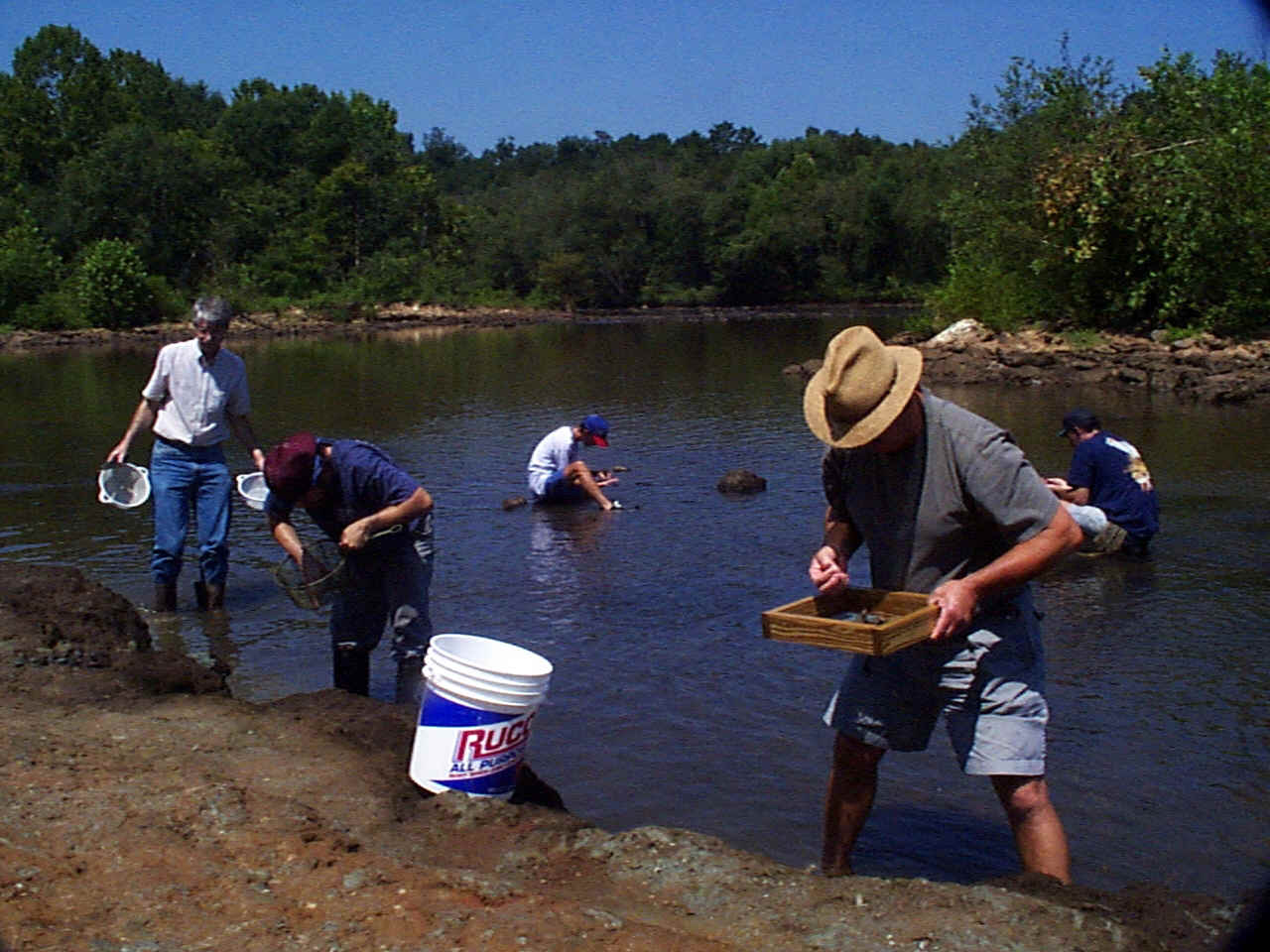 The most abundant fossils seemed to be teeth of sharks, with perhaps up to 11 species represented according to one collector, who told me that he visited the area about 3 times a month.
The most abundant fossils seemed to be teeth of sharks, with perhaps up to 11 species represented according to one collector, who told me that he visited the area about 3 times a month.
Dave Kopaska-Merkel told me that he found teeth of tiger sharks and at least 3 other kinds at this site, and saw a 5th kind. Most of the teeth I found seemed to be of the upper jaw variety, where there is a single broad cusp, at least two smaller accessory cusps, and a broad, symmetric root with a dip in the middle. These upper teeth are distinct from those of the lower jaw, which have a longer, narrower primary cusp, clear narrow ridges along this cusp, and a somewhat U-shaped root. No significant accessory cusps are usually seen on these teeth. I noticed that while most of these lower jaw teeth were black, some were actually light brown in color.
These are probably weathered examples, and often were missing part of the U-shaped root.
Next to the shark teeth, the most abundant teeth were those of rays. Unlike the shark teeth, which are also abundant at late Cretaceous sites in Greene County, the ray teeth seem to favor the Eocene site. On asking Dave Kopaska-Merkel about the difference, he offered the following speculation:
"I think most rays are bottom dwellers in shallow water, so if the Greene County site represents a relatively deep water deposit, then there might be relatively few ray teeth there. Also, I think ray teeth are slightly more fragile than shark teeth."
I am not sure what type of rays had the teeth we all found. Most of the ray teeth are elongated rectangles with narrow parallel ridges cut perpendicular to the long axis. At least one ray tooth that I found was notably curved.
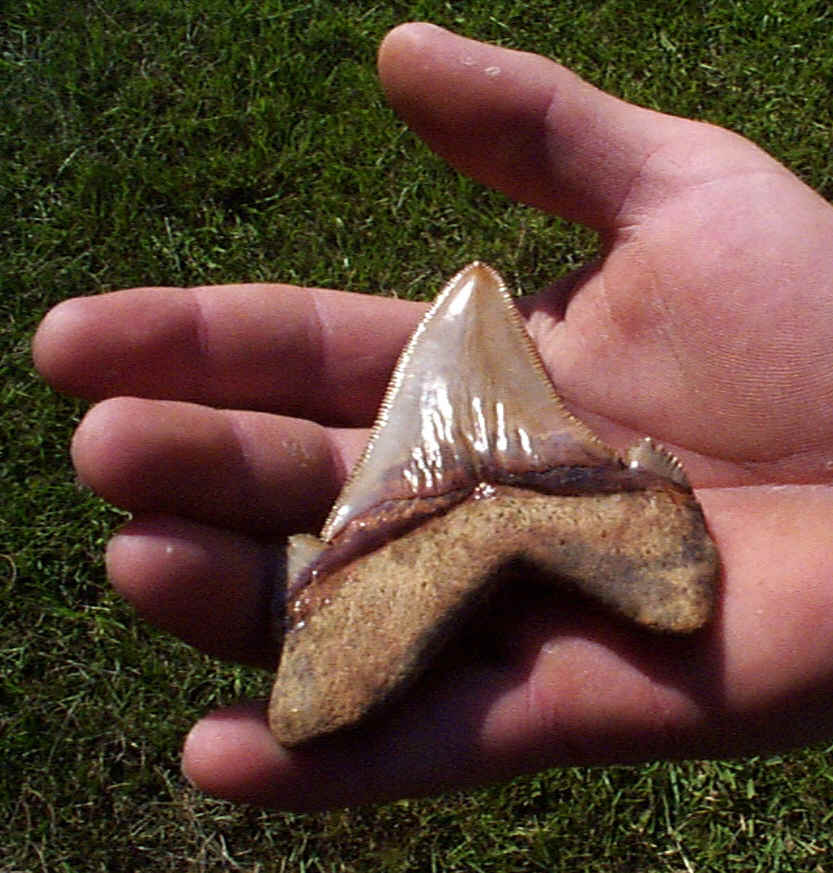
Certainly other types of fossils are represented among the hundreds of items people have been finding at this site. One attendee showed me what I think was a small part of a turtle shell, and several likely fish vertebrae were found, one with fragile stems still connected. Bone fragments, sawfish spines, and shark vertebrae were also found, the latter being distinctly circular and somewhat concave-shaped. Some fragile coral specimens were found that came from points higher up on the embankment, which exhibited abundant well-preserved burrows, according to Dave Kopaska-Merkel.
The high point of this field trip was without a doubt the BPS's visit to view the collection of shark teeth, marine organisms, marine mammal bones, and ice age fossils owned by Mr. Hoomes, a local contact.
Mr. Hoomes is an example of someone who developed a 21-year long interest in fossil collecting after a chance encounter with an unfriendly shark tooth in a creek near his parents home when he was 7 years old. While ambling around in the creek, he stepped on something sharp and thought he had cut himself on some glass. It turned out that he had stepped on an ancient shark's tooth, about one-half to one-inch long, that was standing roughly upright in the creek. (He now wears this tooth on a trademark hat.) He later did more exploring and discovered that shark teeth and other items had a habit of collecting into "potholes" around limestone embankments, and he became very good at recognizing the right places to look for such things. In two of his display cases, he had dozens of large shark teeth beyond anything which most of us had ever seen. To say it was merely an impressive collection of such teeth would be an understatement. Mr. Hoomes also had on display large whale vertebrae and jaw bones, probably from the same period as the sharks teeth.
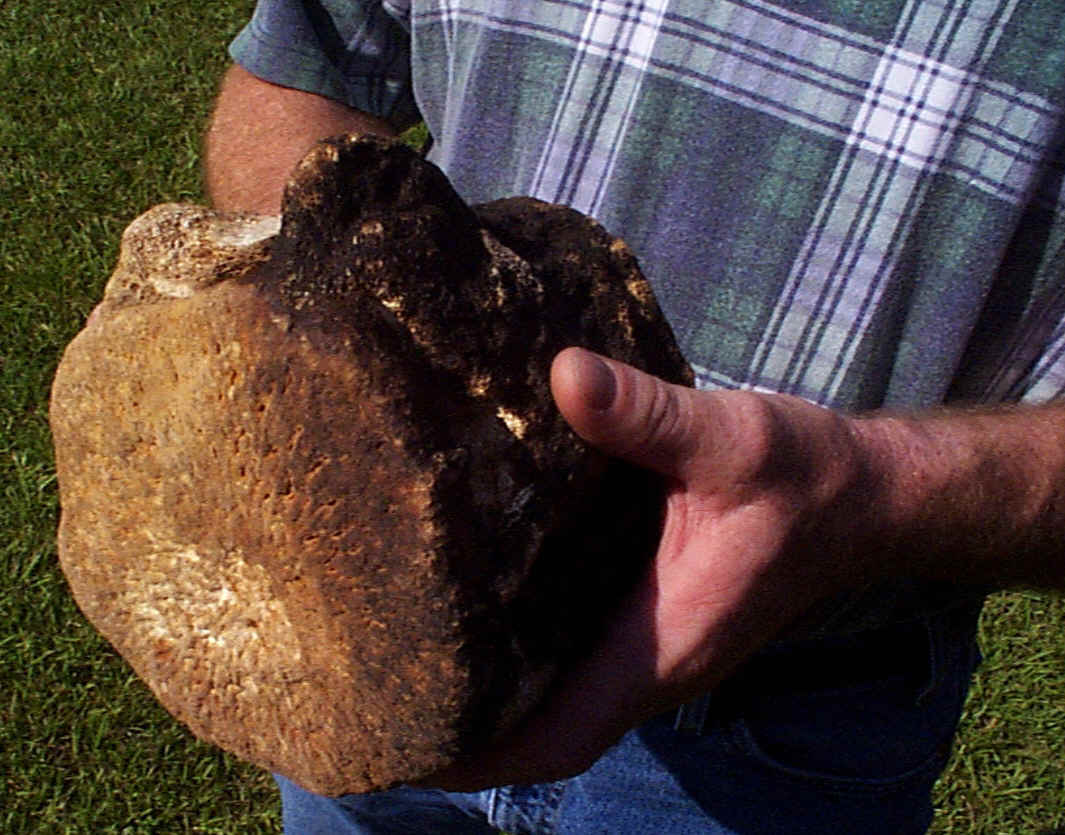
Especially interesting were Mr. Hoomes's ice age fossils. A humpless camel tooth, bison fossils, horse teeth, and many other items lined his many shelves. Mr. Hoomes also related to us his discovery of bones and stone implements at a likely "kill site" where early humans attacked and killed a mammoth. He showed us artifacts in the form of triangular bone fragments which had been made into likely primitive weapons by the ancient people of the area.
Mr Hoomes said he has explored many of the rivers within a five-county area around his home and his vast experience clearly showed in the things he told us.
His collecting has gone beyond what most of us do, and has included searches in remote creeks, not-easily-accessible embankments, and occasional encounters with alligators!
In summary, this was again an excellent field trip for the BPS. Thanks to James Lowery for arranging the trip, and thanks to Mr. Hoomes for taking us on a fascinating journey into Alabama's past! Thanks also to Dave Kopaska-Merkel of the GSA for his comments on this report, which improved its accuracy, and to Jim Lacefield for supplying all of the above images.
|
The three people in the foreground are James Lowery with his back to the camera, Jim Lacefield, seated, and Ron Buta, arms folded and deep in a serious discussion of paleontology. |
|
|
|
The Hensley Family |
|
David Kopaska-Merkel |
|
Henry Edmonson |
|
Ron Buta (facing the camera) |
|
David Shepherd |
|
Bill and Kate Newman |
|
Fossils found included sharks teeth, ray teeth, petrified wood, and vertebrae of sea snakes. The time period represented in the site we worked was the Eocene, the early age of Mammals, approximately 40-50 million years ago. From this site we proceeded to a private museum. A fascinating exhibit!
Richard Thurn of the University of West Alabama led the group of 18 members on an excellent day-long field trip to several sites in Sumter and Marengo counties. He started the day inside with a showing and explanation of the various fossils in the display cases at the science building on the campus of the University. The next two stops were at roadside chalk gully formations easily accessible and illustrative of the variety of fossils in the area representing Late Cretaceous snails and oysters.
The third stop was an optional one which everyone took advantage of: a trip to Moscow Landing on the Black Warrior/Tombigbee River, site of an outcropping of the K-T boundary. The chalk on the river bank was very slippery due to the recent rains, but, with the help of Richard's "always take it along on field trips" handy-dandy rope, the attendees was able to get to descend to the river's edge and to observe the K-T boundary. They also spent time collecting fossils in the Late Cretaceous and a few fossils from the Tertiary.
The last stop also was an optional one which 8 people took advantage of: a stop at a road cut on Highway 28 in Marengo County near Jefferson, Alabama. At this site there is an outcropping of the Tertiary and farther down the road there is an outcropping of the Late Cretaceous. The interesting feature of this site is that in between the two areas, there is a good outcropping of the K-T boundary. Additional collecting was done in the Cretaceous layers with everyone finding a good variety and quantity of representative fossils.